Dry sets in as El Niño breaks cover

THE first signs of an El Niño weather system are appearing, with dry conditions taking hold in some eastern regions.
“We’re getting close to an El Niño being announced. We’re seeing it more in the atmosphere than we did two months ago,” WeatherWatch head forecaster Philip Duncan said.
El Niño generally means wet conditions on the west coasts and dry in the east, and Duncan said that is occurring in pockets on both coasts and will strengthen through summer.
I think it is going to be a long irrigation season.
“It’s likely to be generally drier and warmer with more westerly weather conditions, but there are likely to be rainmakers coming through.”
NIWA reports this past winter was New Zealand’s fifth warmest since records began, and in many regions rainfall was below average.
Duncan is forecasting little rain and warm temperatures for most of the country for the next two weeks.
North Island eastern areas

that have endured 18 months of persistent wet weather are finally drying out but North Otago and parts of Canterbury had an extremely dry winter and have had little rain for six weeks.
North Otago Federated Farmers president Myfanwy Alexander said just 5mm has fallen in the past six weeks.
Irrigation started last month and warm temperatures have prompted pasture growth.
“I think it is going to be a long irrigation season.”
Irrigators in some districts began working as soon as temperatures warmed.
Coastal parts of South Canterbury are similarly dry, with local mixed cropping farmer and Federated Farmers national vicepresident Colin Hurst recording just 6mm for August and 238mm for the year to date, less than half the 600mm average rainfall for the region.
The conditions are not yet having an impact, but that could change without a decent rain, he said.
The clods are hard and cool, and spring soil temperatures are stunting growth in Canterbury.
Irrigators are working where they can while others are waiting for irrigation companies to crank up for the season.
“The winter was kind, but it was 23 July that we had our last decent rain. A bit of a shower would

Continued page 3
Subdued start to yearling bull sales
Te Atarangi Angus principal Chris Biddles keeps a wary eye on yearling Angus bulls as they go through the sale ring at Te Atarangi stud on the Pouto Peninsula, Northland.

MARKETS 8
QualityNZ bowls its way to high-end India
Former New Zealand cricketers Daniel Vettori, Brendan McCullum and Stephen Fleming, shareholders and ambassadors for exporting company QualityNZ, are as revered in India as they are in New Zealand.

MARKETS 10
NZ dairy exporters have claimed victory over Canada in their first CPTPP trade dispute.
MARKETS 3
A new report underlines the dairy industry’s importance as an export earner and job creator.
NEWS 7
An innovative Kiwi has developed the world’s first gelato made from upcycled kumara.
PEOPLE 20
Residential / Commercial / Rural / Property Services Country & Co in partnership with Bayleys 2023 Awards for Excellence in Real Estate MEDIUM RURAL OFFICE OF THE YEAR Bayleys Waikato 2023 Awards for Excellence in Real Estate LARGE RURAL OFFICE OF THE YEAR Bayleys Gisborne 2023 Awards for Excellence in Real Estate SMALL RURAL OFFICE OF THE YEAR Mike Fraser-Jones Bayleys Waikato 2023 Awards for Excellence in Real Estate INDIVIDUAL RURAL SALESPERSON OF THE YEAR Adam Whitelock Bayleys Canterbury 2023 Awards for Excellence in Real Estate RURAL SALESPERSON OF THE YEAR RISING STAR Karl Davis Bayleys Waikato 2023 Awards for Excellence in Real Estate OVERALL RURAL SALESPERSON OF THE YEAR If you want to work with the best people and achieve the best results for your property needs, choose the best in country. 0800 BAYLEYS bayleys.co.nz LICENSED UNDER THE REA ACT 2008 BAYLEYS COUNTRY – AWARDED 100% OF THE 2023 RURAL AWARDS BY REINZ 1
Vol 21 No 35, September 11, 2023 View online at farmersweekly.co.nz $4.95 Incl GST
Neal Wallace & Annette Scott NEWS Weather
Myfanwy Alexander North Otago Federated Farmers
Advertise Get in touch
EDITORIAL
Bryan Gibson | 06 323 1519
Managing Editor bryan.gibson@agrihq.co.nz
Craig Page | 03 470 2469 Deputy Editor craig.page@agrihq.co.nz
Claire Robertson
Sub-Editor claire.robertson@agrihq.co.nz
Neal Wallace | 03 474 9240
Journalist neal.wallace@agrihq.co.nz
Gerald Piddock | 027 486 8346
Journalist gerald.piddock@agrihq.co.nz
Annette Scott | 021 908 400
Journalist annette.scott@agrihq.co.nz
Hugh Stringleman | 09 432 8594
Journalist hugh.stringleman@agrihq.co.nz
Richard Rennie | 027 475 4256
Journalist richard.rennie@agrihq.co.nz
Nigel Stirling | 021 136 5570
Journalist nigel.g.stirling@gmail.com
PRODUCTION
Lana Kieselbach | 027 739 4295 production@agrihq.co.nz
ADVERTISING MATERIAL
Supply to: adcopy@agrihq.co.nz
SUBSCRIPTIONS
0800 85 25 80 subs@agrihq.co.nz
PRINTER
Delivered
our
SALES CONTACTS
Andy Whitson | 027 626 2269 Sales & Marketing Manager andy.whitson@agrihq.co.nz
Steve McLaren | 027 205 1456 Auckland/Northland Partnership Manager steve.mclaren@agrihq.co.nz
Jody Anderson | 027 474 6094 Waikato/Bay of Plenty Partnership Manager jody.anderson@agrihq.co.nz
Palak Arora | 027 474 6095 Lower North Island Partnership Manager palak.arora@agrihq.co.nz
Omid Rafyee | 027 474 6091 South Island Partnership Manager omid.rafyee@agrihq.co.nz
Debbie Brown | 06 323 0765 Marketplace Partnership Manager classifieds@agrihq.co.nz
Andrea Mansfield | 027 602 4925 National Livestock Manager livestock@agrihq.co.nz
Real Estate | 0800 85 25 80 realestate@agrihq.co.nz
Word Only Advertising | 0800 85 25 80 Marketplace wordads@agrihq.co.nz
PUBLISHERS
Dean and Cushla Williamson
Phone: 027 323 9407 dean.williamson@agrihq.co.nz cushla.williamson@agrihq.co.nz
Farmers Weekly is Published by AgriHQ PO Box 529, Feilding 4740, New Zealand Phone: 0800 85 25 80 Website: www.farmersweekly.co.nz
ISSN 2463-6002 (Print)






ISSN 2463-6010 (Online)

New Zealand’s most trusted source of agricultural news and information
News in
brief
Fonterra falls
Fonterra has fallen three places to ninth in Rabobank’s annual Global Dairy Top 20 report as it continues to dispose of noncore assets while adjusting to pressure on milk volume growth.
Fonterra sold its Chilean subsidiary Soprole in early 2023, resulting in an estimated drop in revenue of about $1.3 billion. French company Lactalis held the top spot on the Global Dairy Top 20 and Dairy Farmers of America in the United States moved up to second place, pushing Nestlé (Switzerland) into third.
Petrol answers
The Commerce Commission is asking fuel companies to explain why prices at the pump vary so much among fuel stations.
Chair John Small has written to all the major fuel companies asking them to explain “concerning” differences. He said that in the quarterly fuel monitoring report in March there were differences in price for which there was no clear explanation.
RESOURCES: The resources to improve on-farm safety are there, Agricultural Leaders’ Health and Safety Action Group chair Lindy Nelson says, ‘and we need the willingness to change to be there’. STORY P12
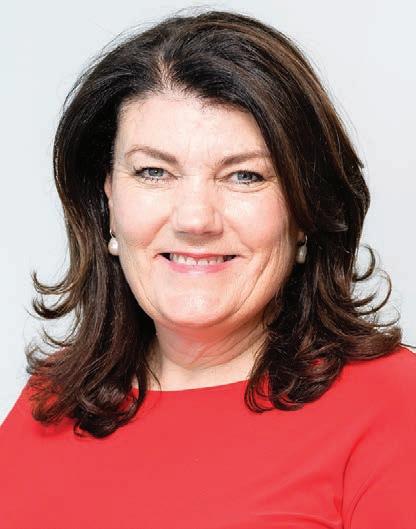
The Waikato Regional Council undertook 571 inspections of the 3900 dairy farms in its region last season, resulting in 46 abatement notices, 66 formal warnings and 12 infringement notices for breaches under the Resource Management Act for dairy effluent discharges.
Five court actions were also completed in the 2022-2023 season. WRC compliance manager Patrick Lynch said it had not been an exceptional year for compliance levels.
Dairy breaches Board nominations
Elections for DairyNZ’s board have attracted 13 dairy farmer candidates to contest the two positions that are up for grabs this year.
Voting by levy-paying dairy farmers opens on September 11 and closes on October 10. DairyNZ levy payers will receive a vote pack in the mail and can vote online or by post.
Back in 1860, exporting meat to the other side of the world seemed about as easy as nailing gravy to the ceiling. But a few determined kiwis took the bull by the horns and now our grass-fed beef and lamb is sought-after all around the globe.
At AFFCO, we see the same pioneering spirit alive and well in farmers today. We’re playing our part too – exploring every opportunity to take New Zealand’s finest farm-raised products to the world.
WWW.AFFCO.CO.NZ 0800 233 2669
WAVE200472 AFFJ200472 NZ Farmers Weekly Strip Ad FA.indd 1 24/08/22 3:22 PM 2
pioneering spirit tells us nothing’s out of reach
Contents
News . . . . . . . . . . . . . . 1-15 Opinion . . . . . . . . . . 16-19 People . . . . . . . . . . . . . . 20 Technology . . . . . . . . . . 21 Federated Farmers 22-26 Real Estate . . . . . . . 29-30 Marketplace . . . . . . 31-32 Livestock . . . . . . . . . 32-37 Markets . . . . . . . . . . 38-43 Weather . . . . . . . . . . . . . 44
Printed by Stuff Ltd
by Reach Media Ltd
Win for NZ and the process in Canada call
Richard Rennie MARKETS Dairy
NEW Zealand dairy exporters can claim a solid victory after a ruling in their favour in a dispute with Canada over how that country manages the entry of trade partners’ dairy products to its market.



As a CPTPP (Comprehensive and Progressive Agreement for Trans-Pacific Partnership) partner, Canada is obliged to allow a portion of NZ dairy products into its market through a quota allocation.


But NZ exporters found Canada was blocking access to its domestic dairy sector, and last year it initiated formal dispute proceedings.
Vangelis Vitalis, deputy secretary for the Ministry of Foreign Affairs and Trade, said the decision made by the three-member review panel in favour of NZ is a clear one, and Canada has to change.
Estimates are about $120 million
Continued from page 1
be good again now,” Methven cropping farmer Darrell Hydes said.

If there is no rain soon, cropping farmers will be starting irrigators to wash in pre-emergence spraying of crop nutrients and to break up clods. If the norwest wind continues as it has this week, Mid Canterbury Federated Farmers dairy chair Nick Giera said, irrigators will be coming out.

“Some have started now. Any rainfall has been fairly localised so


























of dairy sales were affected by the Canadians’ blocking move over a period of three years.

Canada was not financially penalised for its actions, but the country is compelled under CPTPP rules to cease and desist, and fall into line with the agreement’s principles.
The decision marks the first time NZ has initiated a dispute under the CPTPP agreement.
The three panellists determined that Canada is not allowed to favour its domestic industry, that access to quotes must not be compartmentalised in any way, and that Canada cannot exclude retailers from accessing quotas. There could also be no priority access granted to dairy quotas domestically.
The total Canadian dairy import market is estimated to have averaged $2 billion a year for the past five years, compared to $2.4bn for Mexico and $4.2bn for Japan, both also signatories to the CPTPP.

The quota volumes under the CPTPP allocation are 93,166t, with

coastal areas had some spring rain earlier that farmers higher up the plains missed out on.”
In the North Island a month of dry weather has been welcomed by farmers from Wairarapa to the east coast.
David Hayes, the federation’s Wairarapa president, said spring has been favourable and after a tough winter following a wet year, pasture is responding.
Jim Galloway from Hawke’s Bay said after a similarly tough 18 months, August was dry, which provided some relief.
These are hard-won negotiated outcomes and today’s ruling will give exporters confidence and certainty the mechanisms in place will ensure they receive the market access all members agreed to.
Damien O’Connor Minister for Trade and Export Growth
the bulk of 50,000t being liquid milk. Skim milk powder amounts to 7500t, yoghurt-buttermilk 6000t

Parts of Hawke’s Bay have had 2m of rain so far this year following 1800mm last year.
Cropping farmers have enjoyed dry conditions to sow crops, a contrast to last year when it was extremely wet.
Galloway said El Niño conditions will be difficult for farmers.
“It would be another smack around the ears. We’ve had a tough winter, livestock prices are not flash and if it gets dry, it will make it hard.”



Further north, around Ruatoria, conditions are cooler than ideal
and industrial cheese 7975t.

Canada’s total dairy market is estimated to amount to 9.3 million tonnes of dairy, compared to 9.6 million tonnes in Japan and 16 million tonnes in Mexico.



The Ministry of Foreign Affairs and Trade was unable to provide information on how much of the quotas NZ fills in comparison to other members.
Trade negotiators have welcomed the dispute process as evidence that, despite the World Trade Organisation process having stalled as a disputes forum, it is still possible to continue to seek a rules-based approach under trade agreements.
and farmers are looking for some warm dry weather.
The federation’s GisborneWairoa president, Hunaara Waerehu, said there is sufficient feed but they would like some heat.
The sun has been welcomed in Manawatū after what Ian Strahan, the Manawatu-Rangitīkei Federated Farmers president, called one of the nastiest wet winters in recent years.
Subsequent warm, dry days have helped with calving and lambing and arable farmers are busy.
Vitalis noted NZ and Canada continue to have a strong friendship and said the dispute proves the CPTPP has a viable forum for resolving them.
Minister for Trade and Export

Growth Damien O’Connor welcomed the ruling in NZ’s favour, calling it a significant win for primary sector exporters.

He said since 2017 government has signed seven new or upgraded FTAs.
“These are hard-won negotiated outcomes and today’s ruling will give exporters confidence and certainty the mechanisms in place will ensure they receive the market access all members agreed to.”
Parts of Waikato are still struggling from low grass covers, with some dairy farmers milking once a day.


The region’s Federated Farmers president, Keith Holmes, said farmers have struggled all year to try to build up a pasture bank or fund the purchase of supplementary feed, and that shortage is plaguing some areas.
Feed supplies in mid-September are considered a marker for the start of the season, and Holmes doubts they will be at an ideal level.
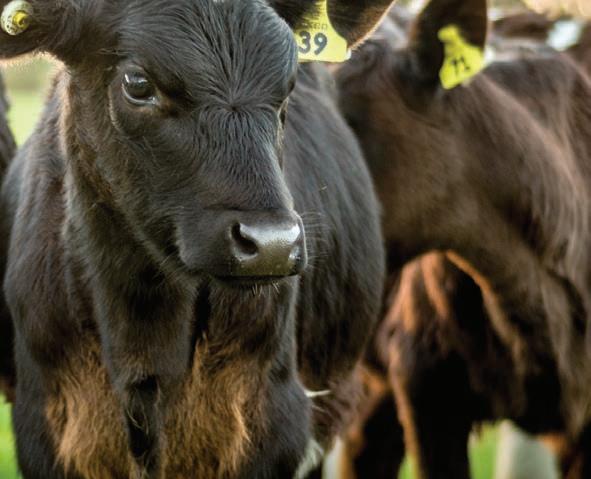
PROUDLY NZ OWNED alleva.co.nz TURBO® is a registered trademark of Alleva Animal Health Ltd. TURBO Initial (A011703) is a registered pursuant to the ACVM Act 1997. See www.foodsafety.govt.nz for registration conditions. INITIAL Stage one of the TURBO 3-stage Cattle Drench Programme. Exclusive to veterinary practices nationwide. THE PROVEN WAY TO WEAN. COMBAT Parasites + Coccidiosis in a single dose 3 FARMERS WEEKLY – farmersweekly.co.nz – September 11, 2023 News 3
MILKED: The CPTPP disputes panel found in favour of NZ’s claim that Canadians were blocking the inclusion of NZ dairy products in favour of domestic products, contrary to CPTPP requirements.
Red wave on the retreat in the provinces
IN OCTOBER’S general election the National Party expects to regain most of the rural and regional electorates it lost to the incumbent Labour government in 2020.



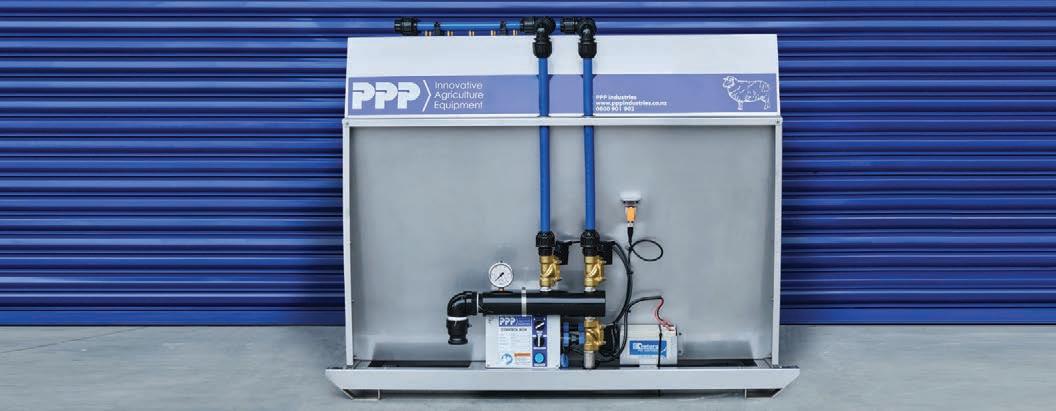
Based on current polling, National may return to holding at least two-thirds of provincial electorate seats, compared with one-third after then-prime minister Jacinda Ardern led Labour’s red wave to a sweep of the country.
In 2017 National won 45% of the party votes and had 55 MPs, before being left out of coalition government by NZ First and Labour, only to crash to 25% and 33 MPs in 2020.
Recent polls indicate it could have 45-47 MPs and be in a position to form a government with the high-flying ACT Party after October’s election.
National went into the 2020 election with a 10-to-one advantage over Labour in the rural and regional electorates.
It had vote majorities as high as 19,500 in predominantly rural seats like Selwyn, where Nicola Grigg took over from Amy Adams for National, but her majority was cut by two-thirds.
Eleven out of 26 rural and regional electorates were flipped from National to Labour: Northland, East Coast, Hamilton East, Hamilton West, Nelson, New Plymouth, Ōtaki, Rangitata, Tukituki, Wairarapa and Whanganui.
These were seats in which National had majorities of 20008000 votes in 2017.
Hamilton West has since gone back to National in a by-election. For the general election, in order of winnability for National, the




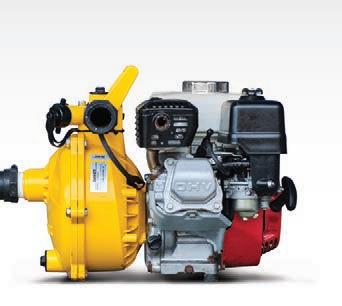

electorates most likely to come back from Labour are Northland, Whangārei, Tukituki, New Plymouth, Hamilton East, Ōtaki, Rangitata and Nelson.
In these electorates, approximately 200-2500 voters switching their votes from Labour to National would result in a change in representation.
Geographically, north to south, National expects to win back Northland, East Coast, Hawke’s Bay and Wairarapa, Taranaki and Whanganui, Nelson and Rangitata, all being traditional stronghold regions.
Financial consultant Blair Cameron is No 35 on National’s list and will be trying to win back Nelson from Rachel Boyack, ranked 42 for Labour and with a 4525-vote majority in 2020.
National Party leader Christopher Luxon has been touting the diversity of National’s list, and this has made for some interesting dynamics.
For example, National has 11 male candidates in rural and regional electorates who need to win to be assured of entering parliament because they are placed well down the party list.
Five are sitting MPs: Joseph Mooney, Invercargill (53 on the list), Scott Simpson, Coromandel (55), Stuart Smith, Kaikoura (56), Sam Uffindell, Tauranga (57) and Tim van der Molen in Waikato (58 on the list).
Six are candidates who have not been MPs before: Miles Anderson, Waitaki (59), Mike Butterick, Wairarapa (61), Tim Costley, Ōtaki (64), Ryan Hamilton, Hamilton East (66), David MacLeod, New Plymouth (67), and Grant McCallum, Northland (68).


National’s approach is to assume these 11 men will win their seats, allowing room for diverse candidates higher up the list.
For example, candidate Dana

Kirkpatrick (at 44) is contesting East Coast against Tāmati Coffey, who had resigned from Parliament – until Kiri Allan also resigned and Coffey was persuaded by Labour to stand.
In each of eight electorates, between 200 and 2500 voters switching from Labour to National would bring back National’s rural and regional domination.
Four further women are high up on National’s list and are set to make it to Wellington: Nicola Grigg, Selwyn (19), Suze Redmayne, Rangitikei (21), Maureen Pugh, West CoastTasman (26) and Barbara Kuriger, Taranaki-King Country (36). Only Redmayne is not a sitting MP. She is assured of inaugural
success however the votes fall in Rangitikei, where former Federated Farmers president Andrew Hoggard is also running for the ACT Party.
He, too, will likely be going to Wellington on the strength of his No 5 placing on ACT’s list.
ACT agricultural spokesperson Mark Cameron, a dairy farmer in Northland, is also expected to return because of his seventh placing.
For Labour, the rural and regional MPs most assured to return to Wellington should they lose their electorate races are four cabinet ministers: Willow-Jean Prime, Northland (9), Damien O’Connor, West Coast-Tasman (10), Kieran McAnulty, Wairarapa (16), and Rangitata MP Jo Luxton (19), plus possibly Waimakariri candidate Dan Rosewarne (32) and Taranaki-King Country candidate Angela Roberts (35).
Further down Labour’s list are four women MPs facing do-or-
die battles in their electorates: Anna Lorck, Tukituki (40), Angie Warren-Clark, Whangārei (43), Terisa Ngobi, Ōtaki (46) and Steph Lewis, Whanganui (50). These list placings will not be successful, going by Labour’s current polling.
NZ First has three candidates standing in provincial electorates who are high on the party’s list and may make it to Wellington if NZ First achieves 5% party vote and re-enters parliament. They are deputy leader Shane Jones, Northland (2), Marlborough District councillor Jamie Arbuckle, Kaikoura (5), and former MP, Otago farmer and agriculture spokesperson Mark Patterson, Taieri (6).
Businesswoman Helma Vermeulen in Whanganui is at No 10 on the NZ First list. Next highest-ranked candidate in a regional seat is Robert Ballantyne, Rangitata (12), a former farmer and businessman.
4 FARMERS WEEKLY – farmersweekly.co.nz – September 11, 2023 News 4
Hugh Stringleman POLITICS Analysis
NUMBERS UP: Based on current polling, National may return to holding at least two-thirds of provincial electorate seats.
SFF estimate ‘suggests market confidence’
of a significant drop in sheepmeat prices from last year.
THE upper range of new season lamb price forecasts announced by Silver Fern Farms suggests some market confidence, an AgriHQ analyst says.
Silver Fern Farms is forecasting a farm gate price range for lamb from now until December of $6.90 to $7.30/kg, but AgriHQ senior analyst Mel Croad said the top end of that forecast suggests a lift in prices from current levels.
This week’s AgriHQ prime lamb indicator price is $6.95/kg in the North Island and $6.90/kg in the South Island.
Croad said prices normally peak through September-December and ease as more lambs become available, but the upper range of those indicative prices suggests some potential market upside.
SFF is the only meat company so far to publicly release its forecast, which confirms earlier warnings
Its forecast for mutton through to December is $3-$3.80/kg, prime beef $5.30-$6.30/kg, bull $5.20$6.20/kg and cow $3.60-$4.30.
Chilled venison prices are forecast at $9.75-$10.30/kg and frozen $8.70-$9.20/kg.
Additional programme premium payments will be made where applicable.
SFF chief executive Simon Limmer told suppliers in a newsletter about challenges across all markets from low demand, high inventories and increased production out of Australia and Brazil in particular.
“We’re cautiously optimistic prices have bottomed out for beef, but things are still very challenging for lamb,” he said.
“Our forecast pricing reflects where the markets are at right now, however we are suffering somewhat of a perfect storm and we are experiencing quite a correction.”
Limmer remains optimistic that
underlying demand for red meat protein will continue to grow but said the recovery, especially for lamb, is dependent on China. Meat companies have noticed small improvements in demand for lamb from China, but the SFF forecast is substantially below last season’s industry average opening
price of $8.74/kg, which reflects current weak international demand and prices and Australian lamb flooding markets.
Croad has major concerns about mutton. In August Australia shipped 132,000t – 50% more than for the same month last year – of which 44% went to China, NZ’s
main export market. A year ago the Australian mutton price was $AUS5.20/kg ($5.64) but this week it had collapsed to $AUS1.88/kg ($2.04).
Forecast prices could be optimistic, Croad said.
“To get $3.80/kg at some point between now and December could be a tough ask.”
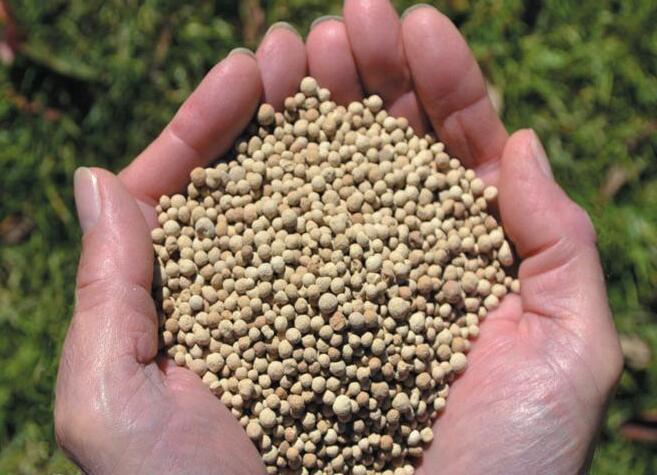
Croad said low sheepmeat farmgate prices in Australia mean exporters are selling at prices lower than NZ, which undercuts our markets.
She said forecast beef prices appear accurate but notes there has been some procurement pricing in recent weeks as the flow of stock has slowed due to low grass growth, especially in the North Island.
SFF livestock manager Jarrod Stewart said in a podcast that while these prices reflect current markets and trends, there is still plenty of uncertainty, especially with lamb. There are “small signs of life” for lamb in China, but he described the general outlook as “gloomy”.
Healthy $10 tag has venison prospects looking up
There are also solid sales in China and North America as the food sector recovers, and retail is growing.
VENISON markets are tracking up, sparking cautious optimism in the deer industry.

While for much of the year the venison price has held stable at just under $9 a kilogram, a positive forecast indicates it will hold out at above $10 through until the end of 2023.
Deer Industry New Zealand (DINZ) chief executive Innes


Moffat said all top five companies are above $10 for chilled product through September and October. This is up on the price of around $9 this time last year.
While the processors each have their own strategies and plans, Moffat said they are all in the same ballpark with the higher pricing consistent across the markets and a reflection of good demand for European chilled product.
“Demand from the growing United States and other markets such as China continues to mitigate seasonal reliance on Europe.
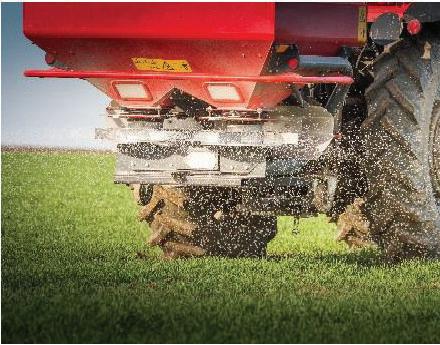
“Companies are looking to build on the returns we are getting with the opportunity to add more value into co-products helping to get improved overall carcase value.
“This means a higher, more stable schedule and return back to farmers.”
John Sadler of Canterbury-
based Mountain River Processing said the markets are stable and demand is good for NZ venison but unfortunately quantities are reduced.
“We have got good solid markets for the product and markets are growing but with a production decrease, supply and demand will need to be carefully managed.
“Our chilled contract pricing is clearly over the $10 mark and we are aiming for $9.50 as our premium schedule price though until the end of May 2024,” Sadler said.

Duncan NZ marketing manager Chris Duncan said as venison markets continue to recover, chilled European prices have improved on last season.
“The US market remains stable with venison pricing and demand holding steady, amidst challenging market conditions that have seen beef and lamb prices soften in recent months.
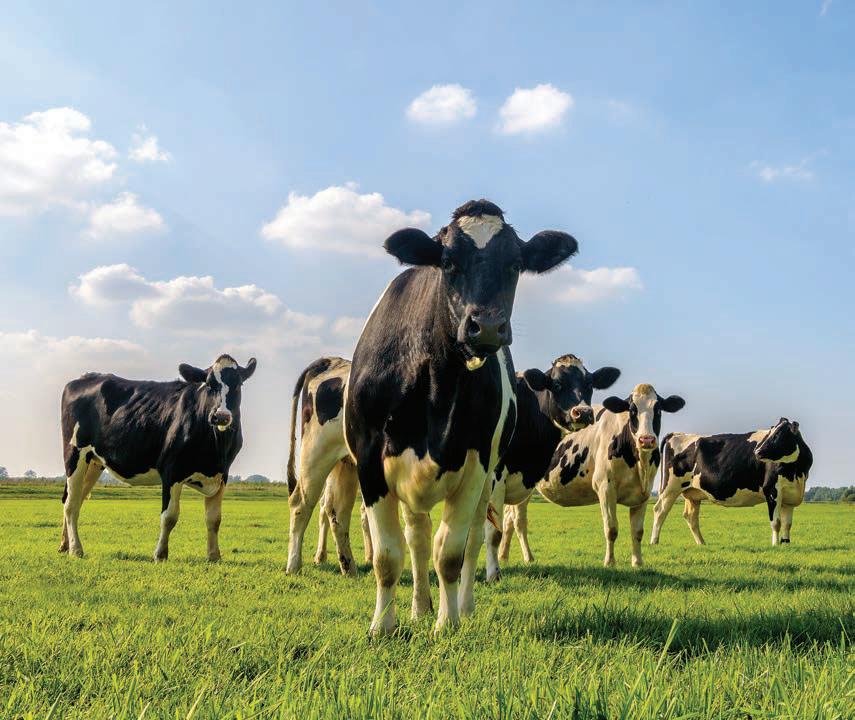
“Our venison pricing is in line
with the current markets,” Duncan said.
Venison processors are generally working on a current chilled price range of $9.75-$10.30 and forecasting opening season schedule pricing from $8.70-$9.20.
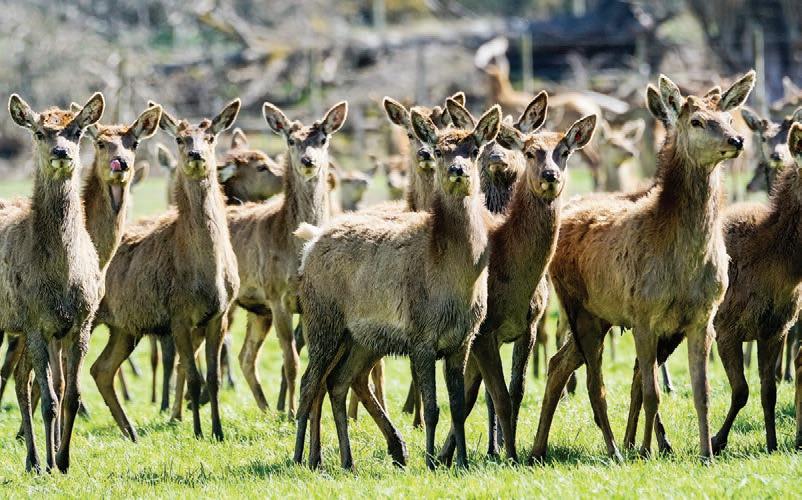
Silver Fern Farms general manager livestock Jarrod Stewart said there is still uncertainty around the current trends with some challenges across key markets.
Sales for the European chilled game season production period have concluded, at least for those volumes heading to market via sea freight.
“We continue to concentrate our efforts on procuring interest and sales for the airfreight supply period.”
With the availability of flights and the costs of airfreight improving, customers are looking harder at this as an option to increase their chilled volumes to service this consumption period.

C M Y CM MY CY CMY K Farmers Weekly NZ Sep2023 ai 1 6/09/2023 2:27:57 PM Farmers NZ_Sep2023.ai 1 6/09/2023 2:27:57 PM 5 FARMERS WEEKLY – farmersweekly.co.nz – September 11, 2023 News 5
OPTIMISTIC: SFF CEO Simon Limmer told suppliers he remains optimistic that underlying demand for red meat protein will continue to grow.
TRENDING: There are solid venison sales in China and North America as the food sector recovers.
Neal Wallace NEWS Lamb
Annette Scott MARKETS Deer

Who can you rely on to help make sure spring springs? N-Protect makes every bit of spring nitrogen fertiliser count, boosting growth and reducing volatilisation losses. Talk to us about protecting your investments today on 0800 100 123. 6
One in four NZ export dollars earned by dairy
Gerald Piddock NEWS Dairy
ANEW report on the New Zealand dairy industry highlights its crucial importance to the national economy as an export earner and job creator.
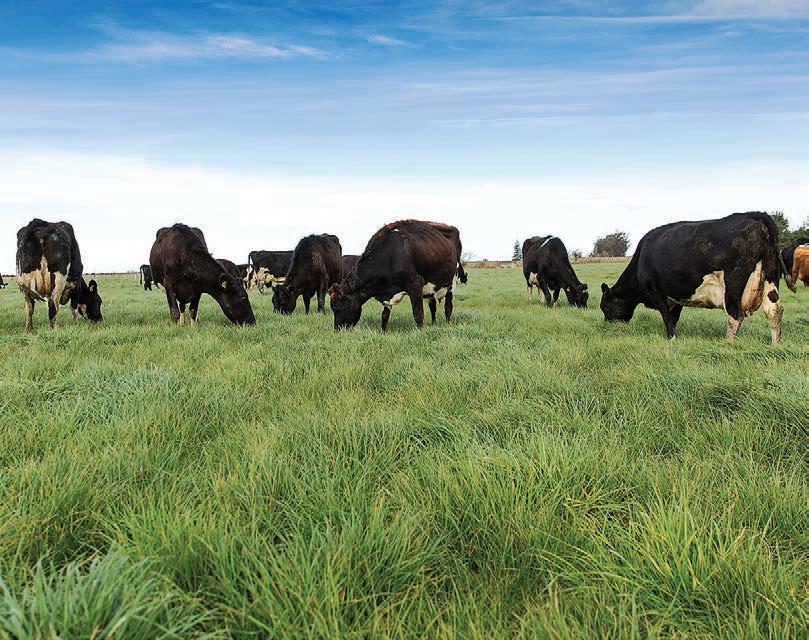
The industry is NZ’s largest goods producing sector, accounting for $11.3 billion (3.2%) of GDP in the year to March 2023, the report, Solid Foundations –Dairy’s Economic Contribution to New Zealand, says.
Of this, dairy farming contributes $8bn (2.2% of GDP) and dairy processing contributes $3.4bn (0.9%).
The report was produced by Dairy Companies Association of New Zealand (DCANZ) and DairyNZ.
DCANZ executive director Kimberly Crewther said the report shows the long-term picture for the dairy sector is solid and it will continue to contribute significantly to the NZ economy.
“Dairy generated nearly $26 billion in export revenue for the year to April 2023, which accounts for around one in every four export dollars earned by New Zealand,” Crewther said.
“The value of dairy exports grew by 45% over the past five years, which helped support the national economy through the pandemic.”
DairyNZ head of economics












Mark Storey said the spread of farms across the country allows dairy to support regional economies, maintaining some local spending even when milk prices drop.
“Dairy’s export earnings translate into well-paying jobs in the sector and enable the purchase of goods and services from other sectors.
“There will inevitably be an impact from the recent fall in milk price, with farmers limiting nonessential expenditure and limiting their purchases short-term where possible. However, this analysis shows that the sector itself absorbs some of the impacts in dairy farmers’ profits.
The value of dairy exports grew by 45% over the past five years, which helped support the national economy through the pandemic.
Kimberly Crewther DCANZ
“Despite lower milk prices, dairy farmers will continue to hire staff and purchase essential supplies to run their farms.”
The industry is also a cornerstone employer in many regions.
In Waimate, one in three jobs are in the dairy sector – and it’s one in
four in South Taranaki, one in four and a half jobs in Westland, one in five in Southland and one in six in Matamata-Piako.
“It’s hard to imagine some of these rural economies without dairy in place. They would look very different,” said John Ballingall of Sense Partners, which authored the report.
The report also highlighted the contribution Māori agribusiness plays, owning around $4.9bn in assets in the dairy sector.
According to Statistics New Zealand, businesses operated by Māori authorities exported $207 million in milk powder, butter and cheese in 2021.
This was an increase of 35.3% on 2020. Farms operated by Māoriowned businesses made up 3% of total farmland. The average size of each farm, at 569ha, was 3.8 times larger than the NZ-wide farm average of 148ha.
Māori-owned farms made up 1.4% of the dairy herd – 87,900 head of cattle, of which 72,100 were milking cows and heifers.
Employment-wise, the dairy sector sustained 54,787 jobs as of March 2023, with 38,462 on farm and 16,325 in processing.
Māori made up 16.5% of dairy farming employees and those who are self-employed, up from 12.7% in 2015. The number of Māori employees has risen from 3693 in 2015 to 4040 in 2021.
The report showed the value of dairy exports had risen 45%
($7.9bn) in the five years to April 2023, and now tops $25.7bn. The industry generates more than one in every four dollars of NZ’s foreign exchange receipts from goods and services exports.







It is NZ’s largest goods exporter by a significant margin, accounting for 35% of goods exports.
Individual dairy products are larger than many other export sectors.
WMP, at 31.6% of dairy exports by value, remains the industry’s largest dairy product export followed by butter and dairy spreads at 17.7%, protein products at 13.2% and cheese at 11.1%.
With a combined $4.6bn in exports, butter, AMF and dairy spreads alone account for more than horticulture ($3.8bn) and wine exports ($2.8bn).
NZ exports dairy products to more than 140 markets and is less concentrated in major markets
than commonly perceived, with 54.1% of dairy sector exports sold to its top five markets – China, Indonesia, Australia, the United States and Japan.
This is the lowest concentration of NZ’s top 10 export sectors by some margin.
Much of the global dairy market remains highly constrained by tariffs: 56% of global dairy consumption takes place behind tariff barriers greater than 20%, and 87% of dairy consumption is behind a barrier of 10% or more.
While NZ’s bilateral and regional trade agreements have been highly beneficial, a range of tariffs still apply to dairy exports under them. The report estimated tariffs paid on dairy exports to NZ’s top 20 markets are around $1.5bn.
In addition, the report estimates non-tariff measures impose costs of around $7.8bn on NZ dairy exports.
Govt urged to keep up momentum on trade
Dairy’s economic contribution to NZ, highlights the significant trade barriers NZ’s dairy industry faces in getting its product to market.
DCANZ executive director
Kimberly Crewther is urging the new government not to let New Zealand rest on its laurels when it comes to further trade liberalisation in the dairy global export market. There needs to be ongoing investment in maintaining momentum, she said, speaking in a webinar following the launch of a report by Sense Partners commissioned by DairyNZ and DCANZ (Dairy Companies Association of New Zealand). That report, Solid Foundations –
The next government will need to take a multipronged approach to address this, including maintaining and investing in new and existing trade relationships.
“Be ambitious, because an end point of tariff elimination is where we need to get to in those agreements,” Crewther said.
Recent news of progress towards an agreement with the United Arab Emirates means possible access to a $600m market.
“We’re paying around $35m in tariffs there – it’s only a small tariff, but that adds up,” she said.
The more incremental gains that can be made by extending trade, the better, Crewther said. India and the United States are significant gaps in the market for NZ dairy products. Current trade is limited to a narrow range of products and being able to lift some of the barriers and broaden access would give exporters more options.
There is also a degree of “unfinished business” in some existing trade agreements, such as those involving Japan and the European Union.
“Those agreements all have upgrade provisions over time and it’s important that we be ambitious in what we are seeking
for those upgrades,” Crewther said.








“Those are developed markets, developed countries and G7 countries, and the United Kingdom agreement showed that it’s no longer a defence for G7 countries to say they can no longer liberalise their dairy market.”
NZ also needs to use the mechanisms in the agreements to make sure they improve over time.
“For that eye-watering $7.8 billion of non-tariff barriers, we have got trade agreement structures that have mechanisms to be able to advance discussions around bringing those down, so let’s make sure that we’re actively using those mechanisms.”

Around 56% of global dairy
consumption takes place behind average tariff barriers of 20%, Sense Partners’ John Ballingall said.
“An even larger share – around 87% – takes place behind tariff barriers that average 10% or more.”





















































































Ongoing investment by the government leading to small decreases in trade barriers would support the industry’s export competitiveness.
Ballingall called India a “very big prize”, because of its population size and the extent of its trade barriers.

But it is a tough market to crack and needs to be seen as a longterm play.

Facial Eczema Three-Year Research Study www.beeflambnz.com/FEstudy Take part in groundbreaking Facial Eczema (FE) research by collecting sheep poo – it’s as easy as taking a walk in your paddock. The three-year study will help B+LNZ understand how widespread FE is in the North and South Islands and inform how we manage this disease in future. We want your
poo 7 FARMERS WEEKLY – farmersweekly.co.nz – September 11, 2023 News 7
sheep
BIG DAIRY: The industry is NZ’s largest goods producing sector, accounting for $11.3 billion (3.2%) of GDP in the year to March 2023.
Gerald Piddock MARKETS Trade
GDT prices offer first relief in months
 Hugh Stringleman MARKETS Dairy
Hugh Stringleman MARKETS Dairy
THE 5.2% rise in whole milk powder prices in the latest Global Dairy Trade auction was the first since mid-May and the beginning of the current New Zealand dairy season.
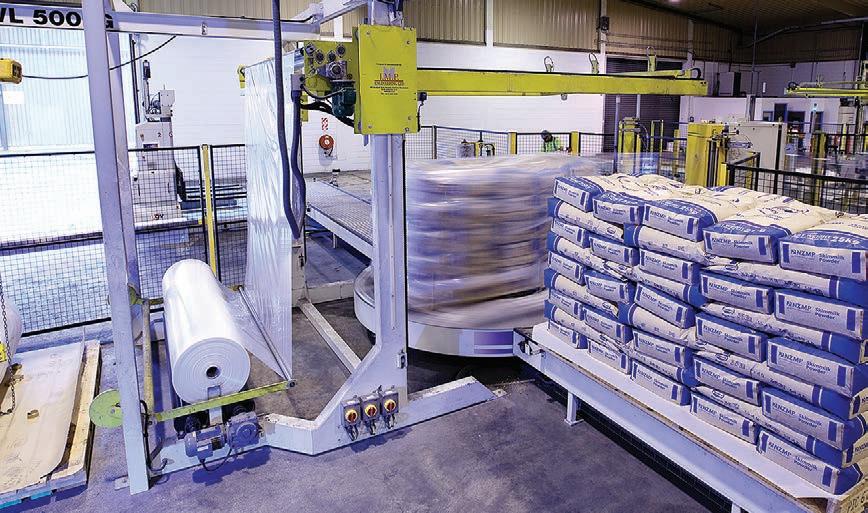
Along with a 2.7% rise for anhydrous milk fat and a 1.1% rise for butter, the GDT price index of all products increased by 2.7%, a partial recovery after a long slide totalling 16% over seven fortnightly auctions and four months.
That slide had caused Fonterra to take $1.25/kg milkfat out of its seasonal forecast range, and pitched most dairy farmers into a loss-making position.
The average price paid for WMP in the latest auction was US$2702, within a range of $2630 to $2800, but the market remains low.
ABS economist Nat Keall said whether the dairy market has found a floor is still an open question.



“We still don’t anticipate a broader recovery for some time.”
The lift in WMP was stronger than the more modest increase anticipated by the futures market
but comes after a 15% fall in prices over the season thus far.
The WMP gains came at the front end of the contract curve, where prices were at their lowest ebb after the previous auction.
“Contracts with shipment dates further into the future are still trading at, or even slightly below, the prices they commanded in mid-August.”



China remains the key to a sustained recovery in WMP prices, and a pick-up in that market doesn’t look imminent.
Keall thought the likely El Niño crimp in New Zealand milk production this season would not be influential; given the extent to which demand has softened, he anticipates the global dairy market will be comparatively well supplied.
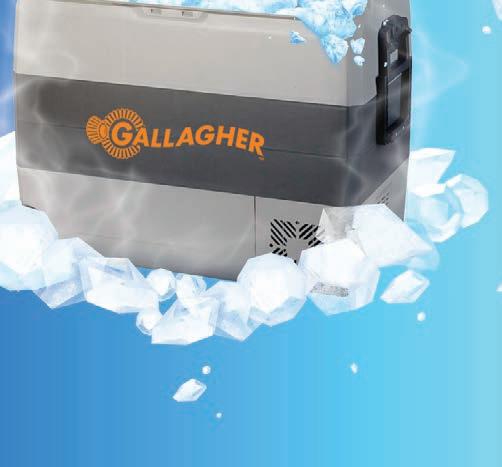

ANZ agricultural economist Susan Kilsby said the slide in dairy prices since May has been arrested.

“While it may not be all positive sailing from here on, it does indicate the market is starting to take note of concerns of reduced milk production from New Zealand this season, and/or is seeing value at current prices,” Kilsby said.
“It looks like market participants are starting to realise that NZ milk production is likely to be constrained this year due
to adverse weather and low returns.
“Some positivity surrounding China’s economy may have also contributed to the result.”




NZX dairy analyst Alex Winning said while a lift in prices is typically an indicator of trend, the market is yet to point in a clear direction.
“Prices have continued to bounce around, peak and trough over the last year, and with the inventory and supply story remaining supported globally and economic woes continuing to impact spending capacity, it is difficult to see a full rebound in prices in the near future.”
WAITING: China remains the key to a sustained recovery in WMP prices, and an improvement in that market doesn’t look imminent, analysts say.
Subdued start to yearling bull sales
Hugh Stringleman MARKETS Livestock
SALES of yearling beef bulls have begun with average prices down about 10% on last spring because of the difficulties facing dairy farmers, the main young bull buying group.
Multiple Steak of Origin awardwinning Northland Angus stud Te Atarangi had an average price of $3457 for 112 sold out of 117 offered.
This was down $300 on last year, but vendor Chris Biddles said that is totally understandable given current farming conditions and confidence.
“Only a handful of bulls sold under what it costs to produce them, given the investment we make to produce a safe calvingease product,” Biddles said.
Top price was $9200 paid for lot 12, Te Atarangi Wheta T020 by Robin and Jacqueline Blackwood at Mangaotea Stud, Inglewood.
A few days earlier Argyle Angus, Kaikohe, had a full clearance of 31 yearling bulls, averaged $3400 and had a top price of $6700.
Piquet Hill Farms Angus, northern Waikato, sold 28 of 33 and averaged $2596 with a top of $4500.
To begin the Hereford sales, Waimaire and Otengi studs in the Shepherd family, Kāeo, Northland, sold 41 of 61, averaged $2700 and had a top price of $5200 for lot 35, Otengi Echuca 415, paid by the Beard family, Kaitāia.
VALUE FREE 60L Portable Fridge Freezer* with any Weighing and Electronic identification Combo Package purchase over $2899! Not sure which Combo Package is right for you? Our team are here to help on 0800 731 500. *Portable Fridge Freezer valued at $700. Terms and conditions apply. Offer valid until 30 November 2023 or while stocks last. 8 FARMERS WEEKLY – farmersweekly.co.nz – September 11, 2023 News 8
Pine planting eats into ewe breeding flock
Beef and sheep


ANEARLY 1% decline in the breeding ewe flock in the past year is due in part to changing land use, Beef + Lamb NZ warns.
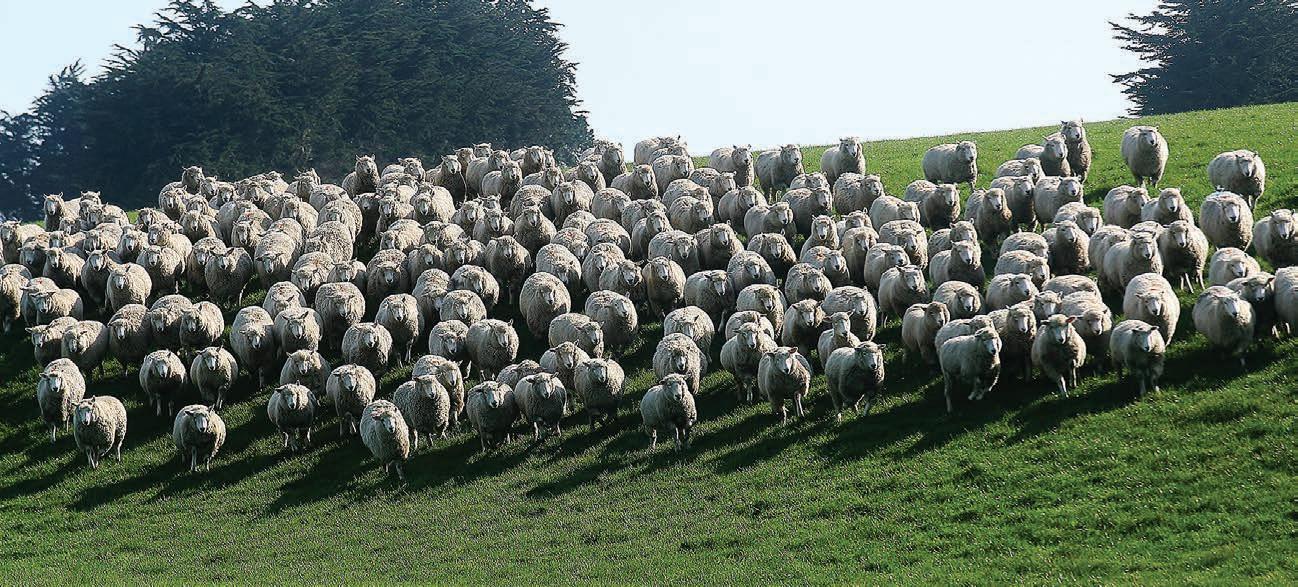


In its latest stock number survey, BLNZ said the ewe flock shrank 0.9% in the past year following a 5.2% reduction the previous year.
There are now 5 million fewer breeding ewes in New Zealand than a decade ago.
“The breeding flock is the key indicator of the future flock size. It’s trending down and is expected to continue to decline. One of the contributing factors is land-use change,” BLNZ chief insight officer Julian Ashby said.
“The amount of sheep and beef farmland being converted to forestry, along with the cumulative impact of a range of other policies on farm viability, is concerning.”
In the past five years more the 200,000ha has been converted from livestock farming to forestry. Ashby said this is reflected in lower sheep and cattle numbers.
The number of breeding ewes is estimated at 15.34 million, down 0.9% on 2022, but hogget numbers are up 4% at 9.36 million.
The amount of sheep and beef farmland being converted to forestry, along with the cumulative impact of a range of other policies on farm viability, is concerning.
The estimated number of lambs born this spring is 20.36 million, 0.6% higher than last year, with expected lambing percentages overall up 1.5% at 126.1%.
Increases in lambs born are expected in Northland-Waikato-Bay of Plenty, TaranakiManawatū and Otago, with other regions being similar to or slightly below last year.

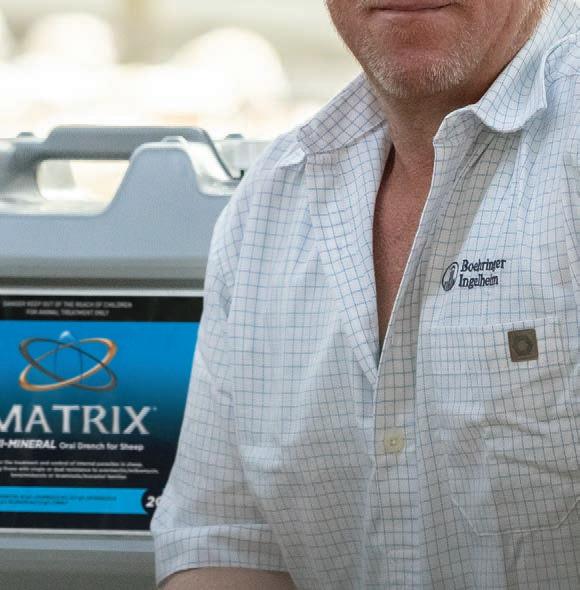

Total sheep numbers in MarlboroughCanterbury increased 2.1%, driven by more hoggets on hand, but there was a small decline on the east coast. All other regions were steady or increased.
The total number of beef cattle is down 2.4% at 3.81 million, with the projected number of calves born expected to be 1.3% higher.
A 0.8% increase in the number of cows and heifers in the South Island offset a 3.7% drop in the North Island.
The BLNZ survey notes that farmers last year chose to reduce weaner and trading cattle numbers, which saw the number of beef cattle weaners decrease 3.2%. Southland farmers bucked the trend and replenished weaner numbers by over 20% following two years of dry conditions.
Ashby said BLNZ has for some time called for limits on the amount of forestry that can be used to offset fossil fuel emissions via the Emissions Trading Scheme (ETS).


Research found that in 2021, two-thirds more farmland was sold for forestry conversion than in 2020, though that declined in 2022 following the government’s announcement of a review of the ETS.
Land is being converted into forestry quickly, with 64,000ha planted on pastoral land in 2022 and a further 88,000ha identified as intended to be planted in 2023.
DROPPING: With a 0.9% drop in breeding ewe numbers taking the national flock to 15.5 million, there are now 5 million fewer breeding ewes in New Zealand than a decade ago.

PROUDLY AVAILABLE FROM YOUR LOCAL PARTICIPATING VETERINARY CLINIC. See product label for full claim details and directions for use. Boehringer Ingelheim Animal Health New Zealand Limited. Level 3, 2 Osterley Way, Manukau, Auckland, New Zealand. MATRIX is a registered trade mark of Boehringer Ingelheim Vetmedica GmbH, used under license. Registered pursuant to the ACVM Act 1997. No’s A009390. © Copyright 2023 Boehringer Ingelheim Animal Health New Zealand Limited. All rights reserved. NZ-OVI-0005-2023. Receive a FREE * Degree Horizon Shirt, with every 20 Litre of MATRIX® Hi-Mineral. *While stocks last.
vet or visit:
Hi-Mineral
all-in-one
9 FARMERS WEEKLY – farmersweekly.co.nz – September 11, 2023 News 9
For more information, talk to your
futureproducers.co.nz MATRIX®
is back in stock this season, providing a convenient and effective
triple active sheep drench for your stock.
Neal Wallace NEWS
Julian Ashby BLNZ
India’s surging growth puts runs on the board
Richard Rennie MARKETS Trade
WITH over a decade’s experience exporting to and working in India, ex-Black Caps cricketer Geoff Allott has some good insights into how far and how fast the rapidly developing market has come in that time.
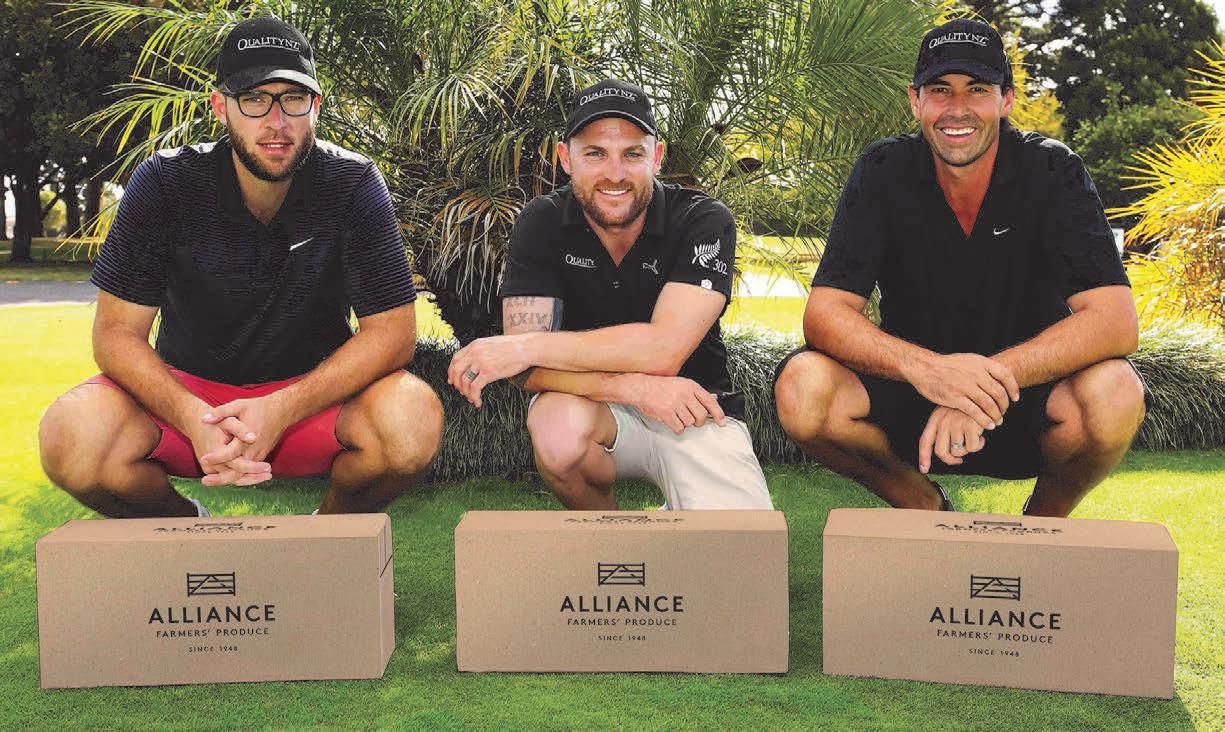


Allott is managing director and founder of QualityNZ, a New Zealand-based company now accounting for 85% of all sheepmeat imported into India (see accompanying article). He said the single biggest shift from a consumer’s perspective is the rollout of bank accounts for all Indian households, coinciding with the launch of Aadhaar, a national identity card for every Indian citizen.
Allott is adamant greater communication and education back home in NZ about India’s
potential is vital in a country where China has tended to dominate the export horizon.
“What we have seen, even in the last 12 months, has been a real momentum building here,” he said.
Stable government and clearly defined policies to achieve growth are leveraging quickly off India’s natural demographic advantage of having a younger population, where 65% are 35 or younger.
Policies and demographics are combining to generate a growing middle class that promises to expand from about 400 million today to over 700 million by 2030.
In a country where agriculture continues to employ about 40%
of the population but account for only 12% of its income, the government is working to urbanise more workers into higher paying manufacturing and tech jobs, pulling those millions out of subsistence poverty.
The requirement for citizens to have bank accounts has resulted in near complete saturation of household access to accounts.
“This was helped along by the government getting rid of certain denominations and offering cash for your account. There was also a variable GST rate bought in, depending upon the product, and it ranges from 5% to 30%.”
The national ID card is linked to the bank account, and from here the government has been able to implement policies like subsidised LPG, mobile phone network rollout and vehicle licensing.
electricity increasing from 66% in 2011 to 90% in 2021, tap water up from 26% to 64%, and toilets from 46% to 64%.
Over half the population have two wheelers for transport.
government schemes to support greater development and wealth improvements.
“They have achieved in five years what has taken many 20 years to do,” Allott said.
Geo Allott QualityNZ
In the decade Allott has been in business the improvements in the average Indian’s quality of life as been definitive.
Census data records access to
Prime Minister Narendra Modi, gearing up for his third election term on the wave of strong popularity, is calling for the nation to double down on all
• Richard Rennie travelled to Delhi with the India-NZ Business Council trade delegation, with funding from Asia New Zealand Foundation and Zespri.
QualityNZ bowls its way to high-end India
Richard Rennie MARKETS Food and bre
WHILE India’s economic gurus may be advising New Zealand to look beyond cricket and Commonwealth connections in any relationship between the two countries, these links have played well for exporting company QualityNZ.
Founded by ex-Black Cap Geoff Allott 12 years ago, QualityNZ has built on the strong cricketing links he and his colleagues have in India, making NZ the single largest exporter of sheepmeat to the sub-continent.
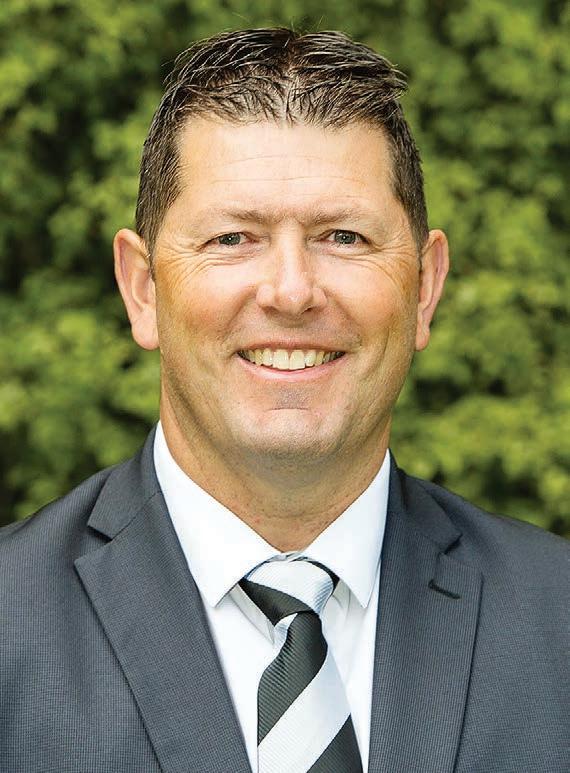
Allott’s role as managing director and 10-Test cap player is backed up with NZ cricketing royalty who are revered on the subcontinent as much as they are back in Aotearoa.
Daniel Vettori, Brendan McCullum and Stephen Fleming are shareholding brand ambassadors, and Sir Richard Hadlee is shareholder and patron to the company.
Despite the undeniable high profile of its ambassadors, QualityNZ has stayed below the radar of many back home as it steadily built its trade and reputation for selling high-quality lamb, sourced from Alliance, to five-star hotels throughout India.
Today the business has lamb in hundreds of hotels throughout India, with plans to expand after consolidating post-covid.
Allott returned back from a trade delegation visit over a decade ago convinced India was going to be the market of the future.
“We did eight months of due diligence on the market. There
were issues there of corruption and issues of supply chain continuity and state specific regulations, and a lack of consistency in GST.
“But despite all that we came back with this idea it was the place to be.”
He was aware, though, that the only way to progress was to create their own subsidiary and supply chain from end to end.
“We needed a logistics system across 46 cities that included temperature control. We needed that ability to control product quality throughout.”
He acknowledges they had not picked an easy path, in a market where sheepmeat can attract up to 33% tariff rates, leaving little margin even in the high end of the market.
The company is also importing and distributing some dairy products and seafood, and investing in education services. India’s covid lockdown response, as in many other countries, saw the five-star tourist trade slam shut, and with it many of QualityNZ’s product outlets. This meant a fraught period for sales and the real risk of the business collapsing.
But Allott said the committed staff from NZ Trade and Enterprise (NZTE) played an invaluable role in keeping their business and the Indian market viable.
“They did much to ensure we could retain our staff, which meant we maintained contact with our customers, so when the doors reopened we hit the ground running.
It gave us massive respect and credibility here.”
Since lockdowns were lifted the company has gone on to enjoy 16 months of record-breaking sales.
Allott cautions that India takes
Part
of the problem
is that the 12-month KPIs used by most NZ businesses are simply not enough. A company needs a top-down strategy from board level to make India a separate project to work on.
Geo Allott QualityNZ
time to develop, and relationships need to be established and trusted for trade to burgeon.
He said the challenge for the likes of NZTE is that there are so few businesses operating there that there are few working models for it to hang NZ’s hat on when highlighting the market to potential exporters.
“Part of the problem is that the 12-month KPIs used by most NZ businesses are simply not enough. A company needs a top-down strategy from board level to make India a separate project to work on.”
He agreed NZ companies have tended to fixate on the Chinese market under a free trade agreement, but with China softening and a desire to reduce reliance upon it, there is likely to be a lift in interest.
He is also hopeful more NZ companies appreciate that an FTA with India is not the pathway to engaging with the country, at least not in the near term.
“Indians cringe when they hear the term ‘comprehensive trade agreement’.”
He said Zespri’s moves to develop collaborative relationships with Indian kiwifruit growers is a smart one, helping to add some value locally.
“The way forward is a collaborative approach, and everyone should have that message by now. India is willing to do deals if the deal makers are willing to acknowledge India.
“The challenge for NZ is whether to hold off for the next five years trying for an FTA then, or do you work alongside India now to improve standards, procedures and products?”
10 FARMERS WEEKLY – farmersweekly.co.nz – September 11, 2023 News 10
WINNING: Ex-Black Cap Geo Allott can count himself as a pioneer for New Zealanders exporting to India.
What we have seen, even in the last 12 months, has been a real momentum building here.
ROYALTY: The ex-Black Cap cricketers who are shareholders and ambassadors for QualityNZ are as revered in India as they are in New Zealand.
What it would take to land Rockit in India
Richard Rennie MARKETS Horticulture
INDIA’s aim to lift the value of its agricultural production could be met in part by a New Zealand company that is turning apples and pears into high-value branded food items.
At the recent India-NZ Business Council trade summit in New Delhi, Shri Sanyal, an economic adviser to India’s Prime Minister Narendra Modi, cited the country’s high reliance on agriculture as a focus of government policy.
With 40% of the workforce engaged in agrarian activity, which generates only 11% of the country’s wealth, a key focus is to move more labour into higher paying manufacturing and tech occupations.
Sanyal also acknowledged the need for India to add greater value to its agricultural output to meet the expectations of its burgeoning middle-class population, expected to top 700 million by 2030.
Tony Martin, CEO of pipfruit genetics company Prevar, said the company’s Rockit apple provides a good foundation to work from, with Indian colleagues keen to develop such a value-add branded product in what is traditionally a commodity market.
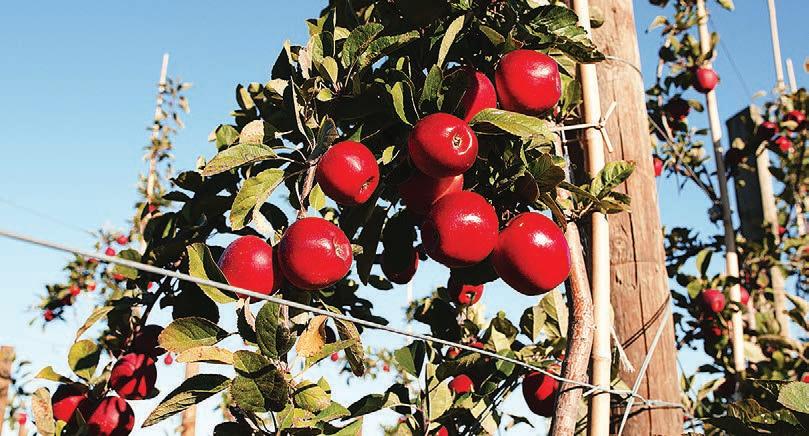
Rockit apples, already well
established in a variety of global markets, are grown by selected growers around the world, including in NZ. The fruit’s snack-size and clever tube packaging mean it manages to command solid premium on conventional fruit.
As a licensed variety, it generates Prevar royalties for every single apple sold. The company also has licensing rights on the Dazzle apple variety and PiqaBoo, a redskinned, white-fleshed pear.
Martin said as highly efficient, productive apple growers, the NZ industry is now facing a tougher



environment as competing countries across the southern hemisphere catch up, particularly South Africa and Chile.
“Simply growing more and putting more apples in boxes is not the pathway to future wealth gain for the sector,” he said.
India’s ability to meet its own demand for apples is falling short, in a market that on average consumes only 1.5kg of apples a year per capita, compared to about 28kg a year in China, and 20kg in NZ.
“Apples are not as accessible as a lot of tropical fruits, and the quality is not good, with a lot of fruit lost in the supply chain.”
In the short-term for Prevar, India is about growing the presence of its fruit brands in a market that attracts 30% tariffs, with a view to longer term collaboration with growers to supply the value-added fruit.
This raises the challenge of protecting the company’s IP around the fruit germplasm, something that can be challenging within NZ, let alone India.
Zespri is all too familiar with the challenges, dealing with a surge in illegally grown SunGold fruit in parts of China after a NZ grower illegally sold germplasm to growers there.
“You need local personnel here with boots on the ground to
maintain a watchful eye on where plant material is going,” Martin said.
“The quarantine facilities here are a long way behind other countries, with material usually moving pretty quickly from quarantine to orchards ...
“You have to have that local personnel. Just one graft means you could suddenly have 8000ha of your fruit growing there.”
The company is considering opportunities on apples that could be grown in India, including the foothills of the Himalayas in Himachal Pradesh, and the Kashmir region.
“This brings us to collaboration. We really want to focus on knowledge transfer and to shore up IP protection, to also ensure
Indian growers are protected. We see a runway of 20-25 years.” He said NZ cannot be a scale producer in the global apple market.
“So, let’s get our fruit grown closer to the consumer and keep NZ as the niche/development and skills market. The challenge is, how do we get growers on board with that philosophy?”
With a background that includes work with NZ Trade and Enterprise and multiple visits to India, Martin said NZ’s latest trade delegation to India represents a big step forward for engagement.

“There is a good sense of momentum here. The company QualityNZ is very much a pioneering one for those who have the wherewithal to do it.”

Modi magic in play as popularity grows in India
Richard
WITH the G20 summit in town in New Delhi, posters promoting the high-powered event are rivalled in number only by portraits of Prime Minister Narendra Modi as streets are swept and light poles repainted in a city-wide makeover for the international arrivals.
Coming to the close of his 10th year in power next April-May, Modi is looking assured for a third term as prime minister. If he completes that he will come very close to being the nation’s longest serving
PM, a record set by Jawaharlal Nehru, who lasted almost 17 years. Any politician right now in New Zealand staring down the barrel of election time would be envious of Modi’s popularity.
A Pew Research poll has 80% of Indians viewing him favourably, and over half of those ranking their view as “very favourable”.
His ability to relate to a wide range of India’s many differing and dynamic social and religious groups, and to also prove himself a highly capable statesman linking with countries previously unused to relations with the nation, have proven popular
with his compatriots.
Last year Modi headed north to meet the heads of Nordic countries in only the second time all five Nordic countries have had a summit with one country, the other being with the United States and president Barack Obama.
On a local level Modi has mastered the art of communicating government policies via radio, social media and TV in a nation that is now highly connected and doused in media platforms.
Carefully scripted Mann Ki Baat or “conversations from the heart” link positive messages about India’s advance, often touching on

international events as much as prosaic but vital domestic issues like the importance of piped water and flushing toilets.
Backed by solid economic development plans to pull millions from poverty and a successful response to covid, Modi’s star appears to be backed by solid policies delivering real results.
He has overseen an overhaul of the nation’s finance system, including getting almost all households electronic bank accounts and significant improvements in all types of infrastructure, from water stations to six-lane motorway systems.
Modi has not been immune to claims of being anti-Muslim and was compelled to deny claims of discrimination against minorities while visiting US President Joe Biden in June.
His credibility and statesmanship were reinforced when Saudi’s Crown Prince, a Muslim, described him as an older brother earlier this year.
With India achieving its moon landing in late August, the nation’s confidence appears to have gained even greater momentum as it puts its colonised past in the rear-view mirror, and sets its agenda on what it expects from trade partners.
Re-elect Ken Hames to the LIC Board LK0116534© • Experienced – know the company • Focused on LIC and results for farmers • Proven record of delivering results 11 FARMERS WEEKLY – farmersweekly.co.nz – September 11, 2023 News 11
Rennie POLITICS Trade
LIFTOFF: Tony Martin, CEO of Prevar, says protecting germplasm IP is a key focus before companies like his can con dently collaborate with Indian orchardists.
POPULAR: Rockit apples are already well established in a variety of global markets, including in New Zealand.
Drawing a line under preventable injuries
Staff reporter PEOPLE Safety
HEAVY machinery, working with large animals, farm vehicles, chemicals – all are risks that must be managed effectively on farms but one of the biggest dangers of all is complacency, said industry leader Lindy Nelson.

Wairarapa farmer Nelson chairs the Agricultural Leaders’ Health and Safety Action Group (Safer Farms), which has launched the hard-hitting Half Arsed Stops Here campaign.
She said Half-Arsed Stops Here makes it clear that as a community, the sector is focused on drawing a line, setting new standards and taking safety seriously.
Nelson, who was also founder of the Agri-Women’s Development Trust, said Half-Arsed Stops Here challenges people to make a stand and share a clear message across farming communities, to reject complacency and to lead by example.
“This is about co-creating a new vision for safety, for all us in farming. It’s moving away from a ‘compliance’ model towards a culture of care. We are calling for leaders at all levels, whether a contractor, a farmer or another
leadership role within your community. When you step up to share that message then others will take note – and we will support and equip you to deliver on that.”
More people die in accidents on farms than in any other New Zealand industry. During 2022, there were 14 farming workplace fatalities and 18,000 new claims to ACC for farming-related injuries. A further five died as a result of farm work accidents during the first three months of 2023.
Nelson said the campaign, which is underpinned by Safer Farm’s new Farm Without Harm strategy, is about answers and solutions coming from the sector itself.
“It’s about farmers talking with and asking questions of farmers to find and share the solutions that are working best for us. It’s focused on sharing what works, learning from each other and putting it into action.
“It’s about opening our minds to doing some things differently and rejecting behaviours and attitudes that can result in harm to ourselves or those around us. Because that is what professionals do, that is what caring communities do. A safer farming future starts with all of us.”
Farming related injuries cover a very wide spectrum. A farm vehicle remains a factor in most
fatal accidents. Lifting and strain injuries, particularly lower back and spine, account for the highest number of farm-related injury claims.
Crushing, impact, biting and other injuries involving livestock; hand injuries; falls from height or slip-and-trips on the same level; burns; chemical contact; being hit by heavy moving or falling objects; becoming trapped in machinery or equipment; electrical shocks; and explosions all feature in the annual toll of people getting hurt.
During 2022, almost 1300 children and teenagers suffered injuries on farms severe enough to warrant a GP visit, hospitalisation or further treatment.
“Farming organisations like DairyNZ and Beef + Lamb New Zealand, along with Safer Farms, have developed a comprehensive range of accessible resources that farmers can use and tailor to their farms, businesses and their people,” Nelson said.
“But learning from each other and past incidents is key. We’ve pulled health & safety experts from organisations across the sector to share learnings from incidents on farm, whether it’s injuries suffered from working alone or from a tractor rollover under load, or contractors operating heavy machinery on farm.
“These are being distributed as Safety Alerts, which are emailed out every month and posted to Farm without Harm social channels and website. These are useful tools or case studies to discuss at team meetings, or to put up for people to read.”
Nelson said there are very good examples of farms and larger corporations that have developed strong cultures of care, and are leading by example.
“There’s no intellectual property on safety. We are seeing a great willingness for people to share their experiences and learnings. In a caring culture, people come first.
“You identify the risks on your
RESOURCES: The resources to improve on-farm safety are there, Lindy Nelson says, ‘and we need the willingness to change to be there’.
farm and, if you can, you eliminate them.
“If you can’t eliminate then you isolate and if neither is possible, you take steps to minimise them. You monitor for any change and communicate to and share updates with everyone who needs to know.
“The resources are there and we need the willingness to change to be there. It’s time for us to all work together to solve our health and safety challenges and to ensure our farming people can come home safe every day.”
MORE:
To sign up to Safety Alerts and nd more helpful resources, please visit www.farmwithoutharm.org.nz
Dairy debt at risk if milk price fall lasts
NEW data modelling from agribusiness financial management company Figured underlines the slide in economic fortunes facing the dairy industry following the fall in the milk price forecast in August.
The modelling of 1000 farms shows the bulk of these farms –which were in a positive financial position in 2022 – diving into a “trouble zone”, Figured chief executive David Dodds said.
A large percentage of farms will be going into what he described as “an area of financial performance that the banks will be monitoring very closely because they become
an at-risk sector of the portfolio where their interest cover and their profit are no longer at a range where they can say, ‘This is fine’.”
He is confident the industry will bounce back if the fall in payout lasts only 12 months because there will be bank support.
The key thing will be getting interest rates back. It’s a massive expense item on the farm. Interest rates going back from 8% to 4% will make a huge difference.
David Dodds Figured
However, that support could be in question if the fall in payout remains over the medium term of two to three years.
The fall in milk price has coincided with a spike in interest rates and at least one of those factors will need to change over the medium term, he said.
“Farmers need to get a sensible, practical, pragmatic plan in front of their banks so their banks know how they’re going to react to it, and they can see they’re reacting to it.
“That’s what they will want to see from their customers who are in the red,” he said.
He expects it will take farmers at least two seasons to get back to where they were, assuming the milk price bounces back.
“The key thing will be getting interest rates back. It’s a massive expense item on the farm. Interest rates going back from 8% to 4% will make a huge difference.”
He believes the sector is better prepared to handle this situation compared to the last downturn in 2015.
“People know what they have to do. They know the run sheet more than what they knew in 2015.”
The company created the modelling as part of a presentation for the Reserve Bank for its upcoming financial stability report to be released in November.
The presentation looks at what depth of support will be needed from the banking sector to help farmers get through the fall in payout.
The modelling looks at net profit and interest cover on 1000 farms of all types and locations across the country.
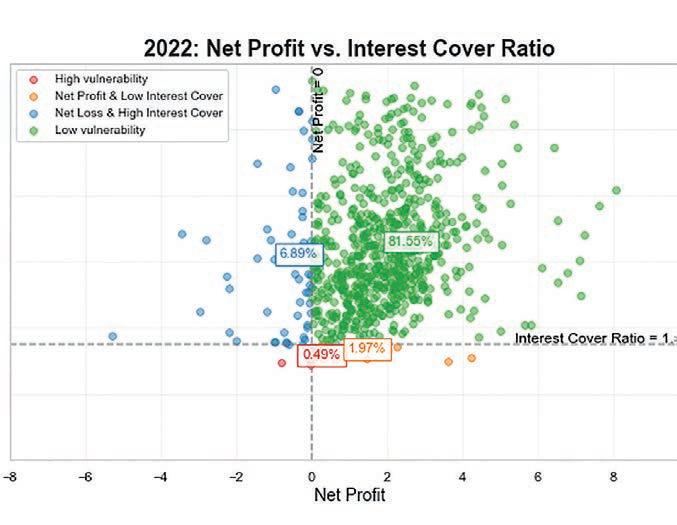
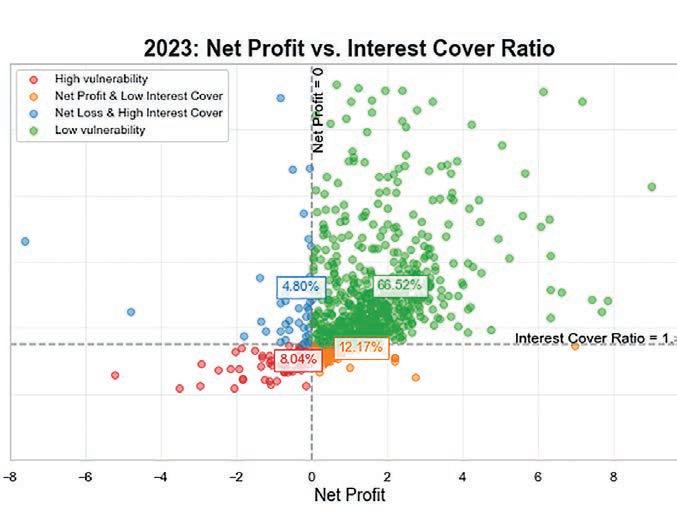
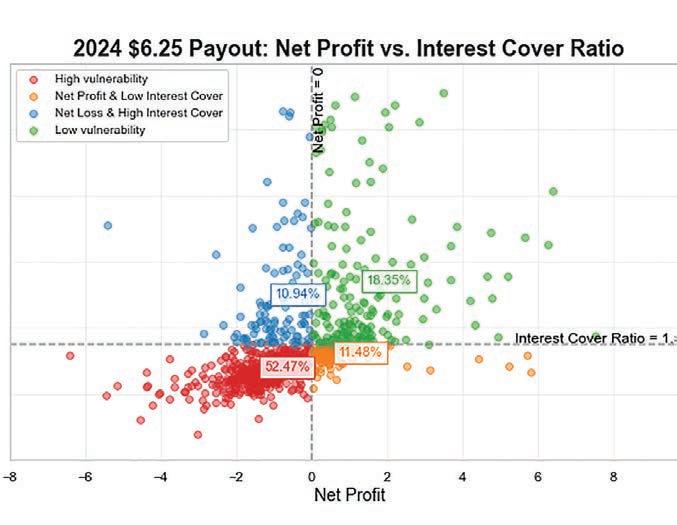
Dodds defines interest cover as the amount of times a farmer can pay off the interest required to pay for running the farm at a cash level. If a farm has an interest cover of one, the farmer will have nothing left after paying off the interest. If the farm has an interest cover of two, the farmer will have the same amount of net cash available after paying off the interest.
“Anything under 1.5 gets the banks worried.”
This is because that farm only needs a slight negative nudge and it will struggle to pay off its interest, he said.

FARMERS WEEKLY – farmersweekly.co.nz – September 11, 2023 News 12
SPREAD: Data modelling by Figured shows the e ect the fall in the forecast milk price will have on New Zealand dairy farm debt levels.
Gerald Piddock NEWS Finances
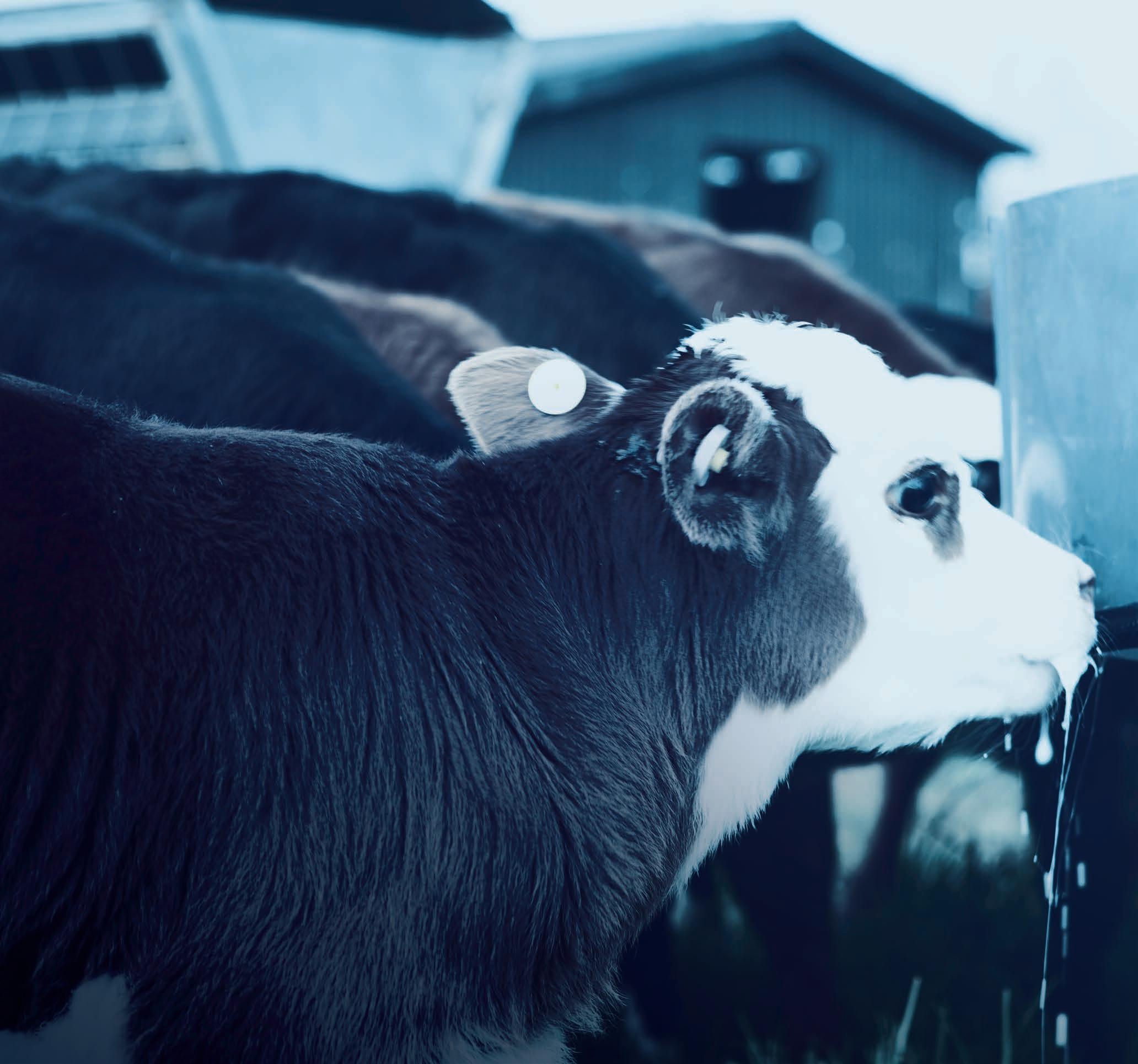













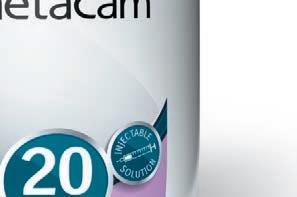








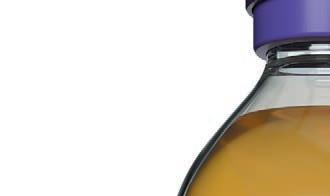
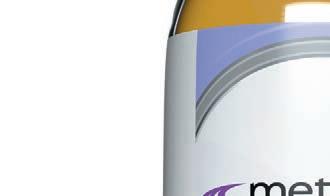









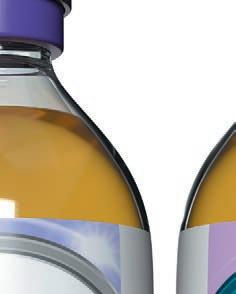



13
Our sheep and beef sector is amongst the most carbon efficient in the world and our sector has reduced its gross GHG emissions by 30% since 1990 while maintaining export volumes and tripling export value.
There is no justification for mandatory emissions pricing on sheep and beef production. We don’t support the Government’s arbitrary pricing deadline of 2025, particularly because it ignores the scale of the issues, and because agriculture is already reducing its methane emissions and will likely hit the government’s target.
We know the current methane targets are too high and are not based on the latest science about the warming impact of different gases.
Introducing a new tax - in the form of mandatory emissions pricing - will compromise, not advance, the efforts already being made by New Zealand farmers, taking money off the bottom line that could be used for on-farm environmental improvements.
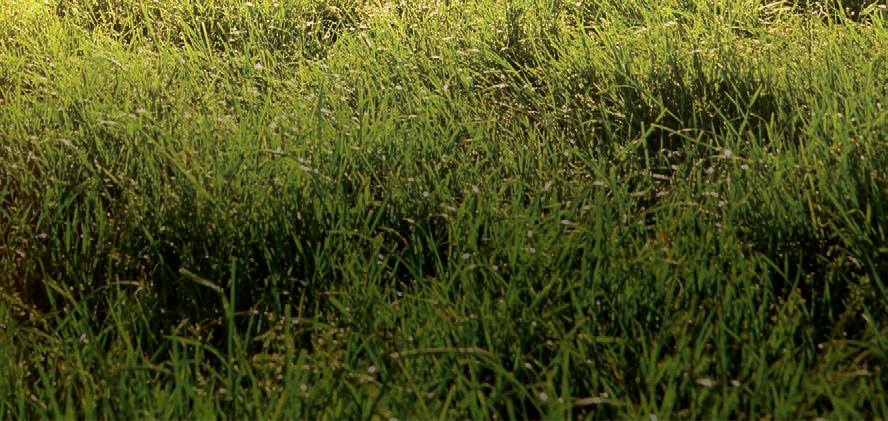

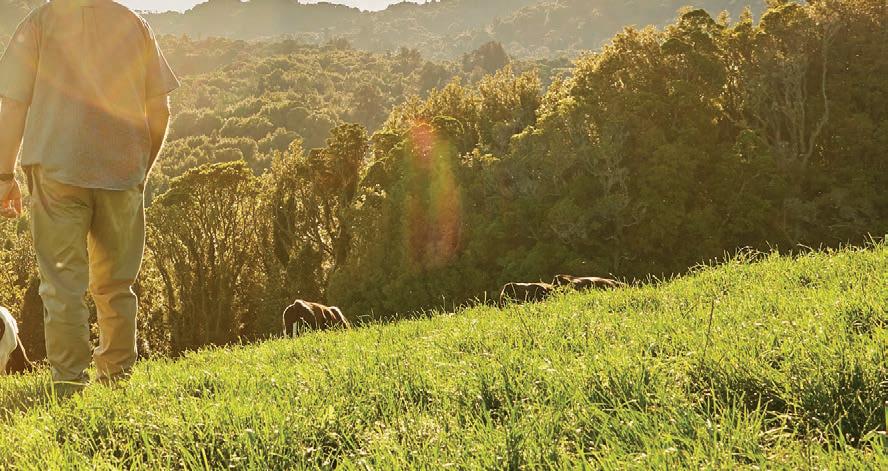
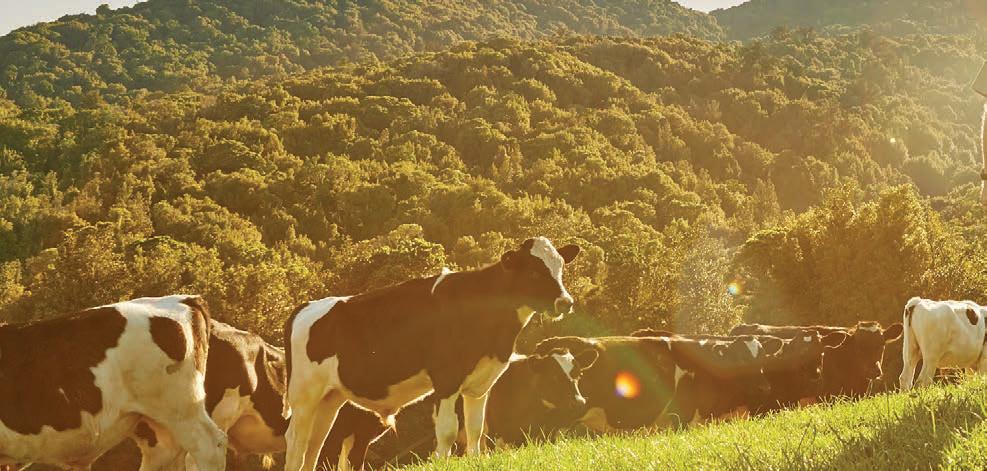
It’s a tax seeking to drive a change that’s already happening due to freshwater policies, ETS settings and farmers driving greater efficiency. There is no need for an additional incentive.
Compromising NZ farming businesses will only lead to emissions leakage and less efficient offshore producers filling the gap - increasing global emissions.
If our international customers are looking for change, a farm-level measurement and reporting system is a way for farmers to demonstrate their progress so the market can have confidence in our world-leading products and reward us. That’s why we support focusing on measuring, reporting and benchmarking of farm emissions. It’s important that we get this foundation right. Farmers must also be fairly rewarded for the carbon sequestration occurring on-farm. What rural NZ needs to know is that our efforts and advocacy will continue – we won’t give up until we get the right outcome.
At the same time, we will continue to invest in world-class research, genetics and education to help our sector achieve further efficiency gains and to deliver the tools that farmers need.
All New Zealanders should be proud of the progress NZ farmers have made. While there is still work to be done, we are leading the world in reducing and mitigating on-farm emissions so let’s celebrate that fact.
1www.beeflambnz.com/news/new-zealand-beef-and-lamb-among-most-carbon-efficient-world



IT’S TIME TO TAKE A BREATH.
PRICING EMISSIONS?
A message from Beef + Lamb New Zealand
Martin Coup Farmer Director Northern North Island
Scott Gower Farmer Director Western North Island
Geoffrey Young Farmer Director Southern South Island
Patrick Crawshaw Farmer Director Eastern North Island
Nicky Hyslop Farmer Director Central South Island
Sam McIvor Chief Executive Officer
14
Kate Acland Chair and Farmer Director Northern South Island
Future floods will take all the help ECan can get
Annette Scott NEWS Climate change
AS CLIMATE change risks continue to ramp up, co-investment will be critical to future flood protection in Canterbury, Environment Canterbury acting general manager of operations Leigh Griffiths says. She said getting the region fit for future flood management is complex.

“As climate change continues to increase the risk, maintaining and improving flood protection is increasingly expensive and complex.
“Co-investing with central government means being able to continue with important flood protection to protect communities from changes that we know are
coming, benefiting communities both now and for the future.
“It also means we can continue with related works such as the upgrade to our water level monitoring network, projects that would have otherwise taken decades to fund through the current rating districts.”
Over the past three years, significant extra investment has been made in Canterbury rivers’ corridors.
This has been enabled through the Ministry of Business Innovation and Employment’s Kānoa – Regional Economic Development and Investment Unit and rates for two major projects, one being climate resilience funding shovel-ready projects.
“This one-off funding has enabled fast-tracking of river works projects throughout the region such as infrastructure upgrades, planting, pest species clearance and fish passage improvements.”
The work is scheduled to be completed in December this year at a total cost of $24.2 million.
The second project, 2021 flood recovery work, is in response to the large flood experienced in central and south Canterbury in May of that year.
The work involves repair and replacement of damaged flood protection infrastructure and is scheduled for substantial completion by June 2024 at a total cost of $22m.
“Many times, it only covers repair of existing infrastructure to the same level of design as it was prior to flooding, which means we’re unable to afford enhancement works or significant changes to the design.
“As we feel the effects of climate change, our flood protection measures will be challenged.
“We need to prepare now for these events by looking at rivers with holistic, systems and intergenerational viewpoints to value, protect and restore them now and into the future.”
Griffiths said there’s no one size fits all when it comes to flood protection and Canterbury’s braided rivers with their wide riverbeds and massive variation in flow add extra complexity.
“Alongside mana whenua and the community, we must consider things such as the river’s proximity to urban environments, existing historical biodiversity and mahinga kai values, climate change impacts and funding availability.”
Flood protection is carried out through 58 river control and drainage schemes from Kaikōura to Waitaki.
Flood protection assets are valued at $850m region wide.
BETTER TOGETHER: Environment Canterbury acting general manager of operations Leigh Gri ths says co-investment enables the delivery of works more e ciently than rates alone can a ord but it doesn’t go far enough.

“Co-investment enables us to deliver works faster and more efficiently than rates alone can afford, but it doesn’t go far enough to support longer term conversations about things such as managed retreat or giving rivers more room to move.
Those within a river rating scheme pay a targeted annual rate to fund the flood protection provided to them, and the more benefit they get from the flood protection infrastructure, the more they pay.
Community, mana whenua and central government expectations are changing when it comes to flood protection and climate change resilience.
“We are responsible for managing flood protection, land
drainage and erosion control works across the region. We must pivot to meet those expectations while continuing to keep people safe from flooding and protecting the environment.
Griffiths acknowledged Canterbury’s braided rivers are ecologically critical corridors that have deteriorated over time.

Historically, settlements were established alongside rivers to use the resources they provide. This has enabled intensive use of fertile land, economic development, and access to food, water and recreation, but it also comes with risks that have traditionally been addressed by flood protection.
Historical imagery shows a
reduction in open gravel area and a general increase in weeds on previously active riverbeds, meaning they require intervention to manage food risk.
In some rivers there is a gravel aggradation issue and in some places the bed is building up.
“Ensuring those who live alongside rivers have a say in developing solutions for flood protection is critical to the work we do,” Griffiths said.
“We must also balance the ability of the community to pay and ensure continued protection while any change is investigated and implemented.”
ECan is currently reviewing the regional planning framework for Canterbury.
“This process seeks to align our planning framework with national direction such as the National Policy Statement for Freshwater Management 2020, including Te Mana o te Wai. This includes the current Our Future, Canterbury campaign, which is gathering community views on what we should prioritise.
“It will inform the 2024 LongTerm Plan and then the drafting of our Regional Policy Statement.”
Foreign buyers converted 99 farms to forestry
Neal Wallace NEWS Forestry
NEARLY 450,000ha was sold to foreign buyers in the five years that such transactions were permitted under the government’s Special Forestry Test category.
Rebecca McAtamney, Land Information NZ (LINZ) head of regulatory practice and delivery, said an additional 6289ha was acquired through 17 transactions under a standing consent.

This means a total of 447,404ha was purchased through 179 consents between 2018 and 2023.
Of those, 99 were for farm conversions covering 80,404ha and 80 were of existing forestry, covering 367,000ha.
The Special Forestry Test threshold has since been increased and all applications are now considered under the higher Benefit to NZ threshold.
The districts hardest hit by sales of farmland to foreign forestry companies under the
Special Forestry Test were: Central Hawke’s Bay, with 10 sales covering 5500ha; Clutha, five at 6800ha; Gisborne, 10 at
14,000ha; Hastings, five at 2300ha; Masterton, eight at 6300ha; South Wairarapa, five at 7900ha; Southland, seven at 2800ha;
Wairoa, five at 4200ha; and Whangārei, six at 2500ha.
LINZ reports that 18 applications have been lodged under the Benefit to NZ test for farm to forest conversions, with the first three decisions made.
One was granted and two declined.
The approved application was to United Kingdom-based Enterprise Investments WRI Ltd to buy 237ha of pastoral land in the Bay of Plenty, its second such purchase.
Predominantly Class 6 and 7 land, the farm has been used to graze cattle and the purchaser intends planting 180ha in pinus radiata.
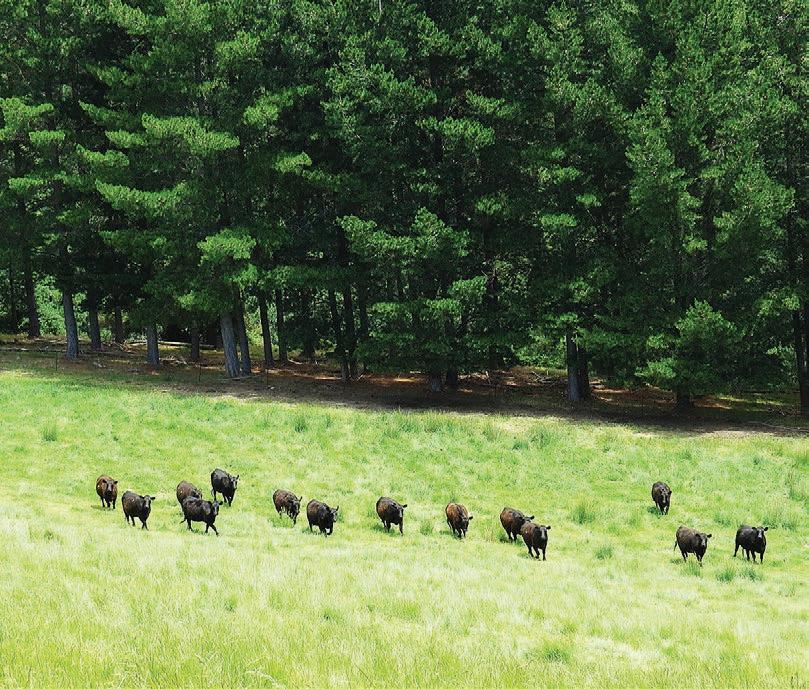
The decision states NZ will benefit through increased job opportunities and revenue from the land, more domestic processing of primary products, ecological benefits, enhancement of an historic feature on the land, advancing significant government policy and potentially increased public access.
Two other applications were rejected, those of Port Blakely Ltd and Corisol NZ Ltd.
United States-based Port Blakely has invested in NZ for 30 years, but its request to buy an 800ha Otago sheep and beef farm was declined despite claiming benefits of job opportunities, increased revenue and timber for domestic processing.
Consent was declined as ministers were ultimately not satisfied that the likely benefit was proportionate to the sensitivity of the land and the nature of the overseas investment.
Swiss-based Corisol NZ Ltd sought to buy a second Otago farm, intending to plant trees on 473ha of the 600ha property. It claimed benefits to NZ from meeting its climate change obligations, increased job opportunities and export receipts, advancing government policy, increased biodiversity and increased public access.
It was declined on the same basis as the Port Blakely application.
15 FARMERS WEEKLY – farmersweekly.co.nz – September 11, 2023 News 15
HIGHER HURDLE: Eighteen applications have been lodged under the Bene t to NZ test for farm to forest conversions. In the rst three decisions, one was granted and two declined.
PROTECTION: Leigh Gri ths acknowledged Canterbury’s braided rivers are ecologically critical corridors that have deteriorated over time.
We need to prepare now for these events by looking at rivers with holistic, systems and intergenerational viewpoints to value, protect and restore them.
Leigh
Gri ths ECan
Letters of the week
Birthday wishes
FARMERS Weekly celebrated its 20th birthday last week and we’ve collected some of the online responses from readers.
Exceptional achievement and real impact on and for NZ Agri. – Todd Muller
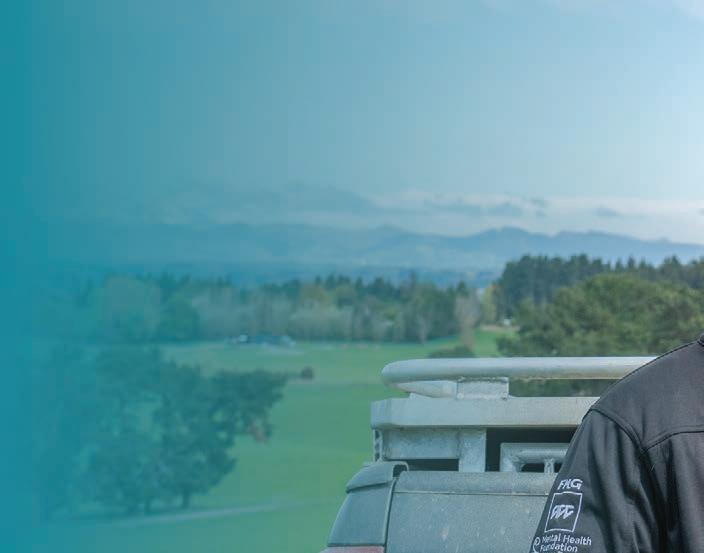
A wonderful staple in our lives, something you can always rely on. – Lindy Nelson
Thanks for EVERYTHING you and the team do! – Julia Jones
Worth so much ... great vision and principles. – Brendan O’Connell
To be relevant then, and still relevant and needed now is quite an achievement! – Jo Hay
Congratulations. – Hon Judith Collins
Excellent agri information transfer ... it lights fires better than many of the others too!!! – Mark Warren
Love the Farmers Weekly and all that it stands for. – Karen Williams
I was on the board back in the day ... a big part of agriculture in NZ. – Shane McMannaway

What a mighty fine achievement. This week’s hard copy is in hot demand – we love that Federated Farmers has taken up regular and substantial news holes in your great publication. Great stuff! – Pattie O’Boyle
Such a wonderful landmark publication that is of such a consistent high standard informing not just the farming community but educating the whole community. – Margaret Kouvelis
What a great accomplishment, congrats kōrua –Mavis Mullins
A great milestone and a great paper. – Sarah Gilbertson

From the Editor
Savouring a victory
Craig Page Deputy editor

WHEN it comes to the business end of a global sporting competition, any win is a good win.
We saw that at the recent FIFA Women’s World Cup, held in New Zealand and Australia, and we’re about to go through it all again as the Rugby World Cup in unfolds in France.
Once pool play is over a loss – as brave as it may be – simply isn’t good enough to remain in the competition.
It is all about winning, no matter how ugly.
That analogy could apply to NZ’s victory over Canada last week regarding access to its dairy markets.
Canada was found guilty of playing the man (or in this case, the country) and not the ball in regard to the Comprehensive

and Progressive Agreement for TransPacific Partnership (CPTPP).
As part of the CPTPP free trade agreement (FTA), NZ is entitled to dairy quota access amounting to 3.3% of Canada’s market. This equates to tens of thousands of tonnes per year in key dairy products for NZ’s exporters.
However, NZ found it was being blocked, and raised concerns that Canada was manipulating quotas – something that has cost this country $120 million in lost revenue over the past three years.
An independent panel ruled in NZ’s favour and found NZ exporters were not able to fully utilise Canada’s 16 dairy tariff rate quotas and that Canada was granting priority access to its own domestic dairy processors.
It is something of a groundbreaking ruling. It was the first CPTPP trade dispute and NZ’s first under an FTA.
Trade and Export Growth Minister Damien O’Connor labelled it a significant win for NZ producers.
“Canada was not living up to its commitments under the CPTPP by effectively blocking access for our dairy industry to upscale its exports. That will now have to change,” he said.
Others described it as a solid victory for our dairy exporters.
In reality, the result was hardly a



trouncing. NZ did enough to take the victory, but Canada is not required to provide compensation to make up for the loss of quota earnings over the three-year period.
Somewhat bizarrely, Canada is also claiming the win, saying it’s “very pleased with the outcome of the panel’s report, which is a clear victory for Canada”.
Those claims come despite Canada being told to change and align itself with the principles of the CPTPP – the equivalent of a yellow card in sport.
NZ relies heavily on FTAs. Since 2017 seven new or upgraded agreements have been reached and this year primary sector exports have grown to record heights of $57.4 billion. Such agreements are the lifeblood of not only NZ farmers, but of primary producers throughout the world who are keen to find international markets for their products.
Winning this battle was vital for the credibility of all FTAs and it will give exporters confidence that processes are in place to ensure they get the market access that was negotiated.If NZ had lost you could have argued that FTAs are not worth the paper they are printed on.
While the result may not have been everything NZ was looking for, at this stage of the game a win is what matters most.
Farmers Weekly is the “go to” for primary producers and you both should be very proud of your achievement. – Sandra Matthews
Very good publication & digital print has only enhanced its value 20 years on. – Paul McGill
Absolute staple in rural media and vital reading for many communities. – Erin Speedy
Young blood
Geoff Prickett
Kāpiti Coast
JUST to say how much I enjoy the Eating the elephant columns – and a bonus this week from Eve McCallum with Seeds of tomorrow. And Charlie Williamson’s piece on the Wyeths’ Wairarapa farming operation, “Leaving the farm better than we found it” (September 4).
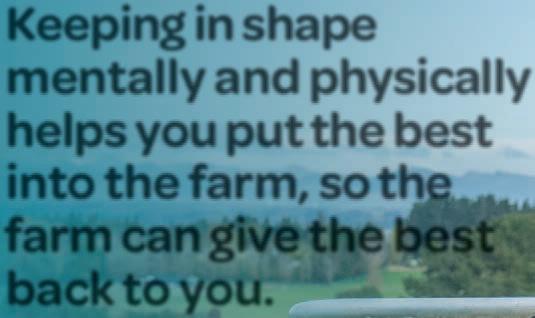
It is so refreshing to read about how young people are facing up to – even embracing – the challenges confronting farming. I wish I was young again and part of this new journey!
Best letter WINS a quality hiking knife

Send your letter to the Editor at Farmers Weekly P.0. Box 529, Feilding or email us at farmers.weekly@agrihq.co.nz
 Sam
Sam
find out what works for you and ‘lock it in’, visit farmstrong.co.nz
To
Whitelock Farmstrong Ambassador
16 Editorial
Keeping in shape mentally and physically helps you put the best into the farm, so the farm can give the best back to you.
FARMERS WEEKLY – farmersweekly.co.nz – September 11, 2023 Opinion 16
Is lab-grown meat kinder to the earth?
Despite long-standing claims about their environmental sustainability, life cycle assessments have only recently been applied to lab-grown meat production.
LAB-grown meat, also known as cell-based or cultured meat, has been attracting astronomical investment in recent years.
The surge in investment is mainly due to concerns regarding the environmental repercussions of traditional meat production and the welfare of animals.

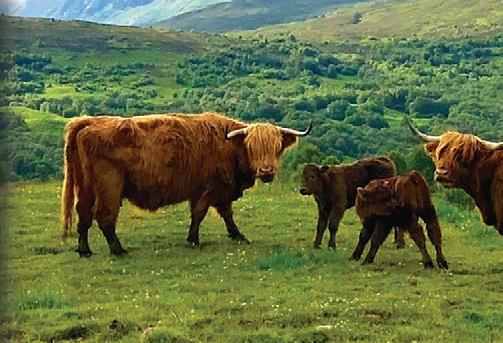
But whether lab-grown meat is better for the environment has remained unclear.
A common method for assessing the environmental impact of a product or process is life cycle assessment. Through such assessments, the environmental consequences of a product can be quantified at any stage from raw material to disposal.
The most recent study to have applied such principles to labgrown meat production was led by the University of California Davis and was published as a preprint in 2023, meaning it has not yet been peer reviewed.
This study reported that the greenhouse gas emissions associated with lab-grown meat production could be four to 25 times higher than that of conventional meat production. However, another life cycle assessment study, led by CE Delft, a research and consultancy company in the Netherlands, and published in January 2023, claimed that lab-grown meat can be much more environmentally friendly than conventional meat production.

The study proposed cultured meat is “almost three times more efficient in turning crops into meat than chicken, the most efficient animal”.
Let’s unpack the reasons for coming to such different conclusions.
It’s important to consider that none of the companies active in the lab-grown meat space has yet been able to expand their production beyond the small scale. The input data for their environmental assessments are therefore heavily reliant on projections and assumptions.
Even the largest commercial meat culturing facility, owned by Upside Foods, currently produces approximately 22,680kg of product per year. This is equivalent to less than the weight of three beef carcases per week –as opposed to the mega-scale red
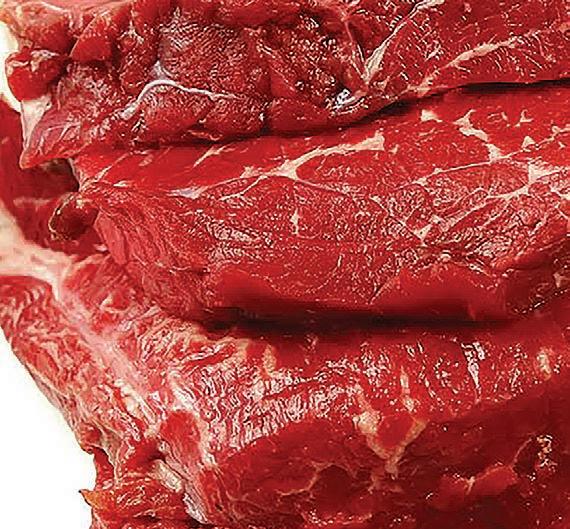
HARD CELL: Will lab-grown meat have a smaller environmental footprint than conventional meat? Competing claims are made about what is a very new industry.
meat industry, which is capable of producing 12.6 billion kilograms in one year in the United States alone.
It should also be noted that to ensure a fair and consistent comparison between different products, selecting a quantifiable reference, known as a functional unit, is crucial.
In other words, selecting relevant functional units enables meaningful comparisons by focusing on what a product is intended to do and the purposes a product may serve, such as providing nutrients or energy, as opposed to gram-for-gram comparisons.
This is especially important when considering the functional and nutritional quality of meat.
Being produced from cloning a single cell type — for example, muscle cells — lab-grown meat
will not inherently contain several key nutrients found in meat such as fat-soluble vitamins like vitamin A, or vitamin B12, which is produced by the gut bacteria in animals.
Therefore, these nutrients will either need to be added to the raw product or the lab-grown meat should be formulated with plantbased alternatives as a hybrid product to contain a similar nutrient profile.
Even then there might be differences in the digestibility and bioavailability of the added nutrients, which is another area worthy of further investigation.

Lastly, both of these life cycle assessment studies agree that growing meat in labs is an energy-intensive process and its environmental footprint is highly sensitive to the energy mixes used for conducting the studies.

The CE Delft study is optimistic that using renewable energy will solve the energy issues associated with lab-grown meat, but it fails to consider that renewable energy is not accessible all around the world.
This is the case for Singapore, which is a pioneer in commercialising lab-grown meat. As the lab-grown industry is still in its infancy and quality data is very limited, any claims regarding the environmental sustainability of such products should be treated with caution and the limitations of each study should be acknowledged.
Gloves-off bout with Leptospirosis flattens me
From the ridge





benefit should you be as unlucky.
It was a cold afternoon, midAugust on a lambing beat, but I was still surprised how frozen I felt despite being well wrapped up.
When I got home I was shivering and said to Jane that if I’d been wet, I think I would have been in trouble.
I spent a long half hour in a hot shower and got some soup and warm food into me before I finally came right.
The next day I felt uncharacteristically lethargic as I checked ewes and moved some cattle breaks.
my shirt and dry off with a towel.
In the early hours of the morning, I googled the symptoms of Lepto as I’d heard there was a bit about and was now certain that was what I had.
The next morning, I was able to get to see a GP and when I told him that I thought I had Lepto, instead of reminding me that I had an agricultural degree and he had a medical one, he agreed –although he listened to my lungs as the symptoms are similar to pneumonia.
the headaches, muscle pains in my back and control the bouts of shivering and sweating.
Blood and urine tests a few days later confirmed Leptospirosis. The prompt antibiotics and enforced rest were exactly what had been required, but it still took 10 days before I was able to return to light duties.
The disease is correlated with wet conditions, so it is not surprising that in the drought year of 2021 there were just five notified cases in Hawke’s Bay.


That is how I likely caught it – from lambing a ewe without wearing gloves.
I should have known better as the property where I was doing the lambing beats had an annoying trickle of abortions, with those ewes looking hard and unwell.
LEPTOSPIRA is a bacterium that causes a blood infection called Leptospirosis.

Recently I became well acquainted with this little critter and would like to share with you the experience as it may be of


I started getting a headache and aching all over and finished the lambing beat dry retching because I felt so bad.
I figured I had a virus, got home, had another hot shower and went to bed.

During the night I went from shivering fits to intense sweating where I’d be so wet I had to change
We are very fortunate here in Central Hawke’s Bay to have a small health centre that is able to accommodate people when they really do need help.
He sent me off with a prescription for doxycycline, which is an effective antibiotic for the infection, and paracetamol.
I’m usually stoic about pain but I took a lot of paracetamols over the next few days to try to manage
Then the very wet year last year saw a tripling of the disease to 15, and the two cyclones and subsequent waterlogged farms have seen 35 cases so far this year.
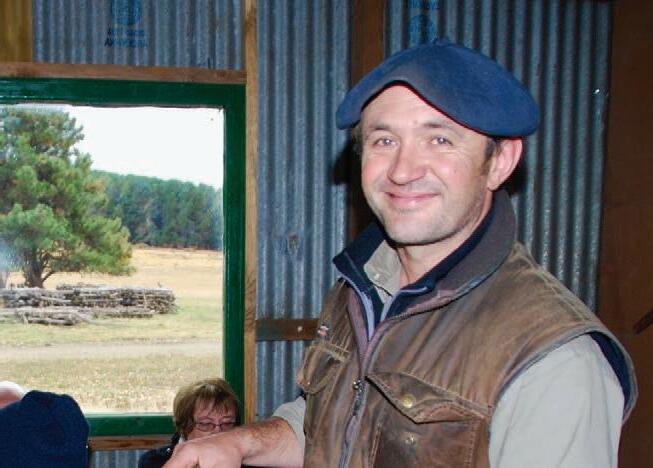
Given it has dried out recently, the risk of contracting the disease will have diminished – but it has not gone away, as infected animals will still be shedding the bug in their urine.
Cleverer farmers than me would have been using gloves and washing their hands with disinfectant and soap and taking care not to get any water or fluids in their eyes, which was easier said than done given how wet it was this winter.
Leptospirosis causes a million cases in humans worldwide and kills between 5 to 10% if medical attention is not available.
It’s a disease to be respected and avoided at all costs.

Take it from me.
• This PSA from Steve is a one-off and not, unfortunately, the return of regular dispatches From the Ridge – Ed

www.farmtofarm.co.nz Book Now for 2024 Tours! FARMERS WEEKLY ROP 11/09/23 70 x 262 116516 Chile, Argentina & Brazil Canada & Alaska JULY 2024 ph 0800 38 38 747 MAY 2024 UK & Ireland JUNE/JULY 2024 17 In My View
Mahya Tavan and Paul Wood
Dr Tavan is a postdoctoral research fellow at Riddet Institute’s Sustainable Nutrition Initiative. Professor Wood is an adjunct professor in biotechnology at Monash University.
In my view ...
FARMERS WEEKLY – farmersweekly.co.nz – September 11, 2023 Opinion 17
Steve Wyn-Harris Central Hawke’s Bay sheep and beef farmer: swyn@xtra.co.nz
Education Ministry on the carpet again
Alternative view
multinational? It gets worse, as the microplastics that come from synthetic carpet are a health risk to humans. Why risk the health of children?
As the ministry also ignored the fire-retardant qualities of wool, our children are at greater risk anyway.
Then there are all the environmental issues of synthetic carpet, which, again, the ministry seems to have ignored. “Pollute at whim” could well be one of its policies.
What made it worse was the subsequent attitude of the Education Ministry staff.
Having made the crazy decision to put synthetic carpet in rural schools, they employed the bureaucratic jackboot.
SEVERAL weeks ago I wrote about the stupidity of putting synthetic floor covering in schools.
Since then the debate has moved from merely stupid to completely farcical.
It started with our esteemed Ministry of Education awarding an $8 million contract to a United States synthetic carpet manufacturer to install nylon carpet in rural New Zealand schools.
That generated a predictable outcry and aptly demonstrated how completely out of touch our Wellington bureaucrats are.
For a start, the media has been full of the evils of synthetic carpets and clothing for years. Doesn’t the ministry read newspapers or watch television?
We’ve banned research into new oil fields because of the evils of petrochemicals. We’ve also banned single-use plastic bags because of their environmental impact. Did any of that information filter into the hallowed halls of the ministry?
Our strong-wool industry is in crisis. Did the ministry factor that in when it offered $8m to a US
If a rural school wanted to use wool carpet it couldn’t just pay the extra. Goodness, gracious no. It had to start from scratch. It was use nylon tiles or pay for your own carpet!
Just think of the mixed messages our schoolchildren are receiving. On one hand they are told they need to protect the planet for their and future generations. On the other they’re told to sit on synthetic carpet.
Then we had the ministry strongly supporting the Prime Minister’s Excellence in Environmental and Sustainability Education award while promoting synthetic carpet in schools.
Think of the mixed messages farmers are receiving. We are told that waterways are there to be cleaned up.
The exception seems to be synthetic carpets from the Education Ministry, which can seemingly pollute at whim.
Farmers are told of all the endangered species we need to care about and preserve.
Contrary to that they can read that microplastics can “affect marine organisms from plankton
to whales”. Add that those same microplastics, according to the United Nations, “affect all organisms including earth worms and invertebrates”, and you can understand the confusion. Farming has minimal environmental effects compared with petrochemicals, so why pillory farming while the effects of those synthetic chemicals are ignored?
Decisions like these show how totally out of touch with reality much of the cloistered coven of our Wellington brigade are. Mind you, National Party leader Christopher Luxon didn’t do farmers any favours when he supported the ministry, effectively
throwing wool producers under the bus.
That was the bad news. The good news is that despite Ministry of Education directives, many rural schools are supporting wool. The extra good news is that wool carpet manufacturer Bremworth is prepared to substantially subsidise the schools to change to wool.
While it is great to see rural schools coming out in favour of woollen carpet, it is crazy that they’re going to have to fund-raise to install it. Conversely, if they’re happy with synthetic carpet they get it for free.
I’ve written about New Zealand carpet manufacturer Bremworth on previous occasions but on this issue it has certainly stepped up. It has launched the Bremworth Wool in Education Initiative to support those schools wanting wool carpet. What it is doing is offering schools 30% off their flooring needs to help make wool carpet more accessible.
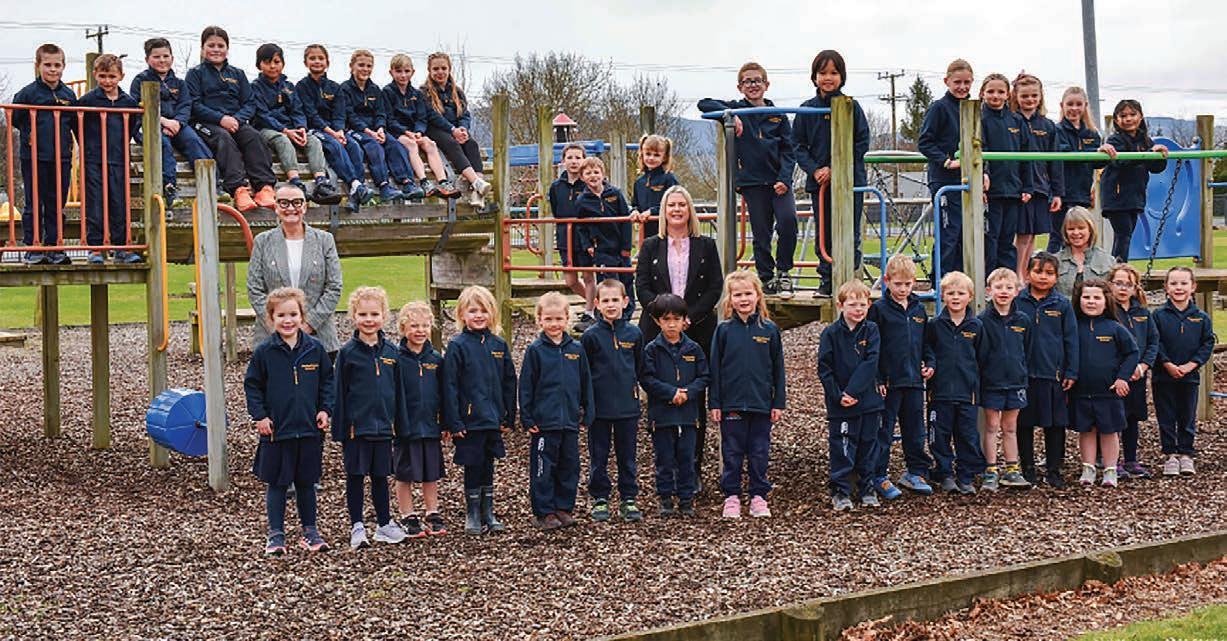
For the record, I’ve purchased shares in Bremworth. It is
supporting farmers and I thought I’d support it. Despite the Ministry of Education’s ridiculous position, I strongly believe in the future of wool carpets.
In addition, Bremworth is calling on the government to amend its position to allow schools to take the cash equivalent of plastic tiles, which makes good sense.
So to summarise the complete buggers’ muddle the Ministry of Education has created:
The ministry has entered a contract worth around $8m to carpet rural schools with synthetics. If they prefer wool they pay for it themselves and that means fund-raising, which is a totally unnecessary commitment for parents.
A public company, Bremworth, offers to help with the bill at around $10,000 a school, just so schools can have environmentally and sustainable wool carpets. One could humbly ask why that ministry should be taken seriously at any level when it shows such ignorance of real life in NZ.
Whiff of party politics in emissions mix
Meaty matters
was the result of consultation with industry leaders.
Unfortunately he seems to have omitted to tell Federated Farmers, Beef + Lamb NZ (BLNZ) and DairyNZ what they had apparently agreed to before going public on the plan.
He is quite right when he says the industry leaders “have reiterated their commitment to taking a collaborative approach on agricultural emissions through the sector partnership He Waka Eke Noa [HWEN] and acknowledge work is needed to meet our climate targets”.
reporting of farm-level emissions, recognition of sequestration in the Emissions Trading Scheme (ETS), and emissions pricing to be set as low as possible. However, the main flies in the ointment are the start dates for mandatory reporting of onfarm emissions from the fourth quarter of 2024, and pricing from Q4 of 2025, as well as the lack of any information about what sequestration will actually be recognised.
solutions, or a date for recognising on-farm sequestration.
Federated Farmers president Wayne Langford calls the government’s response “tone deaf” and DairyNZ chair Jim van der Poel cites a “dire lack of detail” that “continues the uncertainty hanging over farmers since 2018”.


The statement makes much of pressure from multinational customers to prove our sustainability, although there is no reference to the undeniable fact that New Zealand would be the first country in the world to introduce a levy on its farmers, while our livestock producers are already among the most carbon efficient in the world.
THE government’s announcement about the planned introduction of the emissions reduction plan met with the agricultural sector’s universal disapproval in spite of Agriculture Minister Damien O’Connor’s claim that it
But he appears to have taken them all by surprise with the timing and content of the announcement, which makes me wonder what exactly the government’s intention is.
A cursory reading suggests it is pretty close in several aspects to the point the parties to HWEN had reached – confirmation of the split gas approach, measurement and
Nor is there any recognition of the science that is available to prove that the targeted levels of methane reduction are not justified, despite a request from BLNZ for this.
The representative organisations have all reacted with horror and frustration to the sudden announcement after nine months of “radio silence” with no information at all on the form of mandatory reporting, the basis and level of pricing, mitigation
It is hard to escape the conclusion that the minister has found himself under pressure, whether from colleagues or lobby groups, to be seen to take action before the election, when obviously, with Parliament having risen, there is no chance of anything happening.
The minister’s statement proudly claims: “It’s important that the system to manage and price agricultural emissions is workable, effective, fiscally responsible and set up to last. That’s why we’re taking a measured approach to its implementation, ensuring farmers are prepared, informed and well supported.
“It is vital farmers can accurately measure and manage their emissions, prior to the start of farm-level pricing.”
Unless they are totally unwilling
18 Opinion FARMERS WEEKLY – farmersweekly.co.nz – September 11, 2023 Opinion 18
Alan Emerson
Semi-retired Wairarapa farmer and businessman: dath.emerson@gmail.com
COMFY: Rotherham School in North Canterbury is looking to fund wool carpet from some of its fund-raising done throughout the year. Principal Cheryl Barbara says it’s heartwarming to see Bremworth offering to help get wool back into schools.
Allan Barber
Meat industry commentator: allan@barberstrategic.co.nz, http:// allanbarber.wordpress.com
Having made the crazy decision to put synthetic carpet in rural schools, Education Ministry staff employed the bureaucratic jackboot.
Continued next page
It would be unfortunate if this were seen as an opportunity to change direction from the present course, which has seen significant progress.
Dear Chris ...
Eating the elephant
– complete with some thoughts to ponder should you be elected prime minister in October. We will not complain about any avalanche of regulation, nor will we suggest you can influence geopolitics and global economic drivers. Rather, as is our custom, we will share a few ideas about agriculture through stories.
As you get around the country, the farmers you interact with will be reluctant to say spring has arrived. A Christmas frost is always possible. Here in Waikato, the daffodils of early September mean we are about to reach “balance date”. Balance date is the turning point for the year as a grass farmer.
In this series, the lads each write to the next prime minister
THE 14th of October will be an important day in New Zealand. Ian Foster’s men will do battle with the boys in green in France and the political contest of ideas you’ve engaged us in will culminate in the election. We will have got to know you properly –or maybe you will have just kept to the script and run carefully cultivated PR messages. I hope for the former.
In October we will exercise our democratic right and nominate who has the collaborative conversation with David, Marama, James, Winston or Rawiri. Through He Waka Eke Noa, we in agriculture know that collaboration can be difficult, so we don’t envy you on that front.
Chris, over the next four weeks my Eating the Elephant colleagues and I will each write a letter to you
to accept the need for any action to counter climate change, I doubt any farmers would disagree with this statement in principle.
But there appears to be a big gap between intention and reality, which is a hallmark of this government’s track record over the past three years if not longer.
Given the amount of work to be done, it is highly unlikely the government will have a robust measurement and reporting system in place by the end of 2025 that farmers have confidence in.

The failure to set out an achievable plan to measure on-farm emissions, involving a pilot scheme at a regional level before setting a timeframe for the whole country, is an example of the muddled thinking that unfortunately kneecaps all attempts to introduce new programmes.
The slow introduction of the NAIT traceability scheme is the most recent example of poorly thought-out implementation (sheep traceability is as far away as ever and it beggars belief to think we could ever handle an outbreak of foot and mouth disease without
It’s when we move from a mindset of getting through the winter deficit, to working flat-out to manage the surplus around the corner. Chris, I bet you wish the next finance minister’s budgets could turn as quickly as our feed budgets! Alas for you, the economy is not the sheep and beef farmers’ pasture curve.
Chris, what is also exciting about balance date is that it coincides with my birthday. This year is a milestone. Turning 40 calls for interesting introspection. On the home front, my children provide a daily reminder that education cannot be taken for granted as it is the enabler of our nation’s achievement. The children of baby boomers ourselves, we face our parents’ increasing interactions with the healthcare system – and there are plenty of challenges ahead for you there as well.
And then there are more important political matters than agriculture, with our having recently heard from NZ’s chief trade negotiator, Vangelis Vitalis, that the golden era of international trade is past, that geopolitical tensions will heighten

it) and this latest one looks as though it will follow a similar pattern.
The latest government announcement can be viewed as a backstop position from which the industry can negotiate a way forward in the event of a Labour/ Greens coalition having enough votes for a majority after October’s election.
and China’s economy is shaky at best.
You will likely appreciate how this advice makes a middle-aged farmer dependent on global commodities somewhat uneasy. These are challenging times ahead that will require your strong leadership.
You know that NZ succeeds when middle New Zealand succeeds and your agricultural policies need to appeal to agriculture’s silent middle/majority who are head-down, bum-up this time of year.
Chris, you know that NZ succeeds when middle New Zealand succeeds and, like in life, your agricultural policies need to appeal to agriculture’s silent middle/majority who are headdown, bum-up this time of year.

In the alternative scenario of a National/ACT government, all bets would be off with each coalition partner having a policy position that provides the sector with more time to work through the issues.
It would be unfortunate if the second outcome were seen as an opportunity to change direction from the present course, which has
Turning 40 makes me mature enough to relate to the conservative messages of Groundswell’s Laurie and Bryce, while at the same time seeing a lot of potential in the ideas of the Future Farmers NZ manifesto. When talking with your coalition mates on October 15, please bear in mind that most of us share the opinions of the political or philosophical extremes in equal measure. Bear in mind that through our hardworking desire for continuous improvement, we farmers want to change, but as is human nature, we will be afraid of it.
Chris, as highlighted in Todd Muller’s illuminating valedictory speech, you need to talk more with the other Chris on the big issues of climate change response, infrastructure modernisation and research & development. We need improvements in all these areas and maybe consensus among you boys could allow the political games to be played out in areas
seen significant progress towards achieving a credible position on the sustainability of the sector and its commitment to emissions reduction.
Critics of agriculture will never see anything other than economically unacceptable progress as sufficient, but it is more important to move at a realistic pace – one that ensures
materially less important to us. The challenge with the middleaged or the political middle is that we don’t always neatly fit into one camp or the other.
Those of us in the agricultural middle want NZ to be a leader in sustainability for the climate, but not at the expense of our family businesses and our livelihood. We want our rivers to be in the best of health while also being able to consider water storage and irrigation.
We will protect native vegetation and biodiversity, while at the same time driving to increase production efficiency.
We in the middle have become frustrated by the binary polarisation of our politics. We in the middle are difficult to categorise and difficult to stereotype. At times we may come across as hypocritical, but we are human and I hope we are your team’s target audience.
Good luck, Chris. I hope you can be the leader we need.
New Zealand’s position is at least as good as that of its trading partners.
The present government has unfortunately found itself on the horns of a dilemma, which has arisen from a combination of its commitment to achieve net zero by 2050 and its eagerness to appease the environmental lobby, including Climate Minister James Shaw, as well as trying to convince the agricultural sector it is only doing what the sector’s leaders have agreed.

BACKSTOP:
This has resulted in the attempt to impose a scientifically unjustified reduction in methane targets while making the range look achievable at the lower end, when declining livestock numbers will achieve a more realistic target in any case.
At the same time the government has persisted with policies that incentivise the wrong outcomes, or at best has modified them too slowly, to the detriment of NZ’s biggest economic contributor.
For the sake of the country’s future economic prosperity, and that of its farmers, this state of affairs cannot be allowed to continue.
15 FARMERS WEEKLY – farmersweekly.co.nz – September 11, 2023 Opinion 19
CHRIS 1: Labour Party leader, Prime Minister Chris Hipkins. CHRIS 2: Leader of the Opposition, National’s Christopher Luxon.
Phil Weir
Phil Weir is a Waikato sheep and beef farmer and AgFirst agribusiness consultant. eating.the.elephant.nz@gmail.com
Continued from previous page
The emissions position articulated by Agriculture Minister Damien O’Connor recently can be viewed as a backstop position from which the industry can negotiate a way forward, Allan Barber says.
Kumara gelato finds cyclones’ sweet side
Take one forward-thinking patisserie engineer determined to reduce food waste, add a glut of kumara not pretty enough for supermarket shelves, and voila! Dessert is served. Annette Scott reports.

THE adverse weather events in the north that damaged some of the kumara crop this year both sent the price soaring and presented novel ways to use the vegetable.
An innovative Kiwi patisserie engineer, Hannah Clarke, has developed the world’s first gelato made from upcycled toka toka (gold) kumara.
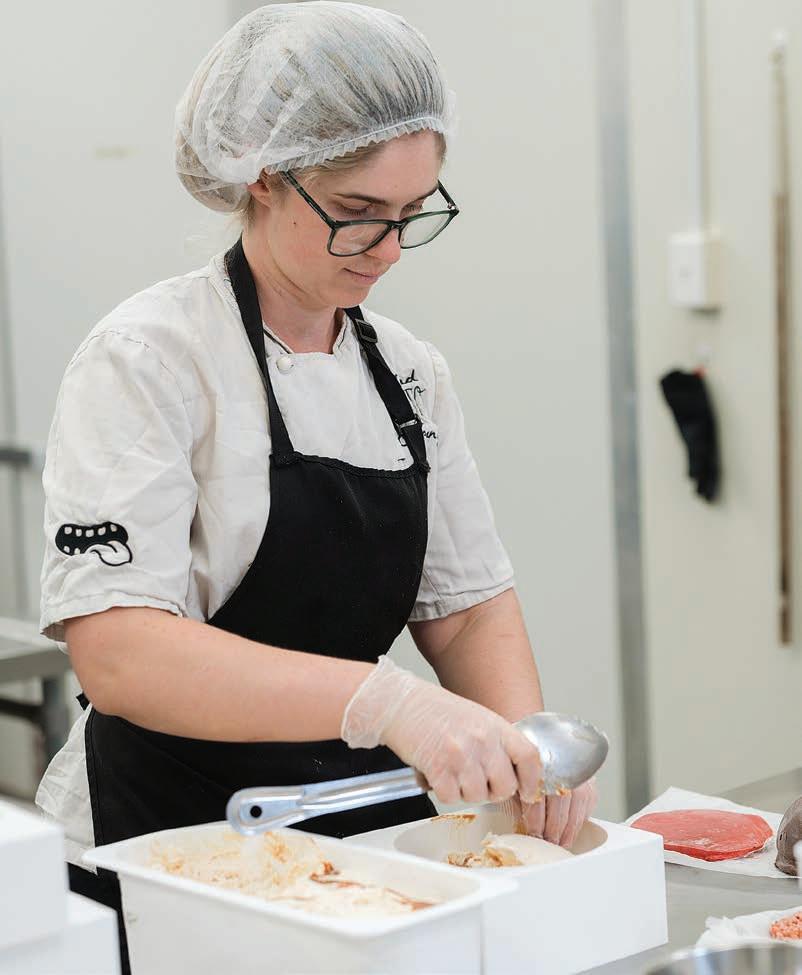
The culinary innovation is part of an initiative by Island Gelato Co to reduce food waste by demonstrating the use of imperfect fruit and vegetables in artisan food products.
According to latest data, 122,000t of fresh produce is rejected annually as imperfect and is either composted or enters the waste stream as landfill.
Clarke said while premium foods are not normally associated with produce diverted from landfill, the ingredients have a number of advantages, including lowering the product’s cost.
Island Gelato has used imperfect fruits in gelato previously, but this
is the first time a root vegetable had been used. Extensive trials were required to determine whether it was feasible.
Clarke had been experimenting with the gold kumara and was fortunate to find a supplier who had hundreds of kilos available after recent weather events.
“Recent flooding has seen the price of kumara reach a record $12.99 a kg in some supermarkets, up 164% from just seven years ago.
“At the same time, thousands of tonnes of fruit and vegetables are dumped with minor imperfections, which range from having an unusual shape through to being too large, too small, the wrong colour or too ripe for the mainstream market.”
With weather events contributing to greater crop yield uncertainty and with climate change accelerating this process, Clarke said, it’s becoming increasingly important to learn to adapt and become more efficient with food production.
“We work closely with producers to rescue as much cosmetically imperfect produce as possible before it reaches landfill.
“As a food producer the use of imperfect ingredients can reduce the cost by up to 70%, which also helps stabilise the pricing for the end consumer.”
The gold kumara brûlée gelato has a distinctive caramelised flavour and the high carbohydrate levels of the root vegetable manifest in a custard-like consistency when used in the frozen dessert.
TASTY: Island Gelato has used imperfect fruits in gelato previously, but this is the rst time a root vegetable has been used.
“While ‘gelato’ is the Italian word for ice cream, there are a number of differences between the two products, which are not well understood by Kiwi consumers,” Clarke said.
Gelato uses more milk and less cream than ice cream and there is also significantly less fat in gelato. With less fat to coat the palate, gelato’s flavours tend to be more intense and more immediate.
Gelato also contains less air than ice cream, which helps keep it dense, fluid and creamy.
“These characteristics provide us with a more flexible medium when we are experimenting with new flavours,” Clarke said.
“I don’t think it would have been possible to create an ice cream that has the same taste or texture as the kumara gelato.”
Along with kumara, Clarke has been inspired to create a number of gelato flavours with other
fruits and vegetables, including avocados, bananas, grapefruit, rhubarb, blueberries, strawberries and stoned fruit destined for landfill.
“We ended up with hundreds and hundreds of the most beautiful cherries, which were deemed too dark for the export market, but they were just gorgeous.
Just as we’ve seen an evolution in the beer category and the emergence of boutique craft beers and ales, Kiwis are becoming more discerning when it comes to chilled desserts.
“We needed to work with another Kiwi company to pit them all for us, but the gelato at the end was exquisite.
“It was wonderful that we were able to give money back to the farmer who grew such an incredible product.
“We are definitely on a journey with vegetables. Up until now it hasn’t been something we’ve delved into much because we weren’t sure customers would go for it, but I’m hoping to bridge that gap.
“Just as we’ve seen an evolution in the beer category and the emergence of boutique craft beers and ales, Kiwis are becoming more discerning when it comes to chilled desserts.
“New Zealand leads the world in ice cream consumption with a per capita consumption of 28 litres per year.”
Island Gelato Co last week picked up 25 medals at the National Ice Cream and Gelato Awards, including a gold for its sour cherry and rich chocolate gelato, which uses cherries considered too dark for the Asia export market.

Pork industry honours stalwart Trengrove
purpose-built farrowing system to reduce piglet losses.
CANTERBURY pig farmer Chris
Trengrove has been honoured by the pork industry with a lifetime achievement award.
The award recognises Trengrove’s innovation and commitment as an industry leader and his contribution to the New Zealand pork sector.
Trengrove, who farms near Christchurch, began his career in banking before switching to farming in the late 1980s.
He served on the board of NZ Pork for 15 years, nine of those as chair, and was instrumental in the development and introduction of the sector’s PigCare welfare assurance programme and a major review of import health standards. Known for his innovative approach to pig farming, Trengrove designed a novel,
He also pioneered artificial insemination for outdoor pig herds in NZ.
NZ Pork chief executive Brent Kleiss said Trengrove has made an immense contribution to the sector.
“Chris has invested time and energy serving our sector and NZ agriculture over many years and established international links with pork industries, researchers and organisations.
“He also has a deep commitment to research and pork industry training,” Kleiss said.
Also in the industry’s limelight were Tayla Steele, who works for Patoa Farms in North Canterbury, and Regan Driever of the Stanley Brothers pig farm near Ōpunake in Taranaki.
The pair were joint winners of the 2023 Stockperson of the Year award.
Steele spent several years working on thoroughbred racehorse studs before joining Patoa Farms 14 months ago. She has gone on to gain an NZQA Level 3 in pig husbandry.
“I was looking for a change and wanted to move to North
Canterbury because it’s a lovely location to live,” Steele said.
“I’d never had anything to do with pigs but knew a few people in the industry and they enjoyed it.
“I really like working with pigs. They are inquisitive, smart and playful.”
Steele said it has been a good way to step into farming.
“If you have no farming background, I’d say give pig farming a go. You don’t need any experience; you’ll get help to learn everything as you go along.
“I see myself in the sector longterm,” she said.
Driever joined Stanley Brothers two years ago straight from school, having enjoyed a stint of work experience on the farm.
HANDSHAKE: Canterbury farmer Chris Trengrove receives his award from NZ Pork chief executive Brent Kleiss.

He has gained his NZQA Level 3 in pig husbandry and plans to study for his Level 4 next year.
“I’m always learning something new,” he said.
“There’s so much involved, nutrition, pig welfare, biosecurity and I really enjoy working with the pigs.
“I see it as a long-term career and I’d encourage any young people interested in the sector to apply for work experience and see what they think,” Driever said.
24 FARMERS WEEKLY – farmersweekly.co.nz – September 11, 2023 People 20
MONEY BACK: Patisserie chef Hannah Clarke says it’s wonderful to be able to give money back to farmers who grow such an incredible product.
Hannah Clarke Island Gelato Co
Annette Scott PEOPLE Livestock
Wool tech search is starting to see results
The Wool Research Organisation of NZ, which deploys former Wool Board money on research into wool-derived products, says it is hitting its stride. Annette Scott reports.

APROJECT exploring new uses for strong wool is attracting strong international interest, the Wool Research Organisation of New Zealand says.
WRONZ established Wool Source in 2021 as a commercialisation venture to test market potential for products developed via the New Uses for Strong Wool programme.
The programme is supported by wool growers, supply chain participants, the Ministry for Business and Innovation and Employment (MBIE) and the Ministry for Primary Industries’ Sustainable Food and Fibre Futures (SFFF) fund.
Wool Source chief executive Tom Hooper said the focus on commercialisation for its woolderived powder, pigments and particle products is starting to yield results.
WRONZ holds the intellectual property rights and patents for the technology it has generated.
“We have had an incredible response from the different sectors and industries we have been introducing to our products in,” Hooper said.
“The value proposition wool offers is not only those natural performance benefits of wool, which we’ve retained as we’ve transformed the fibre into new forms, but its credentials as a natural, renewable, biodegradable and ethically sourced product.”
The products have attracted interest ranging from large
multinationals to local NZ players and comes from sectors as diverse as personal care and cosmetics to ink and coatings.
“We’re selling product, we’ve got multiple product development projects underway with international brands and a significant opportunity is opening up for our Wool Source Pigments in the inkjet printing market,” he said.
The focus remains on finding markets and opportunities that will return the most value for growers, lift the price of wool at the farm gate and capture as much margin as possible within NZ.
“We are crystal clear that our
mandate is the WRONZ mandate to maximise the returns for growers.
“We are ultimately looking for volume sales opportunities for our products and access to our IP and technology is conditional on customers using NZ strong wool.
“This puts us in a different position to a commercial entity looking to maximise their own profitability or short-term returns,” Hooper said.
As Wool Source was set up to establish the commercial viability of its products and create new markets for sales rather than ongoing commercial operations, WRONZ is using an independent advisory firm to investigate the longer-term commercial pathway options and which of those can deliver the greatest success for growers.
An opportunity for NZ-based investment is expected in the next 12 months.
Meanwhile the market engagement for Wool Source continues at pace.
“We have new Wool Source products launching soon that open up even more markets and travel to Europe and the US planned over the next couple of months to share exciting product development trial results with potential distribution partners.
“There is a momentum gathering with a lot of irons in a lot of fires.
“Product adoption of new and novel technology is not an overnight endeavour but I’m feeling positive and excited by the
opportunities ahead,” Hooper said.
Acting chair Andrew Morrison said WRONZ is in the game to tangibly find a solution to improve returns for growers.
WRONZ inherited $40 million of former NZ Wool Board funds, and the Wool Source pigments project has dipped into that bucket.
Almost $10m has been invested in a pilot plant at Lincoln University aimed at demonstrating saleable deconstruction of the strong-wool process.
“This is the last remaining Wool Board money, it is grower money.
WRONZ is tasked with researching value creation, we are doing that and, yes, the fund is now sitting at about $30m.
“We want farmers to know
what’s going on and this new technology is challenging ourselves while fundamentally getting returns for farmers.
“We are running as fast as we can and committing that capital to the pilot plant because we are well aware of the challenge. We need to find a solution.”
Morrison was hesitant to put a timeframe around the woolderived powder, Wool Source pigments and particle products project given it is just now reaching the commercialisation stage.

“You don’t have a customer until you deliver the product they want. We are fine-tuning to ensure the product is picked up.
“WRONZ do all the related research work and we present that to the industry, and once the pilot plant meets the specific needs of customers with a business case that stacks up for industry, we find the best way to release the product bringing value back to the farmer and value to the entity that captures the manufacturing margin,” Morrison said.
Rights boom bodes well for plant breeding
Annette Scott TECHNOLOGY Horticulture
AN increase in plant variety rights applications bodes well for New Zealand agriculture, with plant improvement in a strong space according to NZ Plant Breeding and Research Association general manager Thomas Chin.
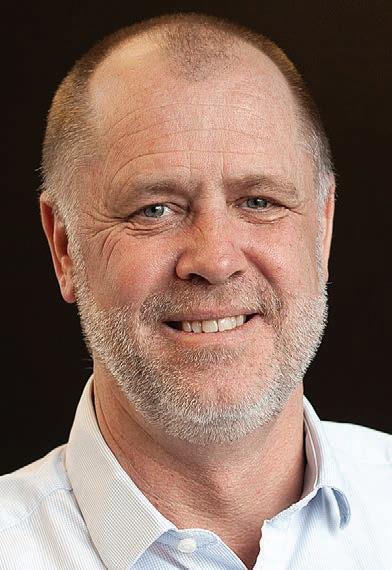
Investment into breeding new plant varieties to develop new traits is up, with access to topperforming cultivars underpinning NZ’s agricultural and horticultural success.
“An essential component of this is having a strong and innovative plant breeding sector.
“Many new and improved plant varieties are released to farmers and growers annually, helping to lift profitability and productivity.”
A report from the Plant Variety Rights (PVR) Office for 2022-23 shows arable crops, vegetable and pasture plant breeders filed 44 PVR applications, the highest number recorded for the past eight years.
The leading countries of origin for PVR filings were the Netherlands, Switzerland, the United States and NZ.
Summarising trends across the plant breeding sector, the report
says pasture, forage and arable crops such as clover, ryegrass, wheat and vegetables accounted for almost half of the total applications.
Fruit and ornamentals made up
the remainder of the application groups.
Chin said about 80% of all barley cultivars and 75% of commercially available wheat varieties, popularly grown by farmers, have PVR protection.
This means that under the Plant Variety Rights Act 2022, rights holders may obtain royalties from farmers who save and re-use seed protected since 2022.
Rights holders and farmers are in discussions with the Ministry of Business, Innovation and Employment (MBIE) to enable a formal royalty collection system.
Royalties on farm-saved seed are also authorised through NZ’s international obligations under the International Union for the Protection of New Varieties of Plants, also known as UPOV, which brings NZ into line with its main trade competitors.
yield, disease and pest resistance and climate resilience or other traits demanded by the market,” Chin said.
Meanwhile, the association has welcomed a new MBIE study on the economic and public good of PVR.
An increase in PVR filings means plant breeders are employing more staff and releasing new and better varieties to the market.
Thomas Chin NZ Plant Breeding and Research Association
“We look forward to the results confirming the vital importance of plant breeding as a key driver for NZ’s economic growth.
ROYALTIES: Plant breeding and research association general manager Thomas Chin says royalties are critical for plant breeders as they incentivise reinvestment in breeding programmes.

“Royalties are critical for plant breeders as they incentivise reinvestment in breeding programmes to deliver new varieties with improvements in
“An increase in PVR filings means plant breeders are employing more staff and releasing new and better varieties to the market.”
21 Tech FARMERS WEEKLY – farmersweekly.co.nz – September 11, 2023 Technology 21
POWDER: Wool Source powder is one of the range of products transforming strong wool into new forms with new applications.
DIVIDENDS: Wool Source chief executive Tom Hooper says the focus on commercialisation for wool-derived powder, pigments and particle products is starting to yield results.
We are crystal clear that our mandate is to maximise the returns for growers.
Tom Hooper WRONZ
FARMYARMY.CO.NZ

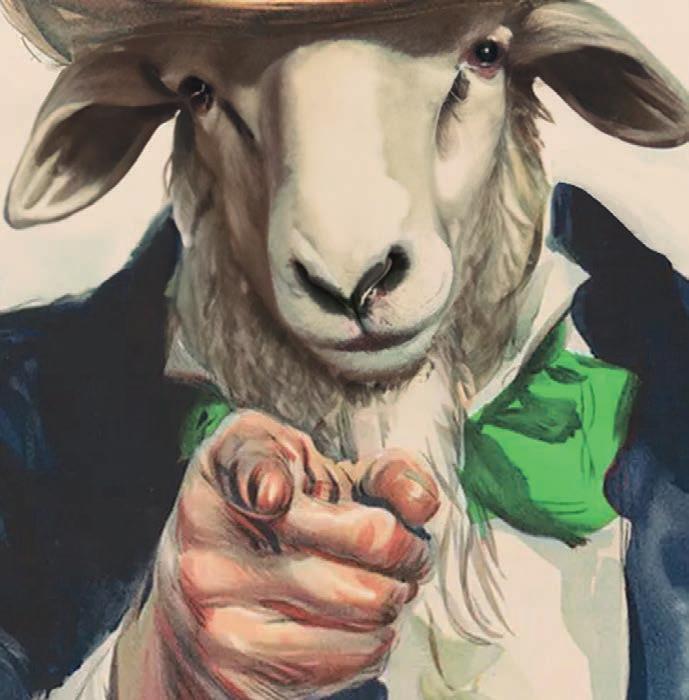
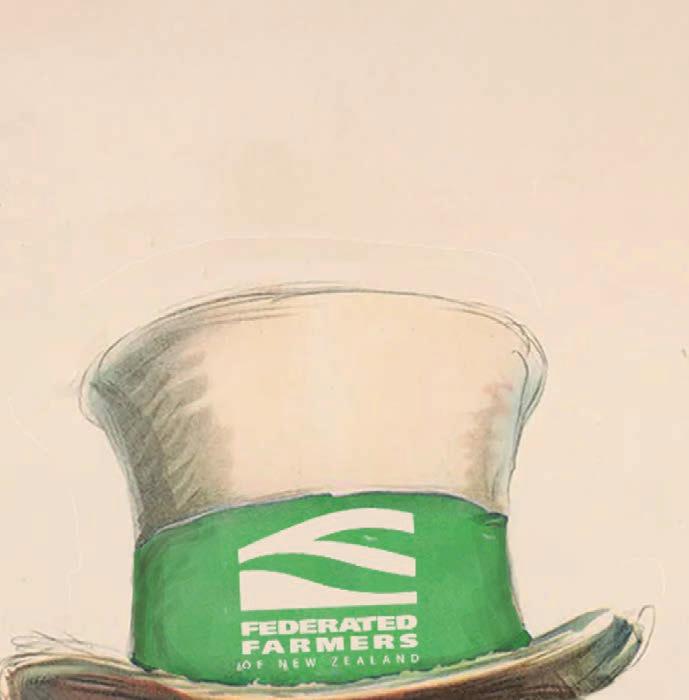
23 SEPTEMBER – 23 OCTOBER









SPRING INTO ACTION, HELP WITH NZ CYCLONE RECOVERY
CONTACT 0800 327 646 TO VOLUNTEER

22
FARMY ARMY
FEDERATED FARMERS

Vol 1 No 2, September 11, 2023 fedfarm.org.nz
Rural issues debate to be broadcast
Leading gures from New Zealand’s major political parties are set to go headto-head discussing rural issues and all things agriculture in a live debate hosted by hard-hitting journalist and radio personality Heather du Plessis-Allan.


The not-to-be missed event is a joint initiative by Federated Farmers, Beef + Lamb NZ and DairyNZ, and will be broadcast live from 7.30pm – 9pm on the New Zealand Herald website this Thursday the 14th of September.











Damien O’Connor (Labour), James Shaw (Greens), Todd McClay (National), Andrew Hoggard (ACT), and Mark Patterson (New Zealand First) will all be setting out their Party’s vision for rural New Zealand - and will no doubt be locking horns over the big issues facing Kiwi farmers.

It’s going to be a good oldfashioned debate, entertaining and informative, in front of a live studio audience of 300 farmers at the Mystery Creek Events Centre - and those who tune in from the comfort of their own home. The politicians will get a few minutes each to make their pitch before du Plessis-Allan starts ring o the questions – and there will be no use ducking for cover!
“This election is the most important in living memory for New Zealand’s farmers and rural communities. Farmer con dence is at record lows with a cost-of-farming crisis, rising interest rates, falling
commodity prices, and a long list of new regulations adding extra pressure for farming families,” said Federated Farmers President Wayne Langford.
“People are really feeling the pressure. That’s why it was so important for Federated Farmers, DairyNZ, and Beef + Lamb NZ to provide a platform for people to hear directly from the politicians how they plan to improve the lives of the 2.5 million New Zealanders who live outside of a major centre.
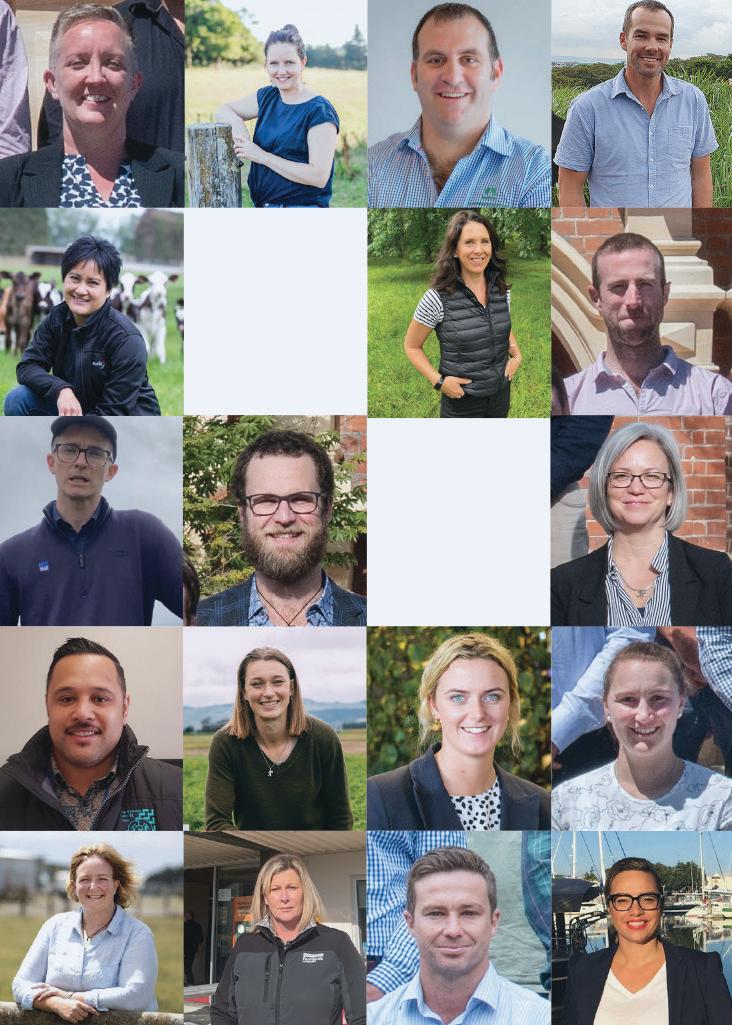
“Every election we see a lot of discussion about the big issues facing cities like Auckland, Wellington, and Christchurch – but what about places like Morrinsville, Feilding, Golden Bay, Ashburton, and Gore? This time around we are determined to put the issues important to rural New Zealand on the map,” he added. The debate will focus on the big issues for farmers with the politicians canvassing everything from He Waka Eke Noa and methane targets through to freshwater policy and live exports – but they’ll also be discussing the issues that impact the broader rural community like mental health, education, digital connectivity, and roading. If the debate is anything like our rural roads, the politicians could be in for a bumpy ride!
“We’re encouraging all rural New Zealanders to get in behind this event to make it a huge success – so ask your local pub to put it up on the big TV screens, invite around
a few mates for a beer to two, get your farm team around for dinner, or just enjoy a romantic night at home watching it with your better half,” Langford said.
“We don’t care how you watch it or who you watch it with – just make sure you do. The issues we’re facing as a community are just too important not to engage with them”.
live on
New
Herald website from 7.30pm – 9pm this Thursday the 14th of September.








23 Fed Farmers
MORE: The Rural Issues Debate will broadcast
Strategic leadership development for Food and Fibre now. Applications for Lincoln Programme One 2024, January 23 start, close on 22 October. To learn more or apply visit ruralleaders.co.nz/kellogg
the
Zealand
What Feds want from the next govt
Federated Farmers launched their policy platform for the General Election at the Mystery Creek Fieldays in June. The challenge to all politicians was to stop bogging farmers down in impractical and costly regulation, and instead to work with rural communities to improve outcomes.
It’s only two months later, but events in that short period make the Federation’s 12 policy priorities even more urgent.
For the second time, Fonterra downgraded its forecast farmgate milk price, to a midpoint of $6.75. DairyNZ’s updated national average breakeven figure for the season is $7.51 – and that excludes principal repayments on debt.
As Feds Dairy Chair Richard McIntyre said at the time, knowing that on average they’ll be losing 76 cents on every kilogram of milk solids they produce, will have a significant psychological impact for dairy farmers as they slog through the long hours of calving.
It’s not just the dairy sector. Lamb prices have dropped 25% in the last 12 months and with the pastoral sector tightening their belt, arable growers of feed wheat and barley will feel it. Feds Arable Chair David Birkett said recently that in the current economic climate, most crops are struggling to return a sustainable profit. That ends up with many growers deferring capital replacement, not paying themselves sufficiently or taking on more capital debt.
Little wonder that confidence levels shown in the Federated Farmers July 2023 survey were the lowest in the twice-a-year surveys the Federation has run since 2009. There’s growing evidence that the government’s books are in bad shape, with an order going out to all government departments and agencies to find savings.
It’s no time to be hampering a sector that earns more than 60% of New Zealand merchandise export revenue but right when farmers
need support, they’re instead faced with uncertainty, extra regulation and more costs.
Federated Farmers President Wayne Langford said the organisation’s Election Platform 2023 “sets out a clear roadmap that can be picked up and run with by any political party who wants to get New Zealand back on track, support food production, and grow our exports – and therefore our economy.”

His message to politicians of all stripes at the time the platform was released is even more pertinent now: “If you get out of the way and let us do what we do best – farming – we won’t just meet expectations, we will undoubtedly exceed them.”
Federated Farmers of New Zealand’s 12 policy priorities for the next Government:
1. Support better use of technologies

2. Unlock potential through water storage
3. Allowing young farmers to access their KiwiSaver
4. Urgently review our methane targets

5. Rethink our ETS Forestry Rules and net-zero target
6. Scrap the Ute tax and fix our infrastructure
7. Give back control to local communities
8. Fix our unworkable freshwater rules
9. Get RMA reform right


10. Simplify Significant Natural Areas
11. Build the farmer workforce
12. Show fiscal and monetary discipline
How could these policies impact farmers over the next three years?
There’s not the space to go through in more detail all 12 of the Federation’s policy calls but six of them feature over the next three pages and the full Election Platform is available at the website fedfarm. org.nz (search ‘Election Platform’).
Call to unlock potential through water storage
Access to water is absolutely critical for the long-term success of New Zealand agriculture as we look to increase production, diversify land use, and build climate resilience. As a country we have no shortage of water, but we don’t capture and store anywhere near as much as we could for productive use. It’s estimated that only 2% of the water that falls in New Zealand is captured, with the rest flowing out to sea.
MPI’s 2021 report Water Availability and Security in Aotearoa found that New Zealand has more than 500,000 hectares of land that has strong topographic, hydrological and financial viability for water storage. The Ministry noted that water was particularly important to support diversification of land use to uses that have a lower environmental footprint.
“There is huge potential to invest in water storage in New Zealand that will have a significant return on investment for farmers and rural communities,” Federated Farmers Vice-President and spokesperson on water issues, Colin Hurst, says. New economic growth will
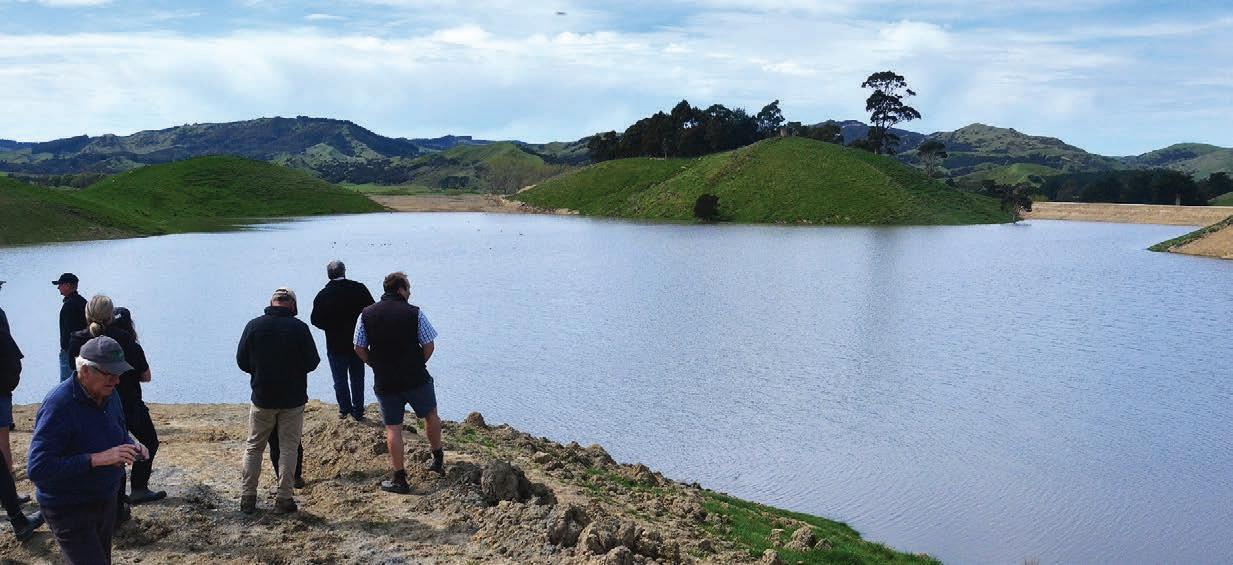
create jobs, generate wealth, and can be invested to improve other environmental outcomes.
“The problem is that our current resource management laws simply aren’t supporting these developments and new water storage projects can be held up for decades in court stalling progress and frustrating applicants,” Hurst said.
Feds says the next Government must:
• Develop a National Policy Statement on Water Storage to unlock economic growth and support climate resilience.
• It’s time to give back control to local communities

The last 10 years has seen a significant shift in responsibility and accountability away from local communities towards unelected Wellington officials – we’ve seen it with everything from health reforms and education through to Three Waters and RMA reforms.
“We’ve even seen it with freshwater reforms where Wellington tried their hand at farming by writing one-size-fits-all national rules for things like winter grazing, pugging,
and nutrient limits. On each of those counts the rules have proven totally unworkable,” Federated Farmers President Wayne Langford said.
“Whenever we raise these concerns with Wellington officials we are told that small rural towns just don’t have the capability or capacity to do such complex things – yet on every occasion Wellington has taken something over they have made it worse than it was to begin with!”
Federated Farmers argues there is no reason to believe Wellington has a unique ability to determine what water quality levels we should all achieve. Communities from Northland to Southland are more than capable of working out what improvements are needed and how they might be able to achieve them.
“National bottom lines just force local communities to chase improvements that might make no sense in a local context. For example, improving nitrogen levels in catchments where nitrogen doesn’t drive water quality,” Langford said.
Feds says the next Government must:

• Trust local communities to make decisions about local issues

PODCAST 20 September 11, 2023 – fedfarm.org.nz Federated Farmers 24
KEEP IT FLOWING: More investment in water storage is good for the economy and the environment. Wairarapa farmer Len French created this 13ha water reservoir on his property but it was a huge and labyrinthine battle to get it consented; many others would have just given up.
Halt the centralisation of local services
• Give back control to local communities to decide their own future

• In terms of unworkable freshwater rules it must:
Repeal the unworkable Essential Freshwater rules
• Empower local communities and councils to determine local water quality goals
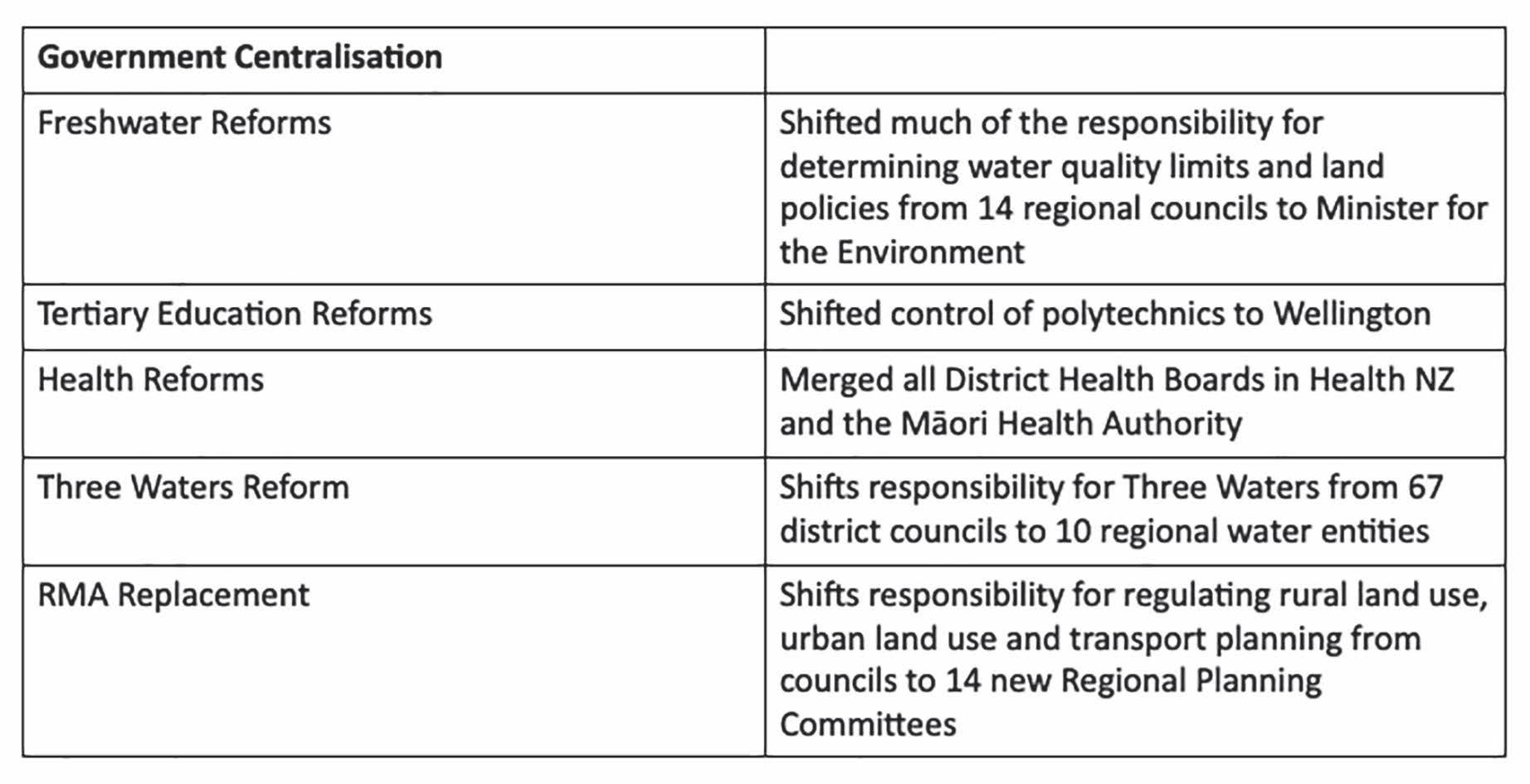
• Support catchment groups through consistent funding
• Utilise Freshwater Farms Plans as a tool to empower farmers to act
• Stop and get it right on resource management
Farmers agree that RMA reform is needed. They’re spending too much time and money on costly resource consents and processes that are holding up investment in new water storage and rural infrastructure.

“Change is badly needed, but we are completely dismayed the replacement legislation rushed through as the election looms will make things worse than they already are,” Federated Farmers RMA spokesperson Mark Hooper says.
The legislation will see all decisions relating to land use, transport and urban planning shifted away from local councils to new ‘Regional Planning Committees’ who will be at arm’s length from voters and include co-governance.
Vague new terms and definitions
will cause further delays and costs and lawyers, councils and consent parties are forced to fight it out in the courts to get some clarity.
“Unfortunately, it seems the new legislation will be more cumbersome and confusing than the old - and farmers will find it harder, not easier, to get things done,” Hooper said.
Feds says the next Government must:
• Repeal the Natural and Built Environment and Spatial Planning Acts
• Commit to replacing the RMA with legislation that removes red tape and reduces compliance costs.
• Significant Natural Areas should be significant Issues relating to Significant Natural Areas have arisen due to inconsistent approaches taken to defining what is ‘significant’ across different districts and regions, so Federated Farmers supports a national direction on biodiversity to tighten up definitions and provide some alignment to minimise costs and delays from unnecessary litigation.
Government needs to be careful not to create barriers for people who want to protect and enhance native vegetation on their farm: farmers are less likely do this if they fear it will create a rod for their own backs, Feds environment spokesperson Colin Hurst says.
“Over-regulation will just drive perverse outcomes, including excessive costly and time-consuming litigation.

“We don’t want to see a situation where landowners are reluctant to voluntarily protect significant biodiversity or disclose the presence of fauna on private land. We also don’t want to see people choosing to plant exotic vegetation because choosing indigenous vegetation gets ‘too hard’, which in turn undermines trust in private landowners to do the
right thing,” Hurst said. Voluntary protection has multiple benefits, including promoting willing stewardship and honesty, and it’s also more likely to achieve wider protection of biodiversity than is possible with regulation.
Feds says the next Government must: Release a National Policy Statement for Indigenous Biodiversity that sets clear rules for defining areas of significant native vegetation
• Call to urgently review our methane targets
New Zealand has adopted a ‘split gas’ approach to climate change targets which includes a net-zero target for long-lived gases such as carbon dioxide and a 24 to 47 per cent by 2050 reduction target for biogenic methane.
Federated Farmers supports this approach because it reflects the different warming impacts of various greenhouse gases.
As a short-lived gas, biogenic methane only persists in the atmosphere for around 12 years. This means that if we are emitting a constant or slightly falling level of methane, the amount we are
emitting is equal to the amount naturally being removed from the atmosphere, so the climate impact is neutral.
The Feds Election Platform calls on the next government to urgently review our methane reduction targets.
“As they currently stand the targets go further and faster than what is needed to achieve ‘no further warming’ and will come at a huge cost to farmers and rural communities,” President Wayne Langford said.
A review of methane targets is one of Feds’ firm bottom lines before any price is put on agricultural emissions. Another is that pricing only be for the uptake of viable and costeffective mitigations, and that there will be no emissions leakage.
Feds says the next Government must:

• Set methane targets that reflect the principle of achieving ‘no further warming’
Apply the ‘split gas’ approach to New Zealand’s emissions budgets and international targets Not implement a price on agriculture emissions until Feds three bottom lines are met
FEATURING A WEEKLY CONVERS ATION WITH FEDERATED FARMERS
FARMERS
LISTEN NOW
25 fedfarm.org.nz – September 11, 2023
25
Federated Farmers
Don’t deny farmers new tech tools
Repeated calls by Federated Farmers for a review of the regulatory environment relating to gene editing and assessing new agri-compounds are gaining traction among political parties.
Federated Farmers wrote to all political parties in Parliament earlier this year requesting they commit to reviewing GMO rules. Support for better use of technologies to enable farmers to meet challenges such as reducing greenhouse gas emissions was also one of the 12 policy priorities for the next Government outlined in the Federation’s 2023 Election Platform.
President Wayne Langford said it’s unacceptable to farmers, damaging to the economy and ultimately selfdefeating in global warming terms given production ‘leakage’, if any government’s solution to driving down livestock methane emissions centres on reducing production.
Federated Farmers argues that option is even more foolish when other potential tools are blocked, or the regulatory pathway is so convoluted and costly that they’re long delayed or even never pursued – at least not in New Zealand.
The National Party’s ‘Harnessing Biotech Plan’ would end New Zealand’s effective ban on genetic engineering (GE) and genetic modification (GM), create a dedicated regulator for such technologies, and streamline approvals for trials and use of nonGE or GM biotechnologies. Potential coalition partner ACT has also talked about liberalising GE laws.
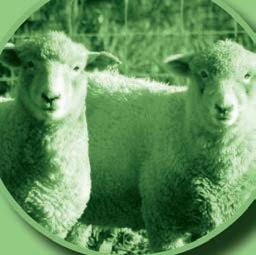
Greens Co-Leader and current Climate Change Minister James Shaw, speaking at the Oceania 2035 Summit last October, also acknowledged the need for an informed debate on the role of gene editing. Farmers Weekly reported him as saying the debate around GE remains stuck in the 1990s transgenic era, despite the technology having moved well past that point.
Labour remains cautious. While it recently opened up consultation on relaxing settings for GM organisms used in lab settings and for biomedical therapies, it said there was no proposed change to rules that relate to field trials or release of GMOs in plants for animals.
Like the Greens, Labour questions the reaction of our overseas primary produce export markets should we be seen as no longer “GE-free”.
This is despite John Carradus of AgResearch’s Grasslanz Technology pointing out our largest customer, China, has no qualms about importing food goods from Australia, which has looser GM laws than ours, and is the world’s biggest buyer of soybeans, mainly for stock feed, and most if it from GM-variety crops in the US and South America.
ryegrass, shown to have potential to reduce methane emissions by 10-15% from livestock that eats it while also maintaining nutrition and having greater drought tolerance. AgResearch was forced to take field trials offshore to the USA.
But the HME ryegrass is by no means the only example. AgResearch’s work on gene editing to achieve greater levels of condensed tannins in white clover, also with potential to reduce biogenic methane emissions from the animals that eat it, was also taken offshore for field trials because of our regulations.
Writing for Famers Weekly earlier this year, Malcolm Bailey described the AgResearch Endophyte Gene Editing Programme, which is aimed at producing grasses with endophytes that are better at deterring a range of bugs from eating them while being more palatable and safe for our farmed animals.
He reported it was going extremely well and running ahead of schedule but has moved past what can be done in containment glasshouses in NZ.

 Malcolm Bailey AgResearch
Malcolm Bailey AgResearch
Genetic technologies in New Zealand are controlled by the 1996 Hazardous Substances and New Organisms (HSNO) Act. It is widely criticised as being out of date, with legal and scientific definitions increasingly misaligned.


Proponents point to new gene editing tools like Crispr Cas-9, which enables organisms to be tweaked without introduction of genetic material from others.

There are plenty of scientists who say the rules are too restrictive; there has been no application for a GMO field test put in front of the Environmental Protection Authority for a decade.
The case most often cited is that of AgResearch’s gene-edited high metabolisable energy (HME)







“For field trials, it has had to shift to Australia where the regulations regarding gene editing are far more enlightened than in NZ. A future pathway to commercialise this breakthrough advance in NZ is very uncertain because of our outdated regulations,” Bailey said.
The feed additive Bovaer, or 3-NOP, is not a GE technology but it is a chemical new to New Zealand –one that its maker, DSM Nutritional Products, says can reduce methane emissions from ruminant animals, including cows, sheep and goats, by 30 percent.



Earlier this month our EPA approved it, long after it was cleared for use in 45 other countries overseas. It still has to gain approval from MPI, which will conduct assessments for efficacy, animal welfare and the potential for residues in food.
STRENGTH
Allow Kiwi farmers to use GE grass



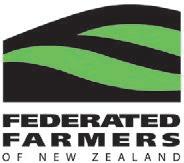

Public poll December 2022
MOVING ON: Some politicians may be dragging the chain on reviewing the 1996 legislation setting our rules for genetic modification but public sentiment is moving ahead of them.
In a survey late last year, 1000 New Zealanders were asked: Do you think NZ law should allow the use of genetic modification technology? The results were split: 35% said yes, 37% no and 28% were unsure. A completely different separate group of Kiwis (to ensure their answer wasn’t influenced by the earlier question) were asked: New Zealand scientists, using genetic modification, have developed a new type of grass that can reduce greenhouse gas emissions and water pollution from cattle and sheep. This grass is being trialled overseas due to NZ genetic modification laws. Do you think Kiwi farmers should be given the choice of using this new grass if they wish? 72% said yes, while just 15% were opposed (13% were unsure). This shows that Kiwis think we should use GMO where there is a clear benefit.
Federated Farmers says potential for methane reduction isn’t the only reason it’s pushing for a review of New Zealand’s GMO rules. Genetic modification can be used to produce sterile pine trees, reducing the risk of wilding pines. There may be opportunities to improve the nutrition of fruit, grain and vegetables, and help us with our
Predator-free 2050 ambitions.

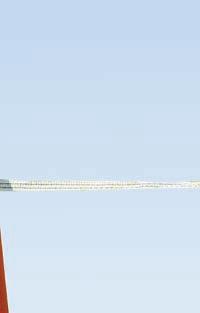
Federated Farmers says the next government must:
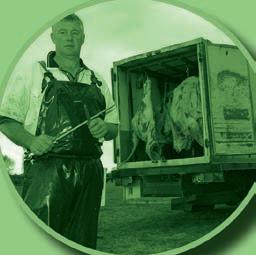


• Streamline EPA processes so new agri-compounds have a clear path to approval
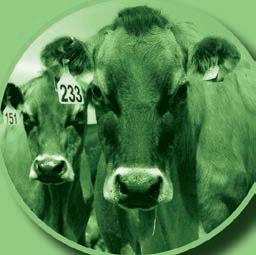
• Reform rules governing when farmers can use gene-edited cultivars.
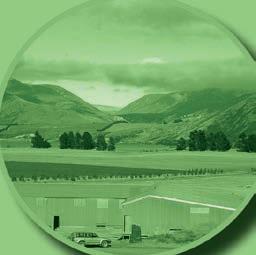
NUMBERS.
26 September 11, 2023 – fedfarm.org.nz Federated Farmers 26
Chart Title 1 2 3
Unsure 13% No 15% Yes 72%
A future pathway to commercialise this breakthrough advance in NZ is very uncertain because of our outdated regulations.
IN
ARABLE HIGH
COUNTRY
GOATS RURAL BUTCHERS MEAT AND WOOL DAIRY
JOIN
0800 327 646 fedfarm.org.nz
When it comes to farmer advocacy, there is strength in numbers. And that number is one.
TODAY!
Come join us
as we celebrate the sector and announce the winners at the 2023 B+LNZ Awards Dinner.
Te Pae Christchurch Convention Centre, 6pm, 19th October.

Tickets are on sale now
Scan here to find our more or visit beeflambnz.com/finalists

As well as finding out who the winners are of the eight Award categories, it will be an opportunity to meet the finalists and celebrate the people, innovations and science that make our red meat sector world-leading.
2023 finalists are:
Ballance Agri-Nutrients


Science and Research Award
• AgResearch Life Cycle Assessment Team
• Forage Trials Willesden

• Low Methane Sheep Genetics Programme
Datamars Livestock Technology Award

• Bidr Ltd
• Cloudyards Ltd
• Silver Fern Farms/Lynker Net Carbon


Zero Mapping Tool











Gallagher Innovative Farming Award
• Reata Ltd
• Repost Ltd
• Wharetoa Genetics
Silver Fern Farms Market Leader Award

• Ongaha
• Pearl Veal
• Verry Farming Ltd
AgResearch Emerging Achiever Award
• Amy Hoogenboom
• Harriet Watson
• James Robbie
Rabobank People Development Award
• Growing Future Farmers
• New Zealand Rural Leadership Trust

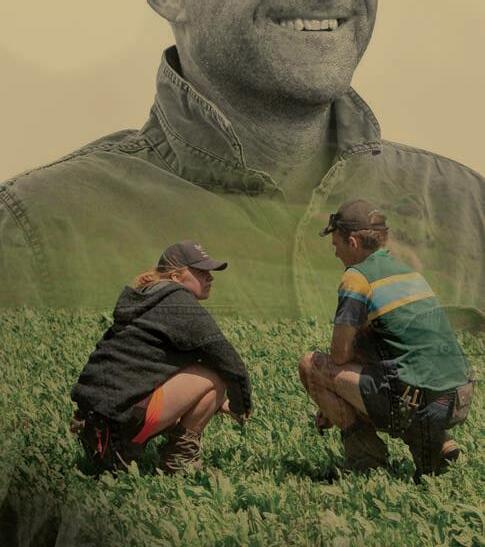

• Whangarei Agricultural and Pastoral Society Farm Intern Programme
FMG Rural Champion Award

• Greater Dipton Catchment Group
• Shepherdess
• Surfing for Farmers
Alliance Significant Contribution Award
• Bob Cottrell
• Mike Petersen
• Tom Fraser
Thank you to our Awards partner Farmlands and the Award Category Sponsors.
Awards Partner
Category Partners
27 World
In promo�ng the BALLANCE board elec�ons� we sent a �ues�onnaire to all 8 candidates. There are two board posi�ons to be �oted on.
Full details at www.groundswellnz.co.nz
Do you support an emissions tax on NZ farmers?
DANI DARKE: I respec�ully decline. My approach is to communicate one on one with shareholders, I have also provided a website for shareholders to get more informa�on about what I stand for.
ALLISTER BODY: As an ac�ve farmer and Ballance shareholder, I am aware of the wide range of challenges our sector faces. With respect to your specific ques�ons, I believe it is important for candidates in elec�ons to choose the methods that they believe will be most effec‐�ve in reaching their cons�tuents. To this end I am going to re‐spec�ully decline to complete your ques�onnaire. My preference is to engage with shareholder on a one-on-one basis and I have provid‐ed mul�ple contact op�ons such as phone, email, Facebook � LinkedIn on my campaign material. This allows shareholders to reach out through their preferred communica�on channels and effec�vely engage with me on a wide range of issues.
GEOFF CRAWFORD: No, I do not. I believe if our overseas compe�‐tors aren’t charging emission tax, then why would NZ be first. I don’t believe we need to be world leaders when sequestra�on op�ons need to be addressed and agreed to first. Sequestra�on rules need to be more equitable for all landowners. For example, Northland has a large percentage of our na�ve forest is in a juvenile form, regener‐a�ng from pre-Colonisa�on to today. This needs to be accounted for, which would probably make Northland Carbon Neutral
KIM LORIGAN: No I don’t support this tax in any form – it is clearly a bias tax, and lacks understanding. Food processing including farm‐ing was not part of the Paris Accord. We are not sure why this tax is applied to our farmers. Farmers are a easy target, there is not that many of us and poli�cally it is easy to force and penalise a few than effect the majority of a popula�on.
ANDY GRANT: No. I don’t know any farmer / food producer that would want to pay a tax. (A levy as the Government calls it)
JAMES HOBAN: No. Our consumers are demanding that we reduce emissions and we have already been doing that – both gross emis‐sions and in terms of emissions efficiency rela�ve to produc�on. Be‐cause we are on a downward trajectory already, I don’t see the basis for an emissions tax at this point in �me.
LACHIE JOHNSTONE: I don't support any regulatory interven�on that affects any one group dispropor�onately. NZ Food produc�on is widely recognised as having a lower environmental impact than oth‐er na�ons. Why would we put this at risk, for the sake of poli�cal expediency. It makes no sense to undermine our ability to deliver the best food to the world.
JARED COLLIE: I appreciate the opportunity you have provided with the aim to promote the upcoming Ballance board of directors elec‐�on. For this elec�on I have provided mul�ple op�ons for sharehold‐ers to contact me on a one to one basis, therefore I am going to respec�ully decline your invita�on.
THANK YOU to all candidates for taking part

Do you support an emissions tax on NZ farmers?
BRYAN PEDERSEN: NO� I am yet to find any factual scien�fic evidence that NZ �airy farmers are the prob‐lem when it comes to the Emissions debate. I have had the honour of talking to expert Scien�sts, like Tom Sheahan. “Sta�ng there is more evidence to say we are more likely carbon neutral” and “Methane isn’t a dangerous gas” Methane is broken down easily in atmosphere. Methane is an overstated gas. There are plenty of qualified scien�sts sta�ng these same facts. B�T they are not ge�ng media coverage. Why�
SHANE ARDERN: No, I do not support an emissions tax on farmers and my record on this is well known with my tractor protest on Parliament steps.
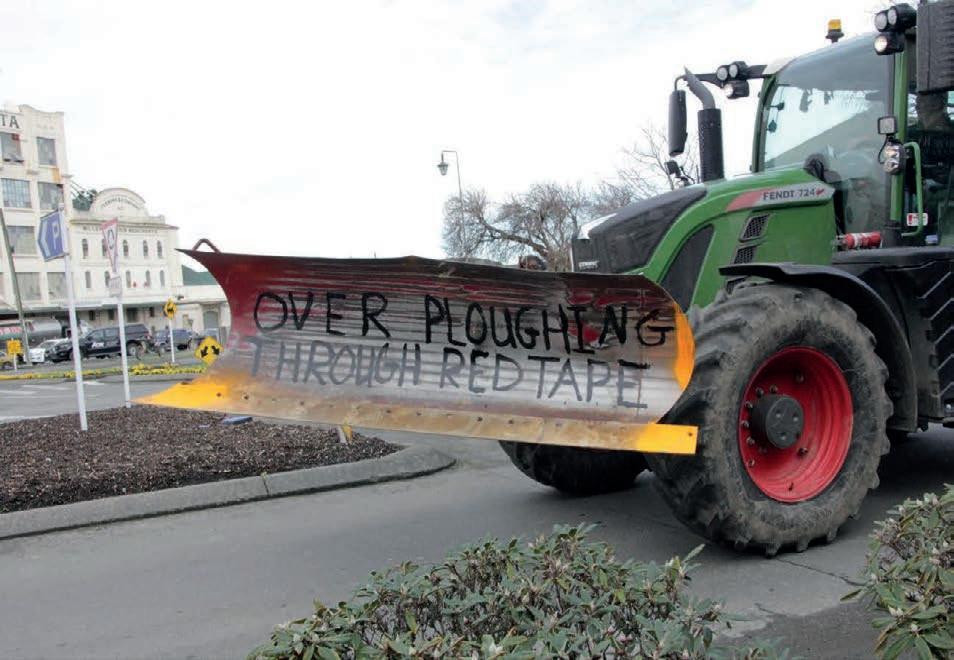
GRAY BALDWIN: No
PAUL MANION: No
JIM VAN DER POEL: Firstly, I do not support Agriculture going into the ETS. Present legisla�on has Agricul‐ture going into the ETS in �0��. This legisla�on will need to be changed by whoever the new government is to prevent that from happening. I do support all farmers knowing their numbers. By every farmer knowing what their own emissions number is they can then make on-farm decisions that help them reduce their emissions if they choose. They can also compare with their fellow farmers and poten�ally find efficiencies. All farmers will know their numbers by the end of �0�4. I support a na�onal calculator that has one stand‐ard measurement. At the moment there are I believe� �� different calcula�ons being used. With one stand‐ard measurement we can track our collec�ve progress. I do support the industry working collabora�vely to fund ��� to find mi�ga�ons. At this point we appear to be tracking well and there is no need to levy farm‐ers from what I can see.
CAMERON HENDERSON: No
CONALL BUCHANAN: No. Poorly designed taxes that are a simply a penalty on the world’s most emissions efficient pastoral sector makes no sense. Programmes with incen�ves and penal�es that drive posi�ve prac�cal benefits will be more effec�ve.
JASON HERRICK: No, I do not- Why should we penalise the world’s most efficient farmers, that only leads to emissions leakage and the country as a whole being worse off just to appease Ideologists.
SEAMUS BARDEN: I do not support the current proposal for the Emissions Tax on NZ Farmers. However, I do support emissions-based levies as a means of driving the behaviour we need to reduce climate change over the coming years. This should occur across all industries - not just farming. Climate change will impact all areas of our lives. Consumers, and therefore the businesses that service those customers, will call for climate change policies, levies, fees and taxes, so it is likely all industries will see an element of these affec�ng the way they conduct their business. As an industry, the key is to ensure these taxes or levies are well planned and are a true re�ec�on of our environmental cost (and not part of businesses trying to offload their carbon footprint to farmers). These costs also need to be introduced in a controlled manner with plenty of no�ce so businesses can adjust to absorb the costs. As we are already amongst the cleanest and most efficient farmers in the world, we do not need to be on the bleeding edge of these policies. How‐ever, it would be naive to think we will not have to contribute at some stage, so let's make sure we are at the table helping shape and inform those discussions.
JEREMY SAVAGE: Farmers should be incen�vised to improve GHG emissions, not taxed. NZ has a unique profile with 40% of GHG emissions from Agriculture. With good science, management and technology farmers could help NZ achieve the Paris Accord Agreement targets. This is an opportunity for New Zealand, but it has not been recognised. �se a carrot approach, not a s�ck.
JESSIE CHAN: no reply
STU MUIR: no reply
JAMES BARRON: no reply
In promo�ng the upcoming DAIRY NZ elec�ons� Groundswell sent a �ues�onnaire all �� candidates. There are two farmer director posi�ons to be �oted on. Here is a sample of the answers.
Make sure you check out full questionnaire at www.groundswellnz.co.nz or email hello@groundswell.org.nz if you’d like a copy emailed or posted to you. Make an informed vote and have your say in helping to shape our industry. See the full list of �ues�ons and answers on our website www.groundswellnz.co.nz 28
Real Estate
Cambridge
36 ha plus a unique business opportunity
• New Zealand's only Medical Leech Supply business
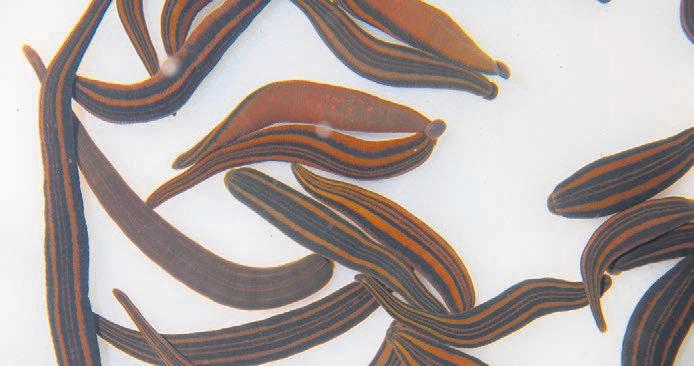
• Proven, consistent income stream
• 36 ha of easy rolling to medium hill farmland - well farmed


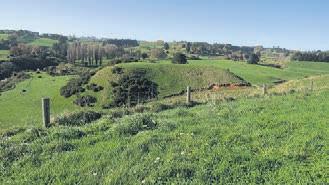
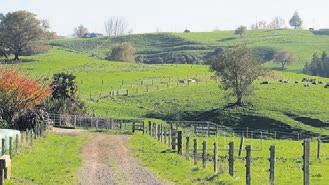
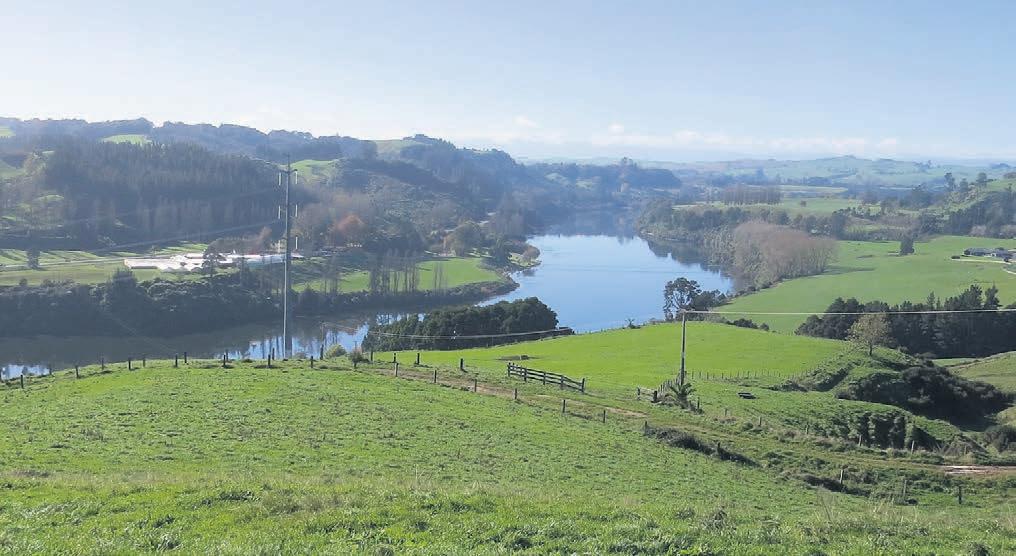
• Attractive three bedroom home with large office
• Plenty of tidy outbuildings
• 5.8 ha of QEII woodlots
• Immaculately presented throughout
Deadline Sale
Advertise with us
Reach hundreds and thousands of rural New Zealanders every week Call 0800 85 25 80 realestate@agrihq.co.nz




Deadline Sale closes Thursday 12th October, 2023 at 4.00pm, (unless sold prior)
View By appointment Web pb.co.nz/CBR167017
David McGuire M 027 472 2572 E david.mcguire@pb.co.nz
John Sisley M 027 475 9808 E john.sisley@pb.co.nz

Lake side beauty!
A property, the likes of which, you are unlikely to find anywhere else. Bound by Lake Karapiro along its eastern boundary, with quite easy vehicle access right to the river's edge and 3 - 4 amazing sandy beaches at your disposal. The potential for recreational use of this area needs to be seen to be appreciated. The contour is, in the main, easy to rolling with some steeper sidlings. Interested parties need to inspect this property at their earliest convenience. Lots of options with a recently decommissioned (2.2 years ago) dairy shed, three homes, long road frontage, lots of good contour and of course, direct access to the lake.
Auction
Auction 11.00am, Wed 11th Oct, 2023, (unless sold prior), Property Brokers, 94 Duke Street, Cambridge View By appointment Web pb.co.nz/TWR163250
John Sisley M 027 475 9808

David McGuire
027 472 2572
Maungatautari 128 + 248 Stokes Road
Property Brokers Ltd Licensed REAA 2008 | pb.co.nz
M
Property Brokers Ltd Licensed REAA 2008 pb.co.nz
Property
29
– September 11, 2023
FARMERS WEEKLY – farmersweekly.co.nz
29
Stake your claim in Bayleys’ Country portfolio – New Zealand’s leading multi-channel real estate campaign, showcasing the finest rural and lifestyle properties for sale nationwide.
The start of spring, traditionally the busiest on the real estate calendar, means more eyeballs on New Zealand properties, with the growing season presenting an excellent time to maximise your seasonal advantage as a seller of rural real estate.


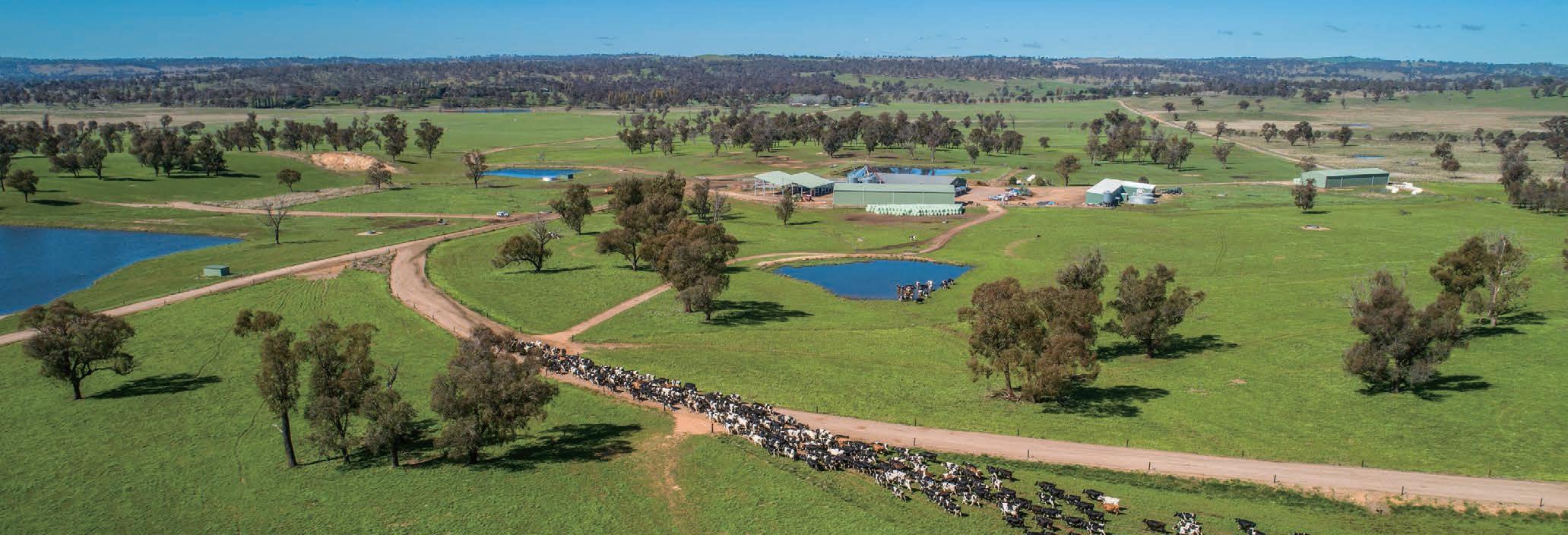
As one of the most effective and exclusive marketing channels Bayleys’ national portfolio, Country - spanning print, digital, social media and direct marketing - reaches further. This provides exposure to our extensive network, and international database of qualified buyers, designed to deliver an ‘Altogether Better’ sales result.





Kiwi-owned and operated for 50 years, Bayleys is innately New Zealand and proud to be the country’s #1 rural real estate brand, consistently utilising innovative marketing techniques to be the difference between a good and great result for the sale of your rural and lifestyle property. Find out how to realise your rural property’s potential with Bayleys Country this spring.

For Sale 12975 and 14135 Thunderbolts Way, Walcha
2354, Australia Tired of fluctuating export milk prices? How does $13 AUD per kilogram of milk solids for three years sound? James Beer +61 416 859 565 Bob Coote +61 409 757 765 Nick Connor +61 400 830 818 Thomas Quinn +61 429 822 228 626ha* across two properties Currently milking 1,000* cows Producing up to 8 million* litres per annum Excellent fitfor-purpose infrastructure www.colliers.com.au/WalchaDairy *Approx Residential / Commercial / Rural / Property Services
NSW
2023 bayleys.co.nz/country-portfolio Bayleys’ Country New Zealand’s premier rural property portfolio showcasing quality farms, orchards, vineyards, forestry and lifestyle properties for sale Be part of Bayleys’ next Country campaign, New Zealand’s leading multi-channel rural property portfolio and we will deliver an altogether better result. CONNECTING PEOPLE WITH PROPERTY LICENSED UNDER THE REA ACT 2008 Call 0800 BAYLEYS or visit bayleys.co.nz/country 30 FARMERS WEEKLY – farmersweekly.co.nz – September 11, 2023 Real Estate 30
As an AgriHQ Partnership Manager representing Farmers Weekly, Dairy Farmer and AgriHQ Insights you’ll have great relationship building and customer service skills, be an awesome communicator, and will always nd a way to get the job done.

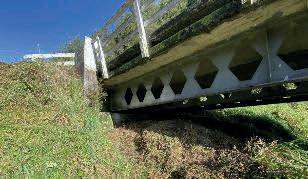

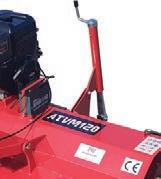

We’re looking for someone who is self-motivated, LOVES people, and is passionate about the food and bre sector. Sales experience is not necessary, but would be an advantage!

If this sounds like you, then we’re keen to talk. And for you to come and meet our innovative and energised team.

For more information about the role contact hr@agrihq.co.nz or visit agrihq.co.nz/careers












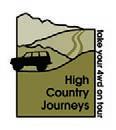

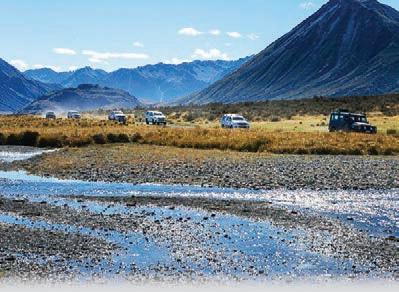
Applications close: Tuesday September 12, 2023. O ce location exible.









Find primary sector vacancies at: farmersweeklyjobs.co.nz To advertise phone Debbie 06 323 0765 LK0115404© TWO STUNNING 4WD SELF DRIVE OPTIONS South Island High Country Grand Slam Self drive your own 4WD from Blenheim to Cardona in Central Otago through a network of high country tracks including Molesworth on this 7 day 8 night tour. NOW TAKING BOOKINGS FOR 2024 SEASON Contact John Mullholland Phone 027 228 8152 • RANFURLY info@highcountryjourneys.co.nz www.highcountryjourneys.co.nz The Great Explorer Self drive from Lake Ohau to Cardrona through the majestic high country and Tussockslands of the Mackenzie Basin, Central Otago and Northern Southland with this 5 day 6 night tour. LK0116434© HIGH COUNTRY JOURNEYS Drive from station to station and experience the majestic South Island High Country Heavy duty, long lasting incinerators Three sizes available Phone 021 047 9299 irontreeproducts.co.nz JW114362© GO THE MOA! To find out more visit www.mowermaster.co Phone 0800 422277 or 028 461 5112 Email: mowermasterltd@gmail.com Towable Flail Mower 14.5HP. Vanguard Briggs & Stratton Motor. Electric start. 1.2m cut 3 year Briggs and Stratton Commercial Warranty. 2 year Mower Master Warranty LK0116486© $4900 GST INCLUSIVE MOWER MASTER TOWABLE MOWERS Assembled by Kiwis for Kiwi conditions – built to last.
is celebrating
birthday
year
we’re
Partnership Manager Farmers Weekly
its 20th
this
and
looking for someone new to join the party!
the team! LK0116500© BRIDGE & STRUCTURE MAINTENANCE Farm bridges and structures showing signs of age? Don't let these valuable assets deteriorate any further ! ben@waterhousecc.co.nz 027 559 7168 Providing affordable repair & maintenance solutions for your expensive assets. Waterhouse Complex Civil are specialists in repairing & maintaining bridges, stock underpasses, culverts, & waterway remediation LK0116573© 4X4 TAGALONG
Bring your own 4X4 on a guided tour to discover more of the South Island. Tour 1: Molesworth Station, St James, Mailings Pass & Rainbow Stations Dates: 2023 – Nov 13-16 2024 – Feb 19-22, March 4-7, March 11-14, March 25-28 April 8-11, April 22-25 Tour: 2 D’Urville Island and Marlborough Farms Tour Dates: 2024 – Feb 11-15, March 12-16 FULL, April 24-28 Other dates available for groups of 6 or more people on request Ph: 0274 351 955 E: info@southislandtoursnz.com • www.southislandtoursnz.com WATER TANKS, PUMPS & FILTRATION BEST QUALITY | BEST PRICE | BEST ADVICE Call now for a better deal P: 0508 326 8888 30 Turners Road, Feilding thetankguy.co.nz DEVAN • RX • CALPEDA • AQUA • OASIS CLEARWATER LK0116441© 31 Marketplace FARMERS WEEKLY – farmersweekly.co.nz – September 11, 2023 Marketplace 31
Join
TOURS
Phone 027 367 7832.

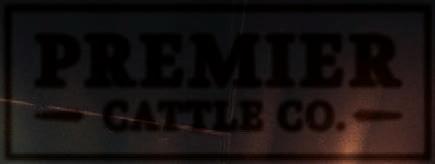
DOGS FOR SALE

3 HUNTAWAY DOG pups. 10 weeks old. Hill country and station breeding. Raetihi. $400 each. Mike Rogers, Phone 027 252 6793.

BLACK AND WHITE heading bitch, 14 months old. Has trial potential. $1000. Phone 06 382 5800.
HEADING PUPS. Strong eye. Father tricolour, Bitch straight Black/white. Three dogs, one bitch. $350.00 each, good working parents. Phone 027 476 2579 / 07 871 9934.
WELL BRED HEADING eye pups 10 weeks old. Sires line by A.Owens Cap(World Champion). Dams line to B Areands Roy. Vaccinated and wormed up to date. $600.00. Ph 021 557 119. G Strawbridge Waikato.
HEADING DOG PUPS. Good lines, 9 weeks old. $250. Marlborough. Phone 03 578 8397. YOUNG HUNTAWAYS AND Heading dogs. Top working bloodlines. Check out our website www. ringwaykennels.co.nzRingway kennels.
HORTICULTURE
DAIRY OR GRAZING FARM wanted. Open to leasing, equity, share farming or developing land in partnership. Rangitīkei, Manawatū or HB areas. Phone Michael 027 223 6156.

WORD ONLY ADVERTISING. Phone 0800 85 25 80.


THE GULLIES WILTSHIRE & Low Input Rams. SIL; FE and worm tolerance. Richard Morrison Phone 021 626 513. richard@thegullies.nz www.thegullies.nz



BROOKLAND SIMMENTAL, LBW, short gestation, bulls, suitable for beef or dairy, EBV’s available. Phone 06 374 1802.

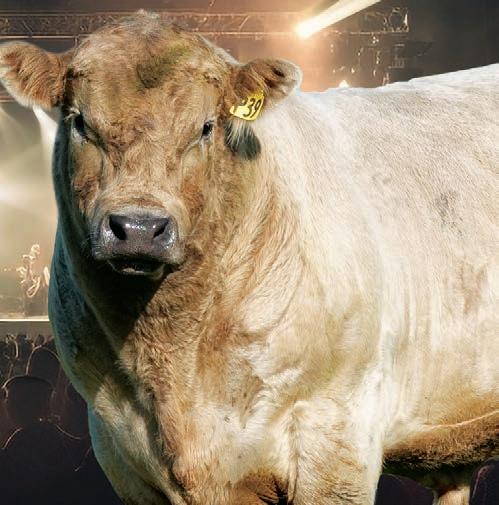

PUMPS
HIGH PRESSURE WATER PUMPS, suitable on high headlifts. Low energy usage for single/3-phase motors, waterwheel and turbine drives. Low maintenance costs and easy to service. Enquiries phone 04 526 4415, email sales@hydra-cell.co.nz

RAMS FOR SALE


WILTSHIRES-ARVIDSON. Self shearing sheep. No1 for Facial Eczema. David 027 2771 556.

WANTED TO BUY

HOUSES AND SHEDS for shifting, relocating and removal. Phone 020 473 2394.

WANTED TO LEASE SHEEP AND BEEF breeding farm. Approx 600-1000ha plus. Hunterville, Taihape, Hawke’s Bay, Dannevirke, Pahiatua, Gisborne and Wairoa areas. Experienced Leasee. Contact Pete Hammond. Phone 027 412 1466. trekh.b@xtra.co.nz


Orders to: 03 322 6115 or info@nzkelp.co.nz
HYPNOTHERAPY


FARMING FAMILIES, online hypnotherapy support for everyday challenges. Contact Shirley Henderson at shirl@ shirl.nz for a chat. For more info: http://www.facebook. com/handsforhealthnz

32 Marketplace 32 Livestock Under Woolshed/Covered Yards Cleaning Specialists www.underthewoolshed.kiwi SCOTTY’S
NOW WORKING IN HAWKE’S BAY / WAIROA / GISBORNE AREAS ✁ Contact Scotty to discuss all that needs to be done Ph 0800 27 26 88 • Mobile 027 26 26 27 2 • scottnewman101@gmail.com ✁ LK0116479© New Zealand’s Number 1 service provider since 2004 Digging out and remetalling cattle yards and calf sheds. Also specialising in flood damage and silt removal. F I L L Y O U R B A G S Y E A R L I N G B U L L S A L E 2 0 2 3 ~ 2 2 N D S E P T E M B E R , 1 2 P M O N F A R M A T T U T I R A 28 SEPTEMBER 2023, 12 NOON 400 Brunskill Road, Cambridge 25 SPECKLE PARK • 10 MURRAY GREY Speckle Park & Murray Grey Yearling Bull Sale Auction Livestream Auctioneer Kelly Higgins 027 600 2374 Stud Stock Services Bruce Orr 027 492 2122 DEREK HAYWARD M: 027 226 6686 E: derek.premier@farmside.co.nz DOLOMITE For a delivered price call .... NZ’s finest BioGro certified Mg fertiliser 0800 436 566 ATTENTION FARMERS ZON BIRDSCARER electro-tek@xtra.co.nz Phone: 06 357 2454 ELECTRO-TEK ENGINEERING Check out Poll Dorset NZ on Facebook nzsheep.co.nz/poll-dorset-breeders LIVESTOCK FOR SALE FLY OR LICE problem? Electrodip – the magic eye sheepjetter since 1989 with unique self adjusting sides. Incredible chemical and time savings with proven e ectiveness. Phone 07 573 8512 www.electrodip.com ANIMAL HANDLING CRAIGCO SHEEP JETTERS. Sensor Jet. Deal to y and Lice now. Guaranteed performance. Unbeatable pricing. Phone 06 835 6863. www.craigcojetters.com BALAGE FOR SALE EXCELLENT QUALITY, $80 per bale plus GST. Unit loads available. Phone 021 455 787. THIS SEASON’S QUALITY balage. 300 x $70 a bale, including gst. Located central NI.
CONTRACTORS
Phone 027 248 7704. WANTED NATIVE FOREST FOR MILLING also Macrocarpa and Red Gum New Zealand wide. We can arrange permits and plans. Also after milled timber to purchase. NEW ZEALAND NATIVE TIMBER SUPPLIERS (WGTN) LIMITED 027 688 2954 Richard. FORESTRY PROMOTES QUICK PASTURE growth. Only $6.50+gst per hectare delivered. 0508-GIBBGRO [0508 442 247] www. gibbgro.co.nz. “The Proven One.” GIBB-GRO GROWTH PROMOTANT GIBBOOST INCREASE PASTURE growth and dry matter. $5.50 per/ha ex store + GST. Phone 0508 733 343. www.vernado.co.nz GOATS WANTED. All weights. All breeds. Prompt service. Payment on pick up. My on farm prices will not be beaten. Phone David Hutchings 07 895 8845 or 0274 519 249. Feral goats mustered on a 50/50 share basis. GOATS WANTED FERAL GOATS WANTED. Pick-up within 24 hours. Prices based on works schedule. Phone Bill and Vicky Le Feuvre 07 893 8916 / 027 363 2932.
FOR SALE
BALES, 12 equivalent. $90+GST. North Waikato. Phone 021 083
NZ KELP. FRESH, wild ocean harvested giant kelp. The world’s richest source of natural iodine.
and
for use in agriculture and horticulture.
/ stock health food.
HAY
ROUND
31763.
Dried
milled
Growth promotant
As seen on Country Calendar.
BOOK AN AD. For only $2.30 + gst per word you can book a word only ad in Farmers Weekly Classi eds section. Phone 0800 85 25 80 to book in or email wordads@agrihq.co.nz
LAND WANTED FOR ONLY $2.30 + gst per word you can book a word only ad in Farmers Weekly Classi eds. Phone 0800 85 25 80. Advertise with us Call 0800 85 25 80 wordads@agrihq.co.nz
LEASE
Livestock
BEXLEY HEREFORDS Yearling Bull Sale
Friday 29th September 2023 at 12.00 noon
To be conducted at Bexley Station, 3715 State Highway 3, Awakino Gorge, Mokau 4376
Registered and Unregistered Bulls comprising of: 31 Yearling Pedegree Herefords, 6 Yearling Purebred Hereford, 5 Purebreed Speckle Park and 11 Yearling Purebred Angus
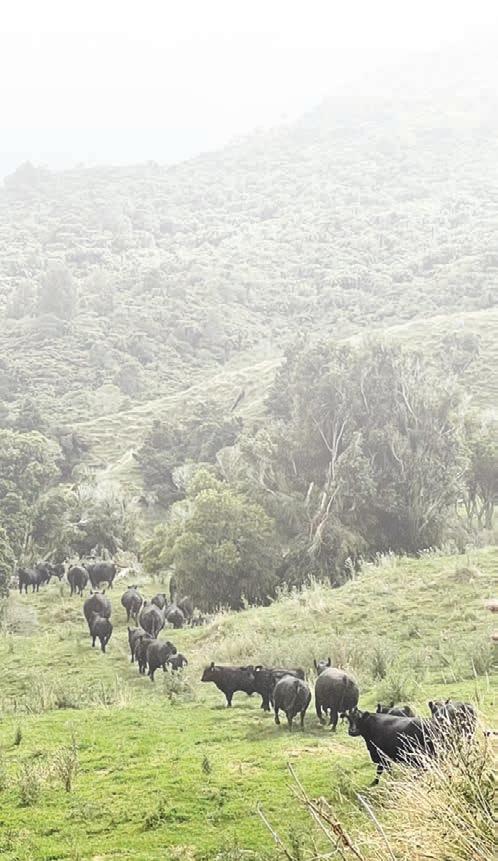
Top yearlings (460kg+) grown to suit heifer mating, cow mating or beef mating.
VENDORS: Colin & Carol King P: 06 752 9863 | E: ccking@farmside.co.nz
NZFL Stud Stock - Brent Bougen M: 027 210 4698

NZFL Agent - Stephen Sutton M: 027 442 3207




Carfields Agent - Grant Ross M: 021 174 8403

YEARLING BULL SALE
FRIDAY 22 SEPTEMBER 2023
Come be part of our annual Bull Sale & enjoy a cuppa or beverage with some good old fashioned home baking
ALL WEATHER SALE BARN AT: 679 Paradise Valley Road, Rotorua
Viewing from 11am with Auction commencing at 1pm Light luncheon provided
CONTACTS: Kevin & Janette Davenport 027 245 4106
PGG Wrightson: Finn Kamphorst – 027 493 4484 Cam Heggie – 027 501 8182
Bred for Calving ease & low birthweight
ANGUS NZ REGISTERED TB STATUS C10
LEPTO VACCINATED
BVD TESTED AND VACCINATED FREEZE BRANDED FOR ID


VET CHECKED FOR SOUNDNESS
Yearling Bull Sale
Tuesday 19th September 2023 at 12.30pm
To be conducted at Rolling Heights Farm
500 McDonald Mine Road, Waikokowai, Huntly
Comprising of:









11 2yr Purebred Hereford Bulls

32 1yr Purebred Hereford Bulls
Top yearlings (460kg+) grown to suit heifer mating, cow mating or beef mating.

Live Streamed with online bidding available on MyLiveStock (please register 48 hours before auction) www.mylivestock.co.nz
VENDORS: Colin & Carol King P: 06 752 9863 | E: ccking@farmside.co.nz
Contact Vendor: Cory Norman 021 024 12686
NZFLL Stud Stock: Brent Bougen 027 210 4698
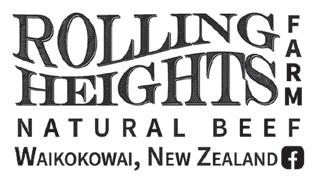
BLACK RIDGE

On-Farm
Yearling
Bull Sale
MONDAY 25TH
SEPT 2023 at 11AM
Sire Bulls:
Te Mania Buff 16314, Kaharau Jackpot Q307 & Kaharau Apex Q365
25 low birth, positive calving ease bulls for your heifer mating season Inspection and Enquiries always welcome. All bulls BVD vaccinated and tested. Lepto vaccinated. TB C10.
DEAN & TERESA SHERSON 675 Taringamotu Road, RD 4, TAUMARUNUI 3994 p: 07 896 7211 m : 027 690 2033
e: blackridgeangus@outlook.com Like
ANNUAL ON FARM SERVICE BULL SALE
•
•
•
•
THE





• 25x 2yr Friesian Bulls
• 2x 2yr White Head Bulls
To further protect your farm: All bulls are cell grazed for the past 12 months. No Dairy Grazers. TB & BVD Free. Free grazing till 1st December & deferred payment 20/12/23

Spot prizes and lunch provided Enquiries contact NZ Farmers Livestock Vendor Agent –Simon Payne 027 241 4585 or Vendor Hayden Megaw 027 440 9888 Or your local NZ Farmers Livestock Agent


Instagram: @megawfamilybulls Facebook: @Megawfamilybulls
LK0116515©

PREDICTABLE PROFITABLE PERFORMANCE GENETICS TE TAUMATA POLL HEREFORDS 33rd AnnuAl on fArm Bull SAle J une 7 th 2012 at 12pm To view our bull sale catalogue pictures of sale lots go to: www.tetaumata.co.nz free DelIVerY BVD VACCIn POLL HEREFORDS Est. 1962 Beef Alistair & CELEBRATING 50 YEARS HEREFORD BULLS FOR THE roWTH & meAT mIl Give us a call to discuss your ram requirements Romney and Border Leicester Rams Alistair & Eileen McWilliam Ph 06 372 7861 or 027 455 0099 www.tetaumata.co.nz Te Taumata Genetics LK0116550©
& JK MEGAW & FAMILY 190
Road,
Sale
AT 11:30am
HJ
Foreman Road, off Otaraoa
Tikorangi-Waitara 8th Annual
MONDAY 18TH SEPT 2023
BULLS
LINE UP — 337
COMPRISING:
50x 2yr Owner Bred Hereford Bulls
25x 2yr Angus Bulls
220x 2yr Jersey Bulls (all 2yr Virgin Bulls)
15x 2yr Ayrshire Bulls
and Find us on
Facebook
ANGUS STUD
33 Livestock FARMERS WEEKLY – farmersweekly.co.nz – September 11, 2023
33
7TH ANNUAL SERVICE BULL AUCTION DELAYED PAYMENT OPTION
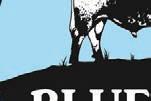

A/c Piquet Hill Farms Ltd

Date: Wednesday 13th September
Address: 887 Te Akau Road, Te Akau (West of Huntly) Start Time: 11.30am (under cover, lunch provided) will be available for online
LONG EST 35 YRS+ OWNERSHIP
ONE HERD CODE, 100% RA
IN-MILK FRIESIAN HERD
DEFERRED PAYMENT 20/12/23
A/c Killarney Pastoral Trust
Date: Monday 25th September 2023


Address: 113 Lower Katene Road, Normanby, South Taranaki DN 41801
Start Time: 11.30am (under cover lunch provided) will be available for online bidding
COMPRISING:
130 x Frsn/FrsnX I/M Cows
BW181, PW217, RA100%
DETAILS:
• Herd Tested 13th September 2023, Milked twice a day Herringbone Shed.
• Current season SCC Av 85,000 up to 20th August 2023, 430 MS/Cow System 2, Calved from 12/7, C10 Closed System, Owner Operated.
AUCTIONEERS NOTE:
16th ANNUAL IN-MILK AUCTION
HIGH INDEXED A2/A2 COWS
VERIFIED BW252, PW377, LW376

A/c Finch Contracting
Date: Thursday 21st September
Address: 972 Paterangi Road, Te Awamutu
Start Time: 11.30am (under cover lunch provided) will be available for online bidding
COMPRISING:
237 x Friesian & Friesian Cross & Jersey Cross Cows

DETAILS:
• BW252, PW377, LW376 herd tested, A2/A2 tested
• 25th August herd test – 1.62kgs
MS/Cow – SCC 76,000
• BWs up to 398, PWs up to 841 (14x cows with PWs above 700)
• Breed breakdown, 20% Friesian 50% Crossbreed & 30% Jersey


AUCTIONEERS NOTE:
• All bulls are TB tested, inoculated and BVD tested.
• All bulls are double vaccinated for pink eye with Piliguard.
• Mycoplasma Bovis free property.

• Option to lease bulls at 40% of the knock down price at the auction. Freight paid both ways on lease bulls only.

PAYMENT/TRANSPORT/GRAZING:
Payment due 1st October 2023 or Deferred payment is available until 10th January 2024 at $50/HD.
Free grazing to the 20th November if required. Delivery available twice a week: Tuesday and Friday.

OUR VENDOR:
Will Jackson M: 027 739 9939
CARRFIELDS LIVESTOCK AGENT:





Jack Kiernan M: 027 823 2373
Due to change in farming system, Carrfields are privileged to offer this outstanding Friesian/Friesian Cross herd to the market to be sold In-Milk at Auction. Following a robust culling program this herd has excellent udder confirmation and age structure with 50% of the herd just 1st & 2nd Calvers. Exceptional fertility has seen this herd average just 7% MT over the past 3 seasons. This herd has been LIC bred for over 35 years, herd tested 4 times a season and will come forward to the market in very good condition ready for mating. These are hardworking cows that will shift and suit any system. All cows will be guaranteed sound. For purchasers outside of the region, the Vendor can retain cows in-milk for 7-10 days to meet Transport requirements.
DELIVERY/PAYMENT TERMS:
Deferred Payment due 20th December 2023
CARRFIELDS LIVESTOCK AGENTS:
Jack Kiernan M: 027 823 2373

Brent Espin M: 027 551 3660
• TB CM – The cows are BVD BM tested and Lepto vaccinated
AUCTIONEERS NOTE:
Due to a robust selection, this will be one of the highest offerings they have presented. Selected from local established Te Awamutu herds. Cows calved from May onwards. Once cows are sold the whole farm will be planted in maize. Young, all sound, these cows will be presented in optimum condition for mating. Annual buyers have confidence in the standard of cows being offered. All breeds to suit all buyers and can select A2/A2 cows.
PAYMENT TERMS:
Deferred payment is 20th October 2023
Deliveries immediate to suit trucking CARRFIELDS
“What’s going on with the scanning result - it’s down again. And what about these ewes that are scanned in lamb, why so many dry ones at weaning??”
“Ewe losses are so much higher than the neighbour? and ewe condition is lower than it should be.”
“I am feeding really well, why is the weaning weight not improving??”
“I only get a few clinical FE cases.... maybe there are more affected than I thought?”
Sound familiar?
Maybe it’s time to invest in FE Gold Rams
If you want the best, buy the best www.fegold.co.nz


GENETICS you can TRUST

LK0116481©
COMPRISING: 500 x Quality Hill Country Bulls DETAILS: 100 x Hereford 2 & 3 Year 90 x Angus 2 & 3 Year 6 x Murray Grey 2 Year 130 x Jersey 2 & 3 Year TBC x Friesian 2 Year 80 x Jersey 18 Month Suitable for Heifers
bidding
LK0116489©
LK0116532©
LIVESTOCK AGENT:
Ben Deroles – 027 702 4196
45YearsofProvenPerformance TopQualityYearlingBulls DeferredPaymentsOptions Available Allbullshavebeensementested Thursday14thSeptember1pm 80YEARLINGBULLSUPFORAUCTION 216WiltonsRoad,Carterton www.mcfadzeancattlecompany.co.nz JohnieMcFadzean0274295777 AndrewJenningsPGGWrightsons 0275946820 Lot 45 - McFadzean Cruizy Calve 2028 Sire - Puketi Augur 19961 Birth Weight - 33kg Weaning Weight - 372kg Yearling Weight 467kg CED +11.1 Gest -5.8 BW +1.7 600W +117 McFadzeanMeatMaker and SuperAngus forinstantimpact McFadzeanCruizyCalve heifer matingspecialist Blue Sky Speckle Park We have 2yo Purebred Registered Bulls Frozen Semen Purebred Embryos • Purebred • Registered • DNA tested • Carcase Scanned Enquiries visit our website www.blueskyspecklepark.nz LK0116429© Herepuru Station Herefords 54 years of breeding Contact: Priscilla & Bill Paki: 07 322 2632 Shannon Paki: 027 449 9095 Cheyne Richards: 027 948 5345 Email: herepurustation.ltd@outlook.com Bred for low birth weight, calving ease and quiet temperament. T.B and BVD clear and vaccinated. Enquiries and visitors welcome. Wednesday 27 September at 11.30am Cnr Manawahe & Herepuru Rds, Manawahe, RD4, Whakatane LK0116528© ANNUAL ON FARM SALE 37 two-year-old bulls for sale 34 FARMERS WEEKLY – farmersweekly.co.nz – September 11, 2023 Livestock 34
Mike McKenzie – 027 674 1149
59th Annual Hereford Bull Sale
27
Wednesday
STORTFORD LODGE
Wednesday 13th September – 10.30am
WAITARA STATION, Te Pohue
Lloyd & Sonia Holloway & Family,
• 185 R1yr Angus Steers
• 20 R1yr Charolais Angus x Steers
• 30 R1yr Angus Heifers
• 20 R1 Charolais Angus x Heifers
These are a quality line of November/December born homebred Angus Cattle with fantastic temperament. Tarangower bred that are farmed up to 4000ft above sea level.
TB status: C2
Contact: Sam Wright 027 247 9035
PRELIMINARY NOTICE OPAWA DOWNS ON FARM CATTLE SALE

1653 Mount Nessing Road, Albury, South Canterbury
Tuesday 3 October |
Commencing 11am
333 Ylg Simmental x Steers
224 Ylg Simmental x Heifers
110 Ylg Simmental x Bulls
20 Ylg Hereford Heifers
TB Status: C10 | All cattle NZFAP & ABF
Enquiries: David & Jayne Timperley
03 685 5785 or 027 437 5881
Cameron Gray (PGW) 027 494 0572
SALE TALK
WAIROA CATTLE SALE
Thursday 14 September | 11am
PGG Wrightson will offer a top yarding of station bred cattle comprising of the following;
2YR STEERS
A/c Okare
200 Ang&Ang/Hfd Strs
A/c Storey Farming
90 Ang&Ang/Hfd Strs
A/c Tangihau Stn
50 Ang Strs
A/c Alton Stn
38 Ang Strs (525kg)
1YR STEERS
A/c Tukemokihi Stn
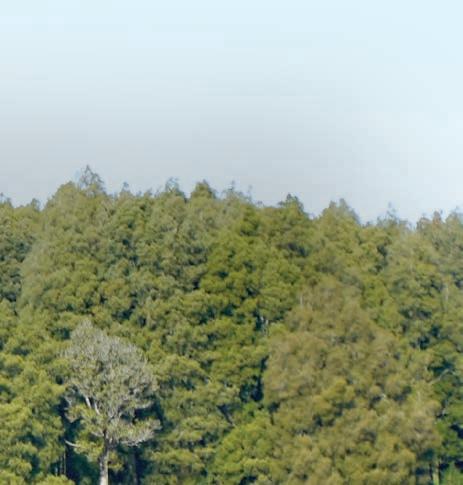
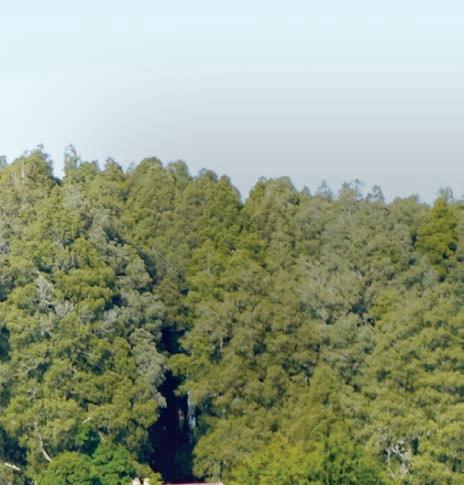
40 Ang&Ang/Hfd Strs
Full
Bob was in trouble. He forgot his wedding anniversary and his wife was really, really angry. She told him “Tomorrow morning, I expect to find a gift in the driveway that goes from 0 to 200 in 6 seconds AND IT BETTER BE THERE!”. She then slammed the bedroom door and poor Bob was made to sleep on the couch. The next morning he got up early and left for work. When his wife woke up, she looked out the window and sure enough there was a box gift-wrapped in the middle of the driveway. Confused, the wife put on her robe and ran out to the driveway and brought the box back into the house. She opened it and found a brand new bathroom scale. Bob has been missing since Friday.
Here at Farmers Weekly we get some pretty funny contributions to our Sale Talk joke from you avid readers, and we’re keen to hear more!
If you’ve got a joke you want to share with the farming community (it must be something you’d share with your grandmother...) then email us at: saletalk@agrihq.co.nz with Sale Talk in the subject line and we’ll print it and credit it to you.
Conditions apply
Key: Dairy Cattle Sheep Other

62ND NATIONAL FRIESIAN BULL SALE
Wednesday 20 September | 11.00am
Te Awamutu Saleyards
Comprising:
25 2yr Recorded Friesian Bulls
4 15/18 Month Recorded Friesian Bulls
30 1yr Recorded Friesian Bulls
BW’s to 396 - 23 over 300 BW
Dam’s production to 1065 MS
21 Bulls dam production in excess of 700 MS
Fantastic line-up of exceptionally well-bred. Friesian bulls that can be used with confidence in your mating program.
Most are G3 profiled so, their offspring can be fully recorded as replacement heifers.
Whether you are looking for bulls from high BW - NZ bred cow families that have supplied numerous sons to AI - or overseas genetics that have proven conformation and production traits needed in a higher input system, you won’t be disappointed when you look through this catalogue. Bulls are predominately owner bred/ reared & will come forward in excellent order.

These bulls give you different options at mating time & would be great running with a non-cycling herd & condensing the calving pattern.

Semen to be sold at the conclusion of the bulls including Westcoast Alcove, Valden Applause, Buckeye & Talent. Catalogues available on Agonline.

Enquiries: Andrew Reyland 027 223 7092
NZ’s
CELEBRATING 100TH NATIONAL JERSEY BULL SALE
Thursday 21 September | 11.30am
Te Awamutu Saleyards
Comprising:
19 2yr & 3yr Recorded Jersey Bulls
33 Yearling Recorded Jersey Bulls
BWs to 477 - 18 x bulls over 400 BW 200 Straws of semen
This year’s line-up of well-bred & presented Jersey bulls are backed by many generations of highquality female bloodlines.
Sired by the best type & production bulls currently available.
They have been selected by their owners from the top individual’s cows within their herd.
Take a look at the footnotes in the catalogue-a large number of these sale bulls have brothers already at AI centres. Heifer calves by this year’s offering can be kept as replacements with confidence. Farmers requiring well recorded high genetic merit bulls should attend this sale. Bulls have been BVD tested & vaccinated.
Semen to be sold at conclusion of the bulls including Lynbrook Terrific, Okura Manhatton, Lencrest Blackstone.
Catalogues available on Agonline.

Enquiries: Andrew Reyland 027 223 7092
NZ’s
ATHLONE STATION ON FARM CATTLE SALE
To be sold following above at Grant & Hayley Black
330 Wilfred Road, Albury
130 Ylg Angus & Angus/Hereford Steers
35 Ylg Angus Heifers
35 Ylg Angus/Hereford Heifers
TB Status: C10
The Heifers are Capital Stock Kakahu Bloodlines, well grown and suitable for breeding.
The above cattle come with proven reputation and genetics.
Enquires:

Jonty Hyslop (PGW) 027 595 6450
Grant Black (Vendor) 027 547 7616
A/c Kauhouroa Stn
30 Ang&Ang/Hfd Strs
A/c Mangatawhiti Stn
20 Ang & Ang/Hfd Strs
A/c Painga
20 Ang&Ang/Hfd Strs
1YR HEIFERS
A/c L & B Wallace
70 Hfd/Fres
1YR BULLS
A/c L & B Wallace
180 Fres & Hfd/Fres Bulls
Grand opportunity to purchase exceptional wellbred lines of Hill Country Station bred cattle.

Enquiries:
Ian Rissetto 027 444 9347
Mason Birrell 027 496 7253
PGG Wrightson Livestock - East Coast
Freephone 0800 10 22 76
Helping grow the country
Work
www.pggwrightson.co.nz/livestock fb.com/pgwlivestock instagram.com/pgwlivestock
Freephone 0800 10 22 76 | www.pggwrightson.co.nz Helping grow the country
Virtual Saleyard bidr.co.nz
Virtual Saleyard bidr.co.nz WE HELP YOU FIND TOP-NOTCH YEARLING BULLS
of our
genetics representatives.
the
code to visit our website
search PGG Wrightson Genetics. Helping grow the country
with one
trusted
Scan
QR
or
LK0116462© 35 FARMERS WEEKLY – farmersweekly.co.nz – September 11, 2023 Livestock 35
th September 2023, 12noon ON FARM - LUNCHEON PROVIDED 660 Ngaroma Rd, 26km off SH3, Sth East of Te Awamutu. Also available online on 32 TOP YEARLING BULLS & 70 2-YEAR OLD BULLS
EBV details in catalogue. Bulls ideal for Beef & Dairy. Sound bulls with exceptional temperament. Selection of Short Gestation & Low Birth Weights. Free local delivery or grazing till 1st Nov. Split Payment Oct 2023/Jan 2024. KELVIN & CYNTHIA PORT P: 07 872 2628 • M: 022 648 2417 E: kelvin@bushydowns.co.nz Web: www.bushydowns.co.nz ROBERT & MARIAN PORT • P: 07 872 2715
Resurgam Angus




Yearling & R2 Angus Bull Sale





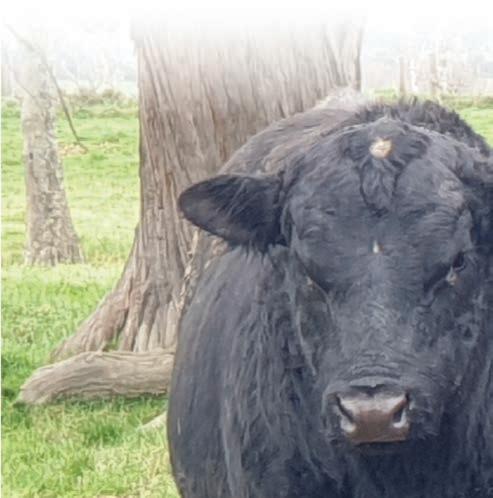
Sean & Jodi Brosnahan – 386 Wainui Road, Ohope

Friday 15th September 2023, 12pm






These R1 bulls plus a selection of R2 bulls are from NZ’s most remote farming area. They are truly station bred from hill country and are mainly NZ genetics. They are of impeccable temperament, soundness, type. 100% grass only – Closed herd. TB = C10.






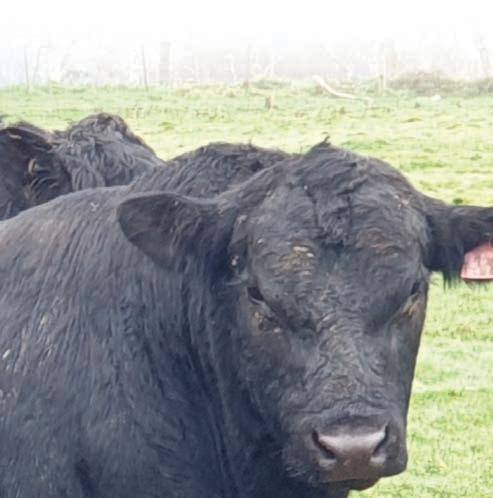


For





997 519 or 021 397 812








E: sean@resurgamangus.com resurgamangus www.resurgamangus.com Brent

ON FARM SALE GENUINE BULLS FROM GENUINE HILLS Gr eat constitution with added calving ease and performance 50 top 2 y ear olds ! 75 yearlings selected for heifer mating 25 low birth weight 2 year old herefords Monday 18th September 2023 at 11:30am 820 Waiterimu Rd, Ohinewai FRASER 027 285 9587 or 07 828 5755 MALCOLM 07 828 5709 www.hillcroftangus.co.nz est. 1960 HILLCROFT HI JustBetterBeef” “ Visitors always welcome. For all enquiries, contact: Sam LeCren M: 027 474 9989 E: sam@takapoto.co.nz Andy Transom, PGGW M: 027 596 5142 Our bulls are purpose bred for Calving Ease and short gestation 41 YEARLING BULLS FOR SALE Our bulls are proven for mating with heifers and MA cows BVD free and vaccinated TB free C10 Structurally guaranteed 8th Annual Yearling Bull Sale – FRIDAY, 22 ND SEPTEMBER 2023 1:00 PM AT 43 FINLAY ROAD, CAMBRIDGE – viewing of bulls from 11:00 AM Follow Takapoto Angus on Facebook www.takapoto.co.nz
Sean
Jodi Brosnahan Waitangihia
Further Inquiries:
&
Station 021
Bougen
Shaun Bicknell – 027
1977
– Auctioneer 027 210 4698
221
LK0116499© R1 & R2 Friesian Bulls Richard Seavill, Ph: 021 169 8276 R1 & R2 Jersey Bulls 30 x 300kg+ R2 Here/Frs Heifers Harrison Levien, Ph: 027 496 7410 400kg+ 2yr Steers, any breed considered Sam Cowley, Ph: 021 263 2019 STOCK WANTED STOCK FOR SALE Service Bulls tested & ready to go. Frs, Here, SP, Char 80 x 250kg Angus/Friesian Heifers Richard Seavill, Ph: 021 169 8276 30 x 330kg Char/Frs Heifers Sam Cowley, Ph: 021 263 2019 Ph: 0800 827 455 Email: admin@byl.co.nz Website: www.byllivestock.co.nz "MAXIMISING YOUR RETURN THROUGH PERSONAL LIVESTOCK MANAGEMENT" A Financing Solution For Your Farm www.rdlfinance.co.nz 36 FARMERS WEEKLY – farmersweekly.co.nz – September 11, 2023 Livestock 36















Call Peter Heddell on 027 436 1388 32 Rugged 2-year-old Bulls Monday October 2nd – 1.30pm Open Day to view bulls: Tuesday September 19th from 1.00pm to 3.00pm Sandown 445 Deans Road, SH 72, Darfield Video of bulls on Glen R Angus Spring Bull Sale LK0116552© On-farm Auction & online M AUNGAHINA STUD ESTB. 1907 YEARLING BULL SALE 2023 F riday 22 September at 1pm 45 Maungahina Road, off Castlepoint Road, Masterton – streamed live for online bidders and views 25 H ereford Yearlings | 25 Speckle Park Yearlings LK0116471© Add value to your calves LK0116184© RIVERTON HEREFORDS 32ND ANNUAL SALE FORDELL, WANGANUI THURSDAY 21 SEPT – 12 NOON 36 TWO-YEAR BULLS 100 YEARLING BULLS Hybrid auction on MIKE CRANSTONE 0800 EZICALVE PGGW - KEITH WILSHER 027 596 5143 NZFL - MALCOLM COOMBE 027 432 6104 www.ezicalve.co.nz THE CHOICE IS 35 TWO-YEAR-OLD BULLS 85 YEARLING BULLS Tuesday 26 Sept, 12 noon On-farm auction, Marton or buy online with WILLIAM MORRISON 027 640 1166 ardofarm@xtra.co.nz www.ezicalve.co.nz NZ’s Best Dairy-Beef Bulls MATING HEIFERS OR DAIRY COWS? LK0116171© 37 FARMERS WEEKLY – farmersweekly.co.nz – September 11, 2023 Livestock 37 Mark Stokman: 027 640 4028 Jake: 0277874008 email: mtkiwi@farmside.co.nz The Stokman Bull... l Fertility and semen tested l Carcass Scanned l HD50K DNA for higher EBV accuracy l Well grown-use on heifers or cows l Good temperament 2023 Stokman Angus Yearling Bull & Heifer Sale Stokman Angus Wednesday 20th September 100 Bulls + 40 Heifers Sell! 1pm Start Waikite Valley, Rotorua www.stokmanangus.com Stokman Angus Farm Average EBV’s on NZ Breed our Sale Bulls Average Calv Ease +5.4 +2 Gestation Lgth -5.8 -4.1 Birth Weight +2.8 +4.4 600 Day +116 +98 Angus Pro +162 +106 IMF +2.12 +0.7
Good year for rearers of autumnborn calves
There are no signs of any shortage of calf numbers coming through the yards – in fact, some yards have had a busier year in this department.
 Fiona Quarrie MARKETS Livestock
Fiona Quarrie MARKETS Livestock

AUTUMN-born cattle usually come with a premium attached to them and this is certainly still the case this year. Feeder calf returns in autumn were strong in comparison to calf sales held through winter and into spring – and the determination of calf rearers at those autumn sales seems to be paying off for those north of the Central Plateau. Autumn-born weaner attendance at store cattle sales around the country tends to concentrate in August, so now that we have stepped into September it is a good opportunity to take a look at how the numbers stack up.
In terms of national throughput, 2023 figures don’t indicate there is any shortage of numbers coming through the yards. In fact, some yards have had a busier year in
Farmers-Weekly-Built-by-us.pdf
this department. Frankton is the largest yard covered by AgriHQ in terms of autumn-born weaner throughput and where August would usually see somewhere from 810 to 910 head pass through the yards, there have been 963 head put in front of buyers this year. There are no complaints of over-supply, however, and these have happily been snapped up. The cost of rearing calves has been prominent in the media for the past couple of years, and it is the size of the cheque at weaning that determines whether it was worthwhile.
For all makes and models, average per head returns for autumn-born weaners usually sit around $487-$519, so it is pleasing to see the average this year at $560.
New Zealand Farmers Livestock agent Stuart Wells was happy to hear this and attributed it to several factors.

1 21/08/2023 12:51:26 pm
“A lot of people got rid of cattle on the earlier schedules and

though it got wet for a while, a drier August did help. People do just need cattle,” he said. The other significant contributor was an improvement in quality. There are more exotic-cross types, which attract a premium. They include Belgian Blue, Charolais and Simmental.
The average per kilogram return for autumn-born Friesian bulls sold at Frankton in August was $5.02/kg while the same figure for Belgian Blue-Friesian settled at $5.36/kg.
The classic Hereford-Friesian is hard to beat, though, providing the markings are true to type.
Autumn-born Hereford-Friesian bulls sold at the yards in August weighed 108-132kg and collected $620-$685, an average of $5.65/kg for the month.
If all regular vendors channelled their weaners through the yards, tallies would be sitting even
higher, but plenty of demand has made paddock sales more common. One client of Wells sold only 20 heifers through Frankton this year and found homes for his 350 bulls in the paddock.
Unfortunately, the rest of the country isn’t following this trend and, in most cases, returns are sitting in line with those made last year.
There haven’t been significant numbers sold through Feilding yet, but these will likely come in the next few weeks.
PGG Wrightson agent Peter Forrest hasn’t been blown away by returns on paddock sales so far but, when considering the bull beef schedule compared to last year, he believes they are holding up okay.
“Friesian bulls sold in the paddock have typically traded at $600-$635 and well-marked and grown Hereford-Friesian
have made $600-$650. HerefordFriesian heifers have traded from $500 to $600 depending on quality and size,” he said.
One underlying factor possibly putting a cap on prices is the long period of wet weather and subsequent delay in feed growth. The grass is just starting to move in a positive direction, which should bring more buyers to the market.
Other discussions around weaners have often been directed at the expected lack of winter and spring-born weaners hitting the market once off the feeders. Some might wonder if the potential lack of supply is nudging some buyers to the market early.
Whether or not this is the case, everyone has their fingers crossed for a productive spring so that those who have made the commitment to feeding calves can reap some sort of reward.

38 Markets
Markets
sponsored by
Proudly
SOLID DEMAND: This pen of autumn-born weaner Simmental-Friesian bulls sold at the New Zealand Farmers Livestock Frankton sale on August 2. At 115kg, they made $675 or $5.87/kg.
Weekly saleyards
A late rush of old season lambs at Feilding and Stortford Lodge was timed well as warmer days and longer sunshine hours have allowed lambs to finish, and larger finishers re-entered the market. Buyers mainly from Manawatū and Hawke’s Bay were looking for bigger volumes of lambs too, and their needs were catered for at Stortford Lodge where nearly 8000 were offered. Mixed-sex lines from the Chatham Islands sold for $125-$144.50 and top ewe and male pens for $125-$160. The second Feilding Marton Hogget Fair supplied big lambs, and very heavy male and ewe lambs mostly made $145-$184.
39
Kaikohe | September 6 | 300 cattle $/kg or $/hd 2-year Shorthorn steers, one line 3.22 2-year dairy-beef steers 3.00-3.10 2-year Angus-cross heifers 3.00-3.14 Yearling Friesian bulls 3.42 Prime beef cows 2.00-2.20 Wellsford | September 4 | 452 cattle $/kg or $/hd 2-year dairy-beef steers, 373-435kg 2.99-3.00 2-year traditional heifers, 313-332kg 2.85-2.92 Yearling dairy-beef steers, 257-296kg 3.14-3.15 Yearling dairy-beef bulls, 208-283kg 3.22-3.41 Yearling dairy-beef heifers, 306-313kg 2.88-2.94 Pukekohe | September 2 $/kg or $/hd Yearling steers 3.02-3.85 Yearling heifers 2.88-3.25 Aut-born weaner steers & heifers 430-615 Prime steers 3.08-3.17 Prime heifers 3.06-3.08 Store lambs, all 118-146 Prime lambs, all 125-166 Tuakau | August 31 | 480 cattle $/kg or $/hd Aut-born 2-year Angus-cross steers, 530-560kg 3.10-3.13 2-year Hereford-Friesian steers, 445-500kg 3.13-3.23 2-year dairy-beef heifers, 400-460kg 2.88-3.02 Yearling Hereford-Friesian steers, 230-300kg 920-1100 Yearling Speckle Park-dairy heifers, 280-328kg 880-995 Yearling Hereford-Friesian heifers, 245-285kg 720-850 Rangiuru | September 5 | 333 cattle, 41 sheep $/kg or $/hd Yearling Angus-Friesian steers, 288-301kg 3.71-3.86 Yearling Simmental-cross heifers, 292-296kg 3.28-3.36 Prime beef-cross steers, 613-653kg 3.16-3.31 Prime heifers, 484-523kg 2.92-3.08 Boner dairy cows, 430-512kg 1.87-2.09 Prime lambs, all 94-109 Frankton | September 5 | 448 cattle $/kg or $/hd Prime beef, dairy-beef steers, 477-720kg 3.06-3.22 Prime Charolais-cross cows, 630-693kg 2.30-2.31 Boner Friesian-cross cows, 483-512kg 1.85-1.94 2-year dairy-beef steers, medium to good 1400-1475 Yearling Charolais-Friesian heifers, good 860-980 Aut-born weaner Hereford-Friesian bulls, medium to good 535-680 Aut-born weaner dairy-beef heifers, medium to good 370-620 Frankton | September 6 | 363 cattle $/kg or $/hd 2-year Hereford-Friesian steers, 438-456kg 3.30-3.39 Aut-born yearling Angus-cross heifers, 331-345kg 2.98-3.00 Yearling Hereford-Friesian steers, 200-219kg 3.70-3.80 Prime Hereford-Friesian heifers, 478-529kg 3.11-3.16 Boner Friesian cows, 658-760kg 1.96-1.97 Boner Friesian-cross cows, 494-560kg 1.80-1.88 Matawhero | September 1 | 593 sheep $/kg or $/hd Store male lambs, good to heavy 137 Store ewe lambs, good 102-112.50 Prime mixed-sex lambs, medium 123-137 Prime ewes, all 65-91 Matawhero | September 5 | 718 cattle $/kg or $/hd 2-year traditional steers, 363-371kg 1300-1410 2-year Simmental-cross steers, one line, 337kg 3.56 2-year traditional, exotic bulls, 405-505kg 2.87-3.07 2-year Angus & Angus-Hereford heifers, one line, 373kg 3.14 Yearling Angus steers, 195-309kg 850-1090 Yearling Angus & Angus-Hereford steers, 249-265kg 4.00-4.08 Yearling exotic bulls, 160-261kg 480-680 Yearling traditional heifers, 218-231kg 610-650 Yearling exotic heifers, 176-235kg 500-660 Taranaki | September 6 | 741 cattle $/kg or $/hd 2-year Hereford-Friesian steers, one line, 454kg 3.90 2-year Hereford-Friesian steers, 475kg 3.43 average 2-year Hereford-Friesian heifers, 383-428kg 3.39-3.45 2-year Angus-Friesian heifers, 381-453kg 3.20-3.24 Yearling Hereford-Friesian steers, 200-242kg 4.00-4.09 Yearling Hereford-Friesian heifers, 232-262kg 3.46-3.58 Stortford Lodge | September 4 | 46 cattle, 898 sheep $/kg or $/hd Prime Angus & Angus-Hereford cows, 592-633kg 2.28-2.31 Boner Friesian cows, 514-563kg 1.95-2.04 Prime ewes, heavy 125-139 Prime ewes, good to very good 115-120 Prime male lambs, heavy 181 Prime ram lambs, heavy 141-175 Prime mixed-sex lambs, heavy 158-175 Stortford Lodge
$/kg
$/hd 2-year dairy-beef heifers, 380kg 2.90 average Yearling Angus & Angus-Hereford steers, one line, 258kg 4.11 Yearling traditional heifers, 209-257kg 3.24-3.39 Yearling Charolais-beef heifers, one line, 273kg 3.60 Mixed-age ewes & lambs, BF/WF lambs, tails, good 60-66 Store cryptorchid lambs, good to heavy 125-155 Store wether lambs, good to heavy 143-160 Store ewe lambs, good to heavy 129-145 Store ewe lambs, light to medium 81-123 Store mixed-sex lambs, good to heavy 125-144.50 FARMERS WEEKLY – farmersweekly.co.nz – September 11, 2023 Markets 39
| September 6 | 196 cattle, 7759 sheep
or
With payments spread over 2 years, no servicing costs for 12 months plus a class-leading 3-year warranty, we’re helping you into a new KingQuad with as little initial outlay as possible.
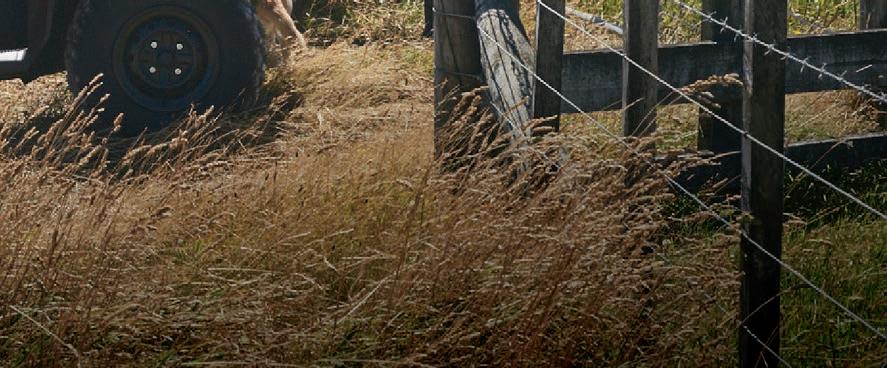


T&Cs: The 12 month free service offer is available to the first 50 new LT-A500X/XP and LT-A750XP KingQuad models purchased from 1/9/23 – 31/10/23 and limited to three services within 12months (whichever occurs first) of purchase in accordance with the maintenance guidelines set by Suzuki NZ. Any repairs, unscheduled maintenance, and collection/delivery, or cleaning are not included. Finance offer is based on a 7.99% p.a. interest rate fixed over a 24 month loan term and on the following payments; an up-front deposit of one-third (1/3) of the RRP, the cost of any accessories fitted, and the fees set out below; a further payment of one-third (1/3) of the RRP to be paid on the 12 month loan anniversary; and; a final payment of one-third (1/3) of the RRP to be paid on the 24 month loan anniversary. The 7.99% p.a. interest is fixed for the term of the loan. A PPSR fee of $10.35, a monthly maintenance fee of $2, a UDC loan fee of $130 and a $300 dealer origination fee will apply. The loan is provided by UDC Finance Limited. UDC Finance Limited’s lending criteria, standard terms and conditions apply. This offer cannot be used in conjunction with any other discounts or offers, while stock lasts. TRACTA66025_KINGQUAD_SERVICING_FW
MONEY’S TIGHT. HANG ON TO IT. From only $5,309+GST upfront +12 months free servicing.* 40 FARMERS WEEKLY – farmersweekly.co.nz – September 11, 2023 Markets 40 Dannevirke | August 31 | 822 sheep $/kg or $/hd Store cryptorchid lambs 60-129 Store ewe lambs 92-121.50 Store mixed-sex lambs 90-129 Prime ewes, all 64-76 Prime lambs, all 126-161 Feilding | September 1 | 963 cattle, 3555 sheep $/kg or $/hd 2-year Angus steers, 430-583kg 3.32-3.41 2-year dairy-beef heifers, 403-455kg 3.03-3.14 Yearling traditional steers, 302-399kg 3.51-3.79 Yearling Friesian bulls, 254-326kg 3.50-3.56 Yearling dairy-beef heifers, 305-406kg 3.11-3.27 Mixed-age Romney ewes & lambs, BF/WF lambs, docked, good 82.50-86.50 Mixed-age Romney ewes & lambs, BF/WF lambs, tails, medium 64-71 Store male lambs, heavy 140-157 Store whiteface ewe lambs, woolly, good 120-130 Store ewe lambs, woolly, medium 102-119 Feilding | September 4 | 39 cattle, 2473 sheep $/kg or $/hd Boner Friesian cows, 507-687kg 1.77-1.81 Boner Friesian, Friesian-cross cows, 400-480kg 1.68-1.73 Prime ewes, good 106-126 Prime male lambs, very heavy 178-181 Prime ewe lambs, heavy 138-176 Prime mixed-sex lambs, very heavy 180-189.50 Prime mixed-sex lambs, heavy 136-177 Feilding Marton | September 6 | 5562 sheep $/kg or $/hd Store male lambs, very heavy 153-184 Store male lambs, heavy 126-138 Store ewe lambs, very heavy 145-170 Store ewe lambs, heavy 120-152 Rongotea | September 5 | 166 cattle $/kg or $/hd 2-year Hereford-Friesian steers, 405-683kg 2.85-3.01 Aut-born yearling Hereford-Friesian heifers, 107-203kg 490-710 Yearling Hereford-Friesian heifers, 169-268kg 560-825 Coalgate | August 31 | 323 cattle, 1978 sheep $/kg or $/hd 2-year Angus steers, 291-359kg 3.31-3.40 2-year beef heifers, 275-388kg 2.95-3.11 Yearling dairy-beef heifers, 254-289kg 3.15-3.37 Prime steers, 483-630kg 3.06-3.18 Prime dairy-beef heifers, 465-630kg 2.94-3.00 Mixed-age Romney-Texel ewes & lambs, BF lambs, tails, good 85-86 Store mixed-sex lambs, medium to good 100-127 Prime lambs, heavy 163-182 Canterbury Park | September 5 | 667 cattle, 2602 sheep $/kg or $/hd 2-year dairy-beef steers, 421-479kg 2.88-3.07 2-year traditional heifers, 316-388kg 2.68-2.77 Yearling Hereford-Friesian steers, 240-278kg 3.31-3.38 Yearling Speckle Park-dairy heifers, 241-259kg 3.53-3.70 Prime traditional steers, 468-593kg 2.85-3.00 Prime dairy-beef heifers, 425-567kg 2.80-2.93 Store mixed-sex lambs, heavy 121-140 Store mixed-sex lambs, good 107-129 Prime ewes, very good 86-119 Prime lambs, good to very good 136-169 Temuka | September 4 | 483 cattle, 1712 sheep $/kg or $/hd Prime traditional steers, 515-614kg 2.85-2.98 Prime dairy-beef steers, 550-680kg 2.86-3.01 Prime dairy-beef heifers, 480-555kg 2.84-2.89 Boner Friesian, Friesian-cross cows, tops, 512-655kg 2.05-2.12 Boner Friesian, Friesian-cross cows, 459-557kg 1.89-1.96 Boner crossbred cows, 360-419kg 1.30-1.41 Boner Jersey cows, 329-398kg 0.70-0.80
41 FARMERS WEEKLY – farmersweekly.co.nz – September 11, 2023 Markets 41 Store Halfbred mixed-sex lambs, good 109-121 Store Corriedale mixed-sex lambs, shorn, good to heavy 119-151 Prime ewes, most 70-115 Prime lambs, most 125-178 Balclutha | September 6 | 142 sheep $/kg or $/hd Store lambs, all 110-115 Prime ewes, all 84-94 Prime lambs, all 139-161 Charlton | August 31 | 156 sheep $/kg or $/hd Store lambs, all 57-102 Prime ewes, all 55-100 Prime lambs, all 95-167 Lorneville | September 5 $/kg or $/hd 2-year beef-cross steers, 390kg 1200 2-year Friesian steers, 495kg 1415 Yearling beef-cross steers & heifers, 190-260kg 640-780 Prime heifers, 400-410kg 2.28-2.76 Boner cows, 460-560kg 1.84-1.86 Store lambs, all 80-125 Prime ewes, all 60-110 Prime lambs, all 130-158 Feeder Calves | August 31 - September 6 Tuakau | September 4 | 179 cattle $/kg or $/hd Friesian bulls, medium to good 95-150 Hereford-Friesian (black) bulls, small to good 140-250 Other dairy-beef bulls, small to good 35-170 Hereford-Friesian (black) heifers, small to good 50-180 Other dairy-beef heifers, small to good 30-70 Paeroa | September 4 | 121 cattle $/kg or $/hd Friesian bulls, small to medium 15-55 Hereford-Friesian (black) bulls, small to good 100-220 Other dairy-beef bulls, medium to good 80-180 Dairy-beef heifers, small to good 50-115
| September 5 | 943 cattle $/kg or $/hd Friesian bulls, small to good 20-180 Hereford-Friesian (black) bulls, small to good 80-240 Other dairy-beef bulls, small to good 20-200 Hereford-Friesian (black) heifers, small to good 20-140 Other dairy-beef heifers, small to good 10-100 Cambridge | September 5 | 468 cattle $/kg or $/hd Friesian bulls, small to medium 40-80 Hereford-Friesian bulls, small to medium 25-180 Exotic-Friesian bulls, small to medium 10-150 Dairy-beef heifers, small to medium 10-40 Tirau | September 6 | 418 cattle $/kg or $/hd Friesian bulls, small to good 30-165 Hereford-Friesian (black) bulls, small to good 80-270 Other dairy-beef bulls, small to good 100-160 Dairy-beef heifers, small to good 40-140 Te Awamutu | August 31 | 248 cattle $/kg or $/hd Friesian bulls, small to good 50-170 Hereford-Friesian (black) bulls, small to good 120-270 Hereford-Friesian (red) bulls, small to good 115-225 Charolais-Friesian bulls, small to good 100-280 Angus-Friesian bulls, small to good 80-180 Hereford-Friesian (black) heifers, small to good 50-130 Charolais-Friesian heifers, small to good 70-140 Angus-Friesian heifers, small to good 30-100 Manfeild Park | September 4 | 315 cattle $/kg or $/hd Friesian bulls, small to good 40-150 Hereford-Friesian (black) bulls, medium to good 200-280 Other dairy-beef bulls, medium to good 150-260 Dairy-beef heifers, small to good 40-150 See what sold today REPORTS EYE LIVESTOCK Results from the saleyards, including per kilo prices for store lambs, delivered straight to your inbox. Subscribe from only $35* per month agrihq.co.nz/livestock-reports * Prices are GST exclusive
Frankton
AgriHQ market trends
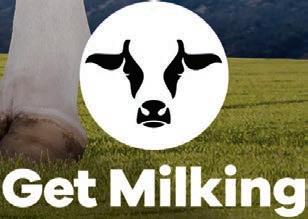


Cattle Sheep

Deer
Fertiliser
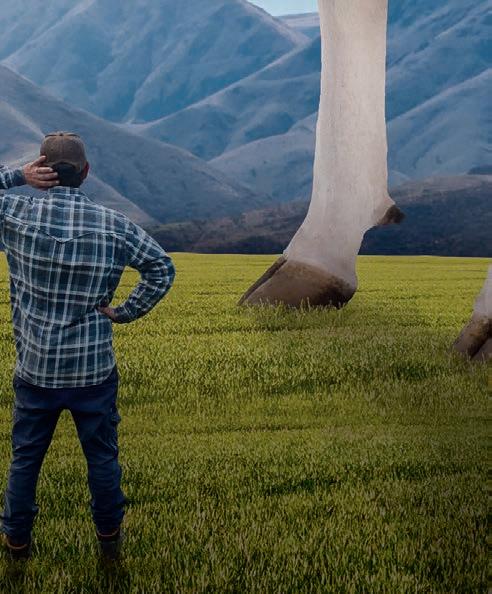


Forestry

42 FARMERS WEEKLY – farmersweekly.co.nz – September 11, 2023 Markets 42
Sheep Meat Slaughter price (NZ$/kgCW) Last week Last year North Island lamb (18kg) 6.95 9.45 North Island mutton (25kg) 3.30 6.10 South Island lamb (18kg) 6.90 9.40 South Island mutton (25kg) 3.15 6.10 Export markets (NZ$/kg) China lamb aps 10.15 14.33 Wool (NZ$/kg clean) 31-Aug Last year Crossbred eece 3.05 2.75 Crossbred second shear 2.67 2.38 Courtesy of www.fusca.co.nz Beef Slaughter price (NZ$/kgCW) Last week Last year North Island P2 steer (300kg) 6.00 6.70 North Island M2 bull (300kg) 5.90 6.30 North Island M cow (190kg) 3.85 4.90 South Island P2 steer (300kg) 5.65 6.40 South Island M2 bull (300kg) 5.30 6.20 South Island M cow (190kg) 4.00 4.90 Export markets (NZ$/kg) US imported 95CL bull 9.17 9.55 US domestic 90CL cow 11.63 9.72 Venison Slaughter price (NZ$/kgCW) Last week Last year North Island AP stag (60kg) 8.80 8.45 South Island AP stag (60kg) 8.75 8.45 Fertiliser NZ average (NZ$/tonne) Last week Last year DAP 1197 1794 Super 449 505 Urea 807 1340 Urea (Coated) 856 1389 Exports NZ Log Exports (tonnes) Jul Last year China 1,375,853 1,211,739 Rest of world 196,628 177,204 Carbon price (NZ$/tonne) Last week Last year NZU 70.3 85.7
Steer slaughter price ($/kgCW) Lamb slaughter price ($/kgCW) Australia lamb exports (Jun - Aug, thous. tonnes) Stag Slaughter price ($/kgCW) Australia beef exports (Jun - Aug, thous. tonnes) Data provided by
Slaughter values are weighted average gross operating prices including premiums but excluding breed premiums for cattle. 5.0 5.5 6.0 6.5 7.0 Sep Nov Jan Mar May Jul North Island South Island 6.0 7.0 8.0 9.0 10.0 Sep Nov Jan Mar May Jul North Island South Island 0 10 20 30 40 50 60 70 80 China Japan S. Korea Rest of Asia US Other Last year This year 0 5 10 15 20 25 Asia (xcl. China) China Mid. East US Other Last year This year 7.5 8.0 8.5 9.0 9.5 Sep Nov Jan Mar May Jul North Island South Island so they can udderly take on anything Learn online with a Dairy Assistant course getmilking.co.nz Grow your team’s skills
NOTE:
10.0
9.0
8.0
7.0
6.0
11.0 Aug Oct Dec Feb Apr Jun Aug Sep-2024 Sep-2025
Close of market
650
600
550
Grain Dairy S&P/NZX 10 INDEX 11625 S&P/FW PRIMARY SECTOR EQUITY 10356 S&P/NZX 50 INDEX 11428 400

provided by 450
500
650
600
550
500

700 Aug Oct Dec Feb Apr Jun Aug 400
450
400
350
450 Aug Oct Dec Feb Apr Jun Aug
700 Aug Oct Dec Feb Apr Jun Aug 2200 2300 2400 2500 2600 2700 2800 2900 3000 3100 Sep Oct Nov Dec Jan Feb Latest price 4 weeks ago 300
“we can’t take three more years of this government!” Join us for half an hour or half a day, or as long as you can! Tractors, Utes, Cars welcome - bring the dogs to make some noise Coming to a town near you, check full i�nerary on our we��ite www.groundswellnz.co.nz BRYCE & LAURIE’S COUNTRYWIDE TRACTOR TREK 22 SEPTEMBER - 1 OCTOBER 43 FARMERS WEEKLY – farmersweekly.co.nz – September 11, 2023 Markets 43
Company Close YTD High YTD Low ArborGen Holdings Limited 0.18 0.23 0.177 The a2 Milk Company Limited 4.75 7.83 4.64 Cannasouth Limited 0.23 0.32 0.17 Comvita Limited 3.24 3.48 2.75 Delegat Group Limited 8.33 10.2 8.2 Fonterra Shareholders' Fund (NS) 3.17 3.88 2.95 Foley Wines Limited 1.22 1.42 1.18 Greenfern Industries Limited 0.048 0.113 0.044 Livestock Improvement Corporation Ltd (NS) 1 1.25 1 Marlborough Wine Estates Group Limited 0.17 0.19 0.15 NZ King Salmon Investments Limited 0.194 0.24 0.19 PGG Wrightson Limited 4.05 4.67 3.88 Rua Bioscience Limited 0.108 0.22 0.099 Sanford Limited (NS) 3.99 4.39 3.89 Scales Corporation Limited 3.02 4.25 2.75 Seeka Limited 2.45 3.72 2.25 Synlait Milk Limited (NS) 1.29 3.65 1.27 T&G Global Limited 1.96 2.37 1.94 S&P/NZX Primary Sector Equity Index 10356 12870 10317 S&P/NZX 50 Index 11428 12212 11428 S&P/NZX 10 Index 11625 12411 11486
NZX market trends
Dairy Futures (US$/t) Nearest contract Last price* Prior week 4 weeks prior WMP 2500 2485 2735 SMP 2350 2350 2565 AMF 4570 4570 4830 Butter 4500 4500 4635 Milk Price 6.96 6.81 7.25 * price as at close of business on Wednesday Data
Listed Agri shares Canterbury feed wheat ($/tonne) 5pm, Wednesday Milk price futures ($/kgMS) Canterbury feed barley ($/tonne) Waikato palm kernel ($/tonne) WMP futures - vs four weeks ago (US$/tonne)
Outlook dry on the rocks with a twist
Philip Duncan NEWS Weather
BEING a forgotten region
isn’t always a bad thing.
Most weeks I get a few complaints from various places asking why we don’t mention them more often in our forecasts. My reply is usually the same: “Not much is happening where you are, which is a good thing” – especially if the regions we’re usually talking about are in flood or drought or have some serious weather-related problem.
Without any doubt the focus of 2023 has been on the upper and eastern North Island, with so much flooding, and slips and weather-related damage earlier this year. Neighbouring regions don’t get mentioned so much, but I see you Taranaki, Manawatū, Horowhenua, Nelson, Marlborough, Otago and others!
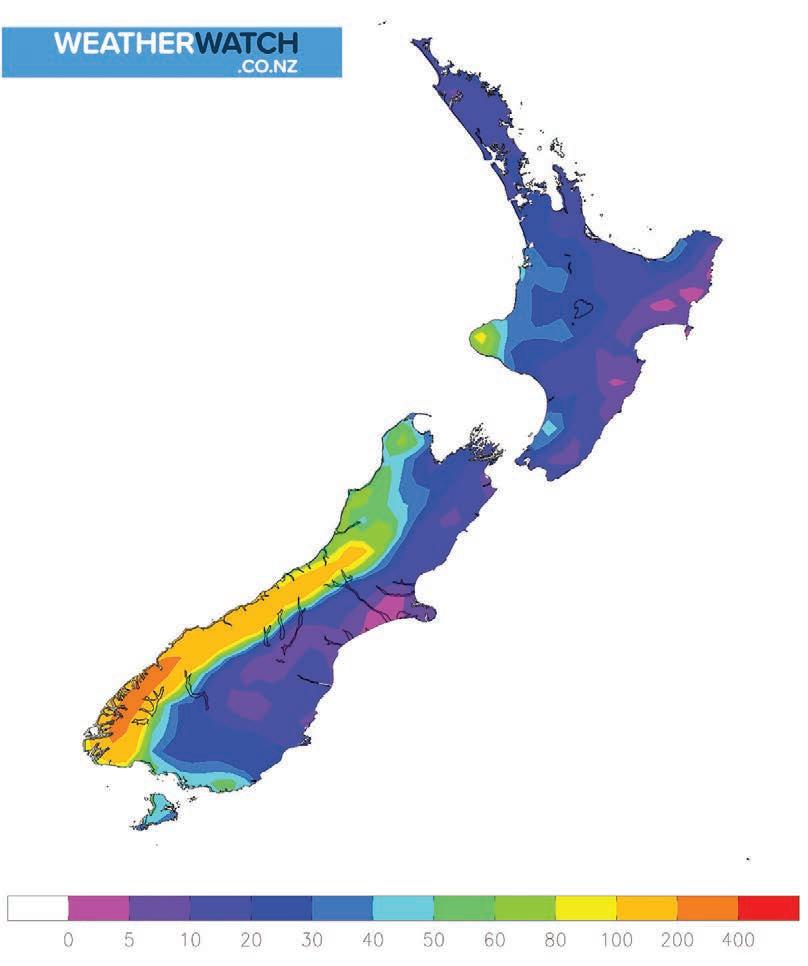
Over the months ahead the focus is likely to shift to those in the east of both islands as a dryingout phase continues, fuelled by both spring’s westerlies and the partial El Niño, which is still developing (and likely to be more
dominant in our summer and autumn months).
These eastern regions are now starting to show signs of being drier than usual – a rapid slide since the start of August when most were too wet and muddy.
Warm days, frosty nights and some windy weather have all combined to help dry the surface of the soil in the east. It’s not this case in the west, where the ground is still very wet, muddy in places, and generally about where it should be fresh after winter has finished.
While El Niño brings drier weather to eastern and northern parts of both main islands, an El Niño spring can bring extra showers and pulses of cooler air to all western regions of NZ.
In a nutshell, this update is to prepare those in the east and north for a gradually drier and drier weather pattern to emerge –yes, there’s still some wet weather in the mix, but fewer wet days each week – and lower rainfall totals.
There is a positive twist in the forecast: this period of time – as we get warmer days and more sunlight (an extra 20 minutes more sunlight each and every
Water is precious. Sometimes contentious. It is critical to humans, animals and plants – but its responsible and cost-e ective use in New Zealand and globally has become an issue.
Now sustainable agricultural product provider UPL NZ Ltd is wading in, aiming to put some control back in farmers’ hands.
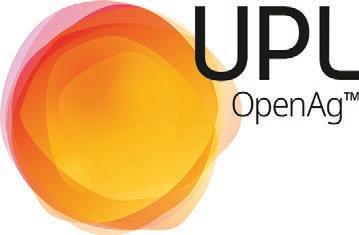
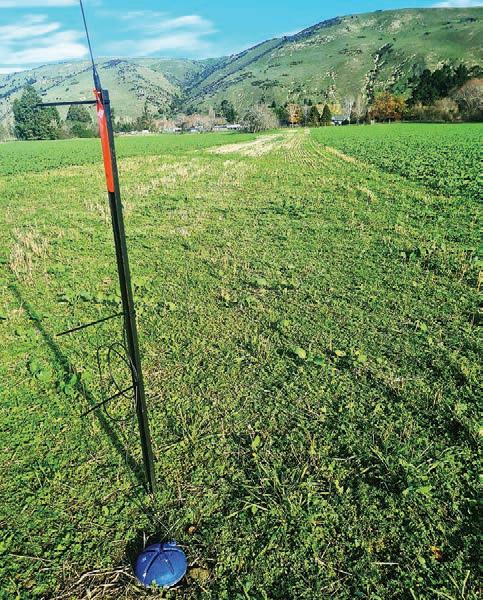
The solution is chemistry, UPL NZ Otago
Southland Regional Manager Tom McDonald concedes, but not as you know it. “It’s the ‘soft’ stu . It’s very, very clever science.”

Corn starch-based, super absorbent Zeba® stores water and releases it when plants need it. Each Zeba granule can hold up to 400 times its own weight in water. With a high cation exchange capacity, it is able to positively interact with soil nutrients, keeping both water and nutrients where the plant roots need them most.
Zeba also supports soil microbial communities promoting a more sustainable environment.
Tom says the patented, granular product can decrease the amount of water needed for irrigation, reducing costs. And for dryland systems, where rainfall is a limiting factor, it builds in a bit more certainty.
Applied down the spout at sowing, Zeba helps get seedlings o to a great start.
“Crop establishment is Zeba’s strength and that is a critical time, especially in high-value crops
week in September!) – is great for pasture growth.
Regions in the west, which are still fairly wet on foot, will be the first to notice the surge in the growth of pasture, which has been fairly dormant for the past two months due to a colder end to winter. Extra feed is fairly low around New Zealand so a spring bounce would be hugely appreciated by many. But for those in the east, who have already had a tough 2023 due to too much rain, you should now be prepared for the pendulum to swing the other way. It looks to be a gradual fade to drier and drier weather, giving you some time to prepare for the upcoming summer and autumn.
Highlights this week
• A storm well south of New Zealand brings westerlies to NZ
• High pressure in the Tasman Sea all week and weekend (El Niño-like) – keeping NZ on the windier fringes (westerlies)
• Cold front late week for NZ
including forage brassicas, cereals, lucerne and beet.
“You’ve only got one chance to get it right, or it’s going to cost you.
“We’ve also had impressive results in the establishment of kale, following a crop of cereal. You can see a real di erence between the Zebatreated area versus the untreated.
“I suggest people think of Zeba the same way they’d choose treated seed over untreated. It’s like an insurance policy.”
Tom says Zeba is relatively new to New Zealand but has performed well in arid areas of countries such as Australia, South Africa and India. And, he says, data from New Zealand is already compelling.
Zeba activates when rain falls, or irrigation is applied. It will recharge when there is additional moisture before eventually breaking down in 5-6 months.
“With an El Niño weather pattern forecast, it’s a product whose time has come.”
Tom says larger scale irrigated arable and dryland farmers are not the only ones to bene t from Zeba. “For growers, Zeba means more yield for less water application. That can be a big saving!”
He says the product also has potential for growers of other specialist crops such as high-
WEEK AHEAD: Rainfall accumulation over seven days starting from 6am on Sunday September 10 through to 6am Sunday September 17.
value small salad greens and other vegetables that don’t have a lot of time to establish strong root systems before harvest.
“Zeba is an ideal tool in areas where you want to retain as much moisture in the soil as possible, so crop growth can be maximised, and growth checks minimised.”

If the forecasters have got it right, our summer
will be dry. Tom says that could mean Zeba has arrived just in time. Talk to your local Technical Field Representative or UPL for more information on Zeba.
Exempt from registration under the ACVM Act 1997. Non-hazardous.
® Registered trademark

water
The soil moisture management product that’s changing farming NORTH ISLAND Pieter van der Westhuizen Regional Sales Manager Upper North Island pieter.vanderwesthuizen@upl-ltd.com +64 21 392 740 SOUTH ISLAND Tom McDonald Regional Sales Manager Lower South Island tom.mcdonald@upl-ltd.com +64 21 519 772
“Clever” science helping optimise
use
ADVERTISEMENT LK0116364©
Kale paddock, untreated, sown in early March, Otago.
44 Weather ruralweather.co.nz
Kale paddock treated with Zeba, sown early March, Otago.















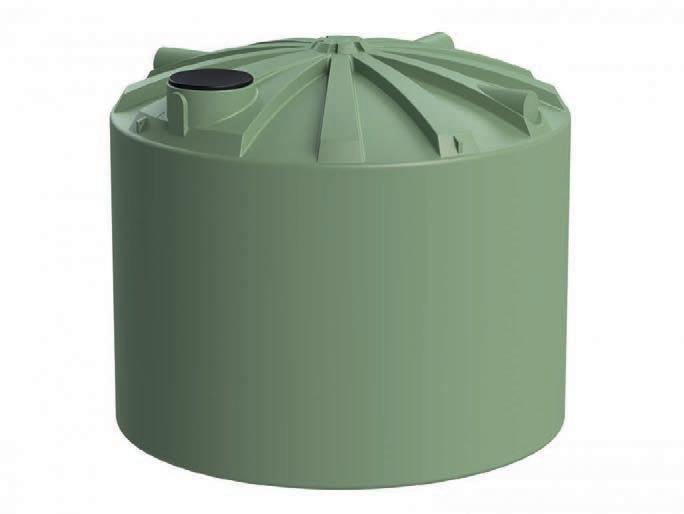




















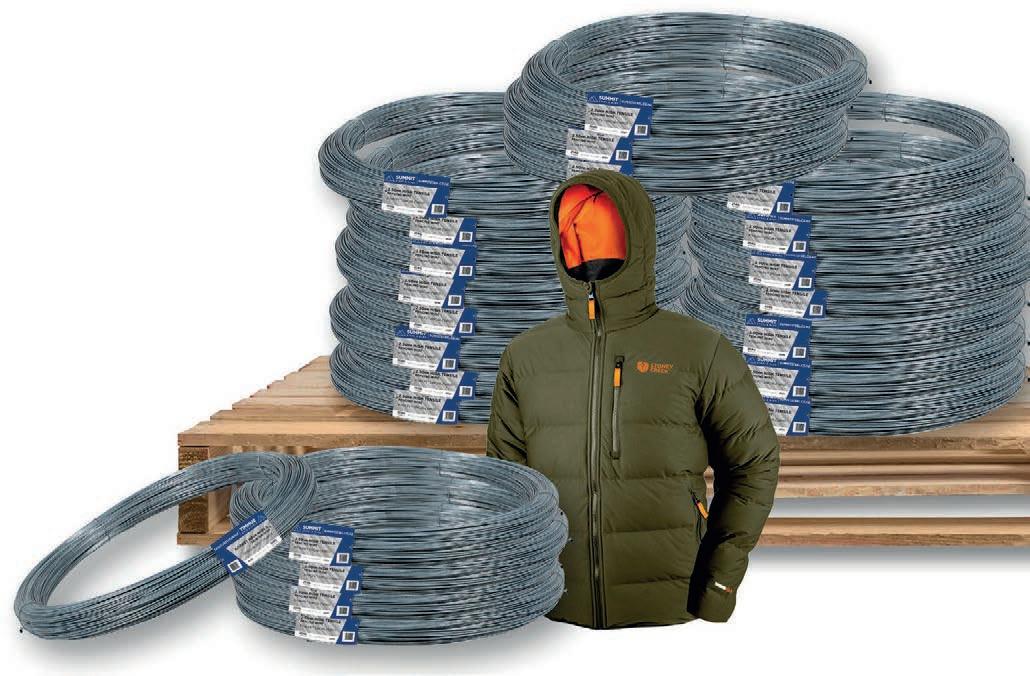





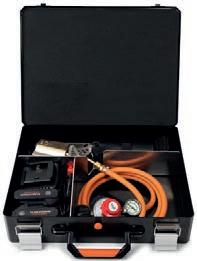
1 DONE GETTING IT FARMLANDS EVERYTHING YOU NEED SPRING FEED THIS TOP EVERYTHING TO FARM, GROW AND LIVE A RURAL LIFESTYLE! SEPTEMBER DEALS DEALS NRM Chook Tucker 20kg 1029157 BUY 2 FOR $62.00 NRM Lamb Performance 20kg 1029592 BUY 2 FOR $59.60 Promax Xpress Water Tank 25,000L 3,299.99 SAVE $1,060.01 1044828 160mm x 5mm $69.95 1002979 250mm x 6mm $194.50 1006828 400mm x 6mm $603.00 1020645 315mm x 6mm $ 421.95 1020644 Promax Xpress Water Tank 30,000L 3,999.99 SAVE $1,145.11 M18 Fuel™ Blower Kit $849.99 SAVE $119.01 1061400 Gallagher Energiser S20 Solar Portable 1.2Ha $349.95 SAVE $131.00 1020603 To see these deals and even more check out shop.farmlands.co.nz/trader or shop in-store now. FAR_10978 *Terms and Conditions apply. Special prices and offers apply for the month of September 2023 while stocks last. Product range varies by store. EVERYONE ' S WELCOME SUMMIT Xtralife 2.5mm High Tensile Wire 25kg $94.95 each 1000791 BONUS Purchase 40 coils & receive a Stoney Creek Thermoflex Jacket valued at $399.00* Men’s 1054697 / Women’s 1054698 *Price includes GST - offer valid 1 - 30 September 2023 40 coils purchased in a single transaction Offer exclusive to Farmlands - while stocks last Cydectin® Pour-On 15L $1,798.00 SAVE $362.00 • NZ dairy production trials conducted at dry off, late lactation or calving demonstrated an average increase of 4.2kg MS per cow*. • 15L comes with free Cydectin Pour-On 60ml Gun • *Find out more & calculate your potential ROI at cydectin.co.nz 1001397 A006203 New all day every day great pricing on Iplex Nexus Culverts Pipe VALUE EVERYDAY Electronic Docking Iron $2225.00 1064072 NEW *Redeem online direct with Milwaukee a Milwaukee M18 REDLITHIUM ION HIGH OUTPUT 12.0Ah Battery valued at $499 with purchase 1060430 & REDEEM*





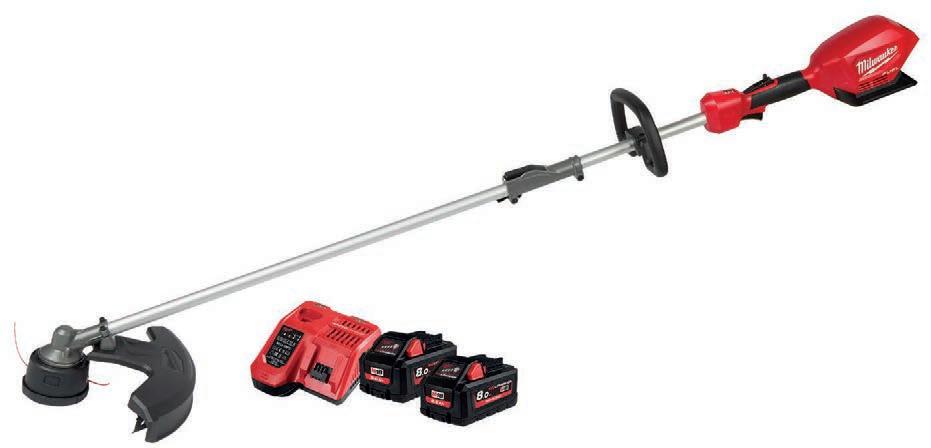






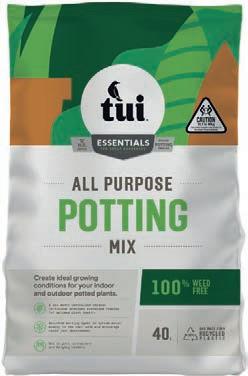


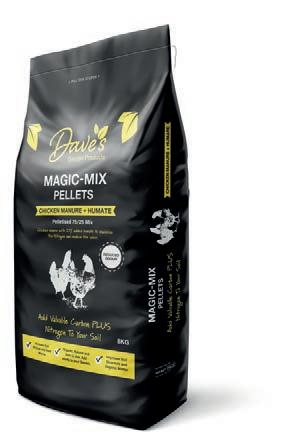




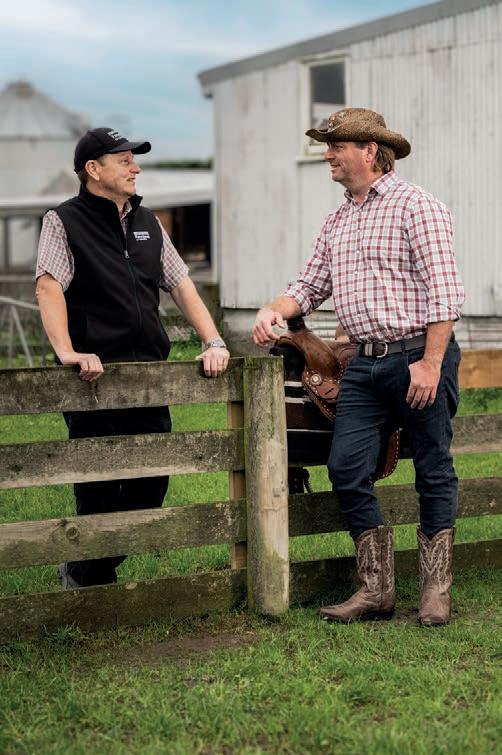
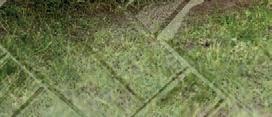
















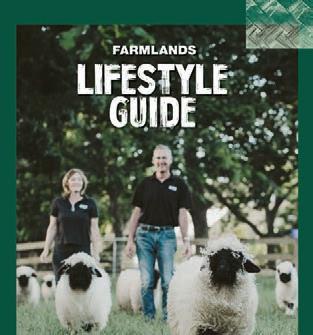
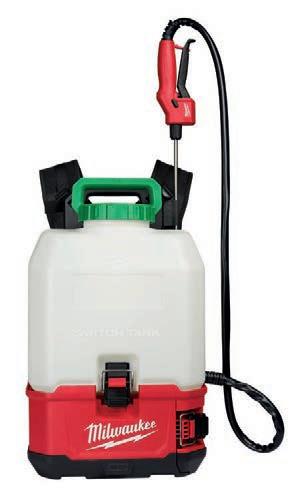




Tui All Purpose Potting Mix 40L $12.99 SAVE $2.51 1016131 Tui Compost 40L $9.99 SAVE $3.26 1009008 With All Carbon Steel Handle $49.00 SAVE $15.50 1019212 Daves Humate Biogro 8kg $18.99 SAVE $3.96 1033451 Duty D Handle $46.00 SAVE $22.95 1017161 Daves Chicken Manure and Humate Pellets 50/50 8kg $18.99 SAVE $3.96 1033453 *Redeem online direct with Milwaukee *Redeem online direct with Milwaukee Milwaukee M18 Fuel™ Blower (Tool Only) Valued at $484 When you buy an M18 Fuel Outdoor Powerhead with Line Trimmer 1060499 a Milwaukee M18 5.0Ah REDLITHIUM-ION Starter Pack valued at $474.00 with purchase 1060460 & REDEEM* & REDEEM* Block SPRING Set your up for Milwaukee M18 Fuel™ Outdoor Powerhead with Line Trimmer Kit $999.99 1061401 Gallagher 4 Wire Smart Fence 100m $379.95 1008606 Portable, instant, all-in-one electric fence system Going Spring Garden SORTED Get your Get FOR to WIN Be in Get your Ryeclover Pre-mix From Farmlands Buy any two inputs of Seed, Ballance Fertiliser or AgChem from Farmlands this spring and you could win one of three trips to the Calgary Stampede July 2024! Minimum spend $2,000. Our perennial ryegrass is mixed with an Italian ryegrass (for good spring growth) and a clover to boost protein and assist with N-fixation for ongoing persistence. Available in 5kg, 10kg or 25kg bags. Contact Farmlands for a cost-effective pre-mix seed solution: Pre-mix Dairy Elite AR1 Pre-mix Sheep & Beef Pre-mix Horse Pedigree Various proprietary pre-mix options available A TRIP TO THE CALGARY STAMPEDE Purchase today through your Farmlands store or TFO. *Terms and conditions apply. Scan the QR code to learn more! Block Success Set your up for Check out our Lifestyle Guide Everything you need to know about keeping animals on your block. Perfect for clearing thick brush Scan the QR code for more on perennial ryegrass M18™ Switch Tank™ 15L Backpack Chemical Spray with Powered Base 599.99 SAVE $65.01 1063561















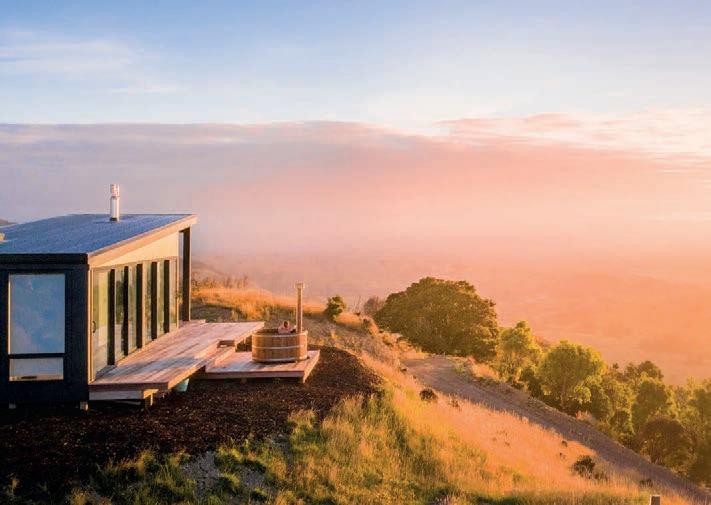







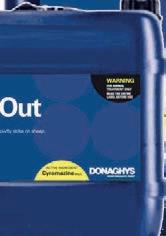




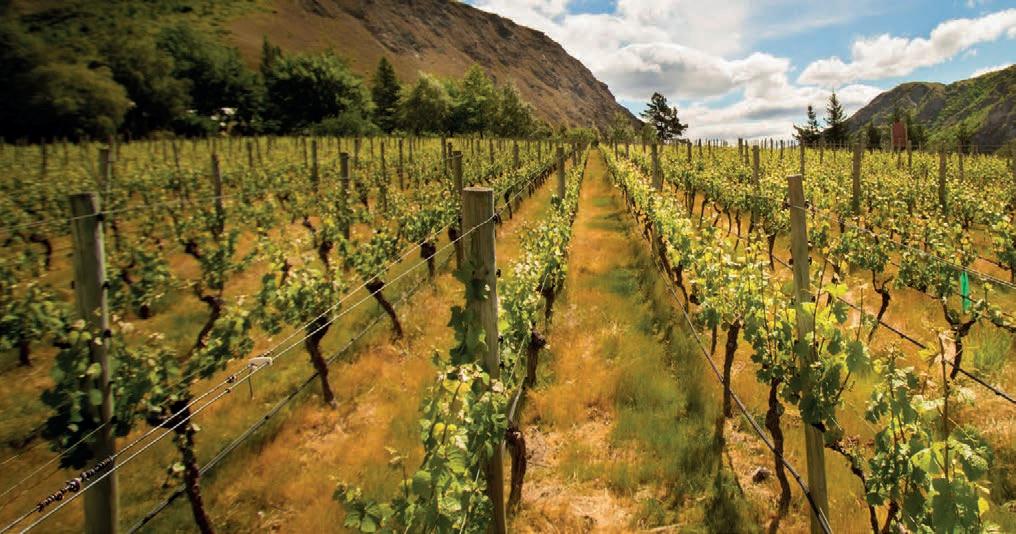









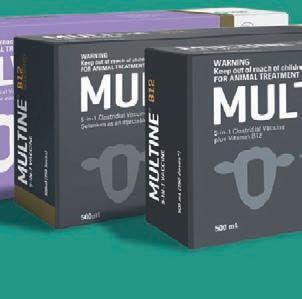











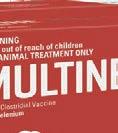


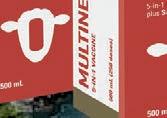

Visit our Card Partner Directory to find out where to use your card cardpartners cardpartners.farmlands.co.nz Featured Offers CARD PARTNERS 1234 5678 9012 3456 AM CARD HOLDER 123456789 To see these deals and even more check out shop.farmlands.co.nz/trader or shop in-store now. *Terms and Conditions apply. Special prices and offers apply for the month of September 2023 while stocks last. Product range varies by store. EVERYONE ' S WELCOME Spring Action! into Get a FREE property appraisal and be in to win* 1 of 5 luxury accommodation prizes. WIN a Canopy Camping escape! *T&Cs Apply Licensed REAA 2008 Canopy Camping Escapes Head into your nearest Farmlands to see the Donaghy's range. Single active liquid dip for sheep containing cyromazine. Ideal for lambs at docking/tailing. Provides up to 6 weeks’ protection against flystrike. 20L 1019683 | A009952 10L 1019682 | A009952 Donaghys StrikeOut Spray-On BUY 40L & GET A FREE DRAW TUBE PACK. $148.00 $278.00 10L 1047252 | A011205 10L 1047226 | A011744 Donaghys TrivAL Tape HiMin Donaghys TwinAL Tape HiMin • Using a triple active drench product prolongs the effectiveness of all drench families. Ideal drench for young lambs around weaning. • Double active sheep oral with a short 14 day meat withhold. Ideal drench for young lambs around weaning. $ 498.00 $ 398.00 WIN A trip for 5 to Queenstown thanks to Multine 5 in 1 ! Purchase 10 or more Multine and Nilvax vaccines during September and October and you’re in the draw*! Prize pack includes: Your choice of either a Wine & Dine OR Avid adventurer holiday package. *Terms and conditions apply. A000934, A003977, A000935, A011311, A011766 Farmlands shareholder exclusive offer for your home or farm $350 joining credit per connection* 5 year fixed rate plan Including network charges* *Terms and conditions apply. meridianenergy.co.nz/agribusiness/rural-supplier-offers/farmlands Request a quote





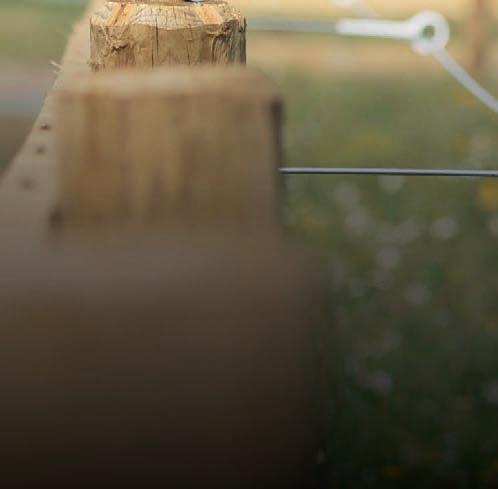














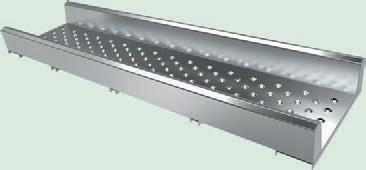
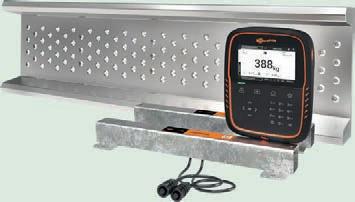


To see these deals and even more check out shop.farmlands.co.nz/trader or shop in-store now. *Terms and Conditions apply. Special prices and offers apply for the month of September 2023 while stocks last. Product range varies by store. Visit your local Farmlands store or talk to your Farmlands TFO today. HR4 Hand Held Reader 1055539 G03306 $1099.99 SAVE $339.01 W-0 Weigh Scale + 1.5T Loadbars 1052285 G00027 $1799.99 SAVE $326.02 Aluminium Cattle Weigh Platform 2.2m x 605mm 1048355 G05804 $1299.99 SAVE $162.01 TWR-1 Weigh Scale + 1.5T Loadbars + 2.2m Platform 1057807 G00087 $4599.99 SAVE $720.01 Wood Post Heavy Duty Tape Insulator 25pk 1007128 G66910 $00.00 SAVE $00.00 Wood Post Corner Strain Tape Insulator 5pk 1004255 G67012 $49.95 SAVE $9.00 PERMANENT EQUINE FENCING A Safe Fence to Save your Horse Reduced risk of animal injury Superior shock Increased conductivity Wood Post Wide Jaw Claw Insulator White 25 Pack 1047014 Black 25 Pack 1035915 $39.95 $39.95 SAVE $10.55 SAVE $7.00 SAVE $12.55 Equine Fence Wire EquiFence™ White 250m 1049275 Brown 5,000m 1048303 $359.95 $359.95 SAVE $72.00SAVE $72.00 Ring Top Offsets Side Mount 5 Pack White 175mm 1036888 White 400mm 1036889 Brown 400mm 1048302 $15.95 $18.95 $18.95 SAVE $3.30 SAVE $5.00 SAVE $5.55 Ring Top Offsets Top Mount 5 Pack White 250mm 1036891 White 400mm 1036894 Double End 800mm 1036895 $17.95 $18.95 $39.95 SAVE $4.00 SAVE $5.00 SAVE $7.00 Insulated End Strainer 1022796 G74313 $6.95 SAVE $1.00 40mm Poly Tape 200m 1001951 G62404 $249.95 SAVE $59.55 Insulated Line Post 10 Pack 1140mm 1023152 1350mm 1023153 $149.95 $179.95 SAVE $54.00 SAVE $61.55 Metal Plate 10 Pack for Wood Post Corner Strain Tape Insulator 1026551 G67090 $94.95 SAVE $16.00 Hit Your Targets Every Time Daily gains Report results Comply with NAIT UP-TO-DATE GALLAGHER STAY WITH




















































































 Hugh Stringleman MARKETS Dairy
Hugh Stringleman MARKETS Dairy





















































































 Sam
Sam




















































































 Malcolm Bailey AgResearch
Malcolm Bailey AgResearch































































































































































































 Fiona Quarrie MARKETS Livestock
Fiona Quarrie MARKETS Livestock






























































































































































